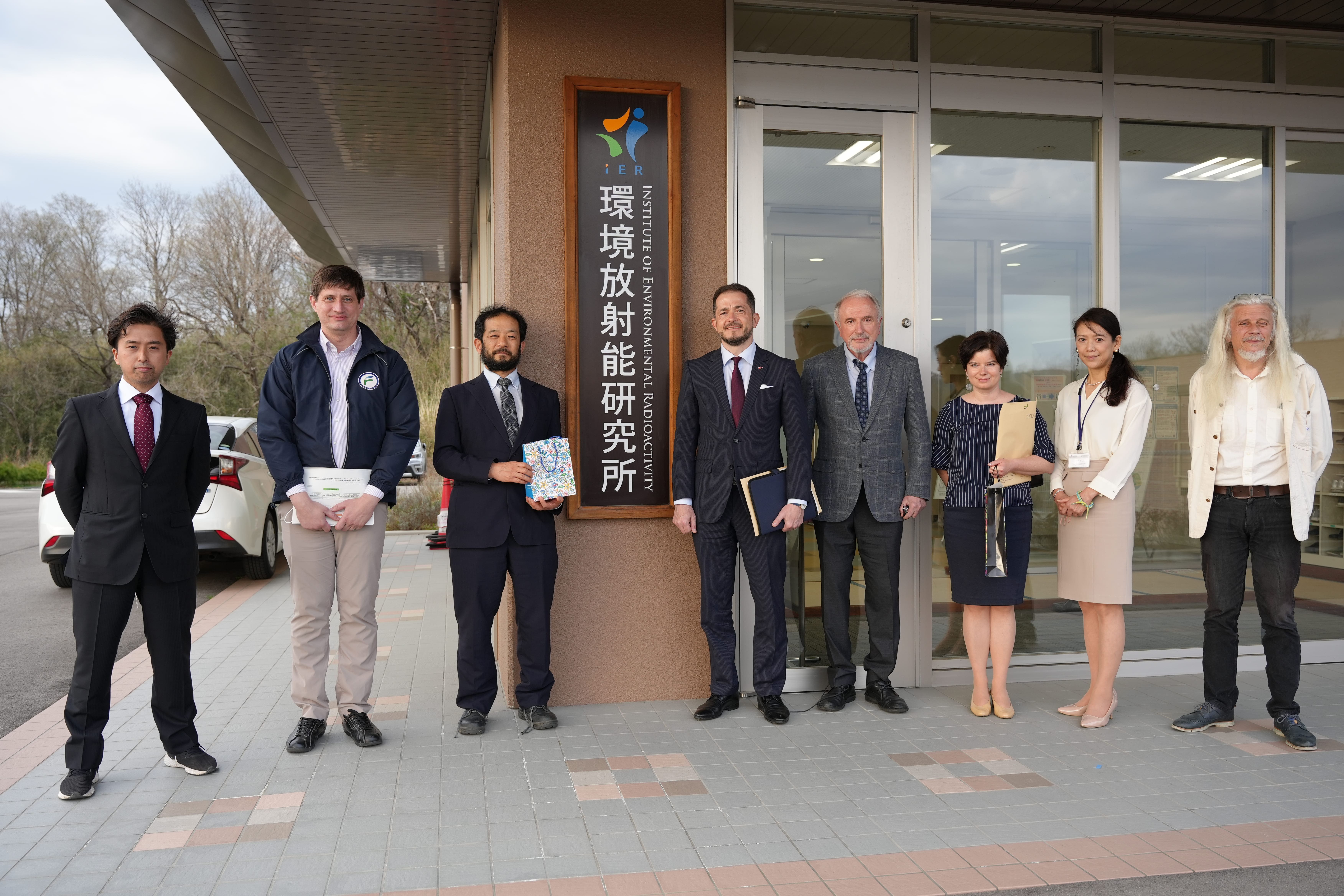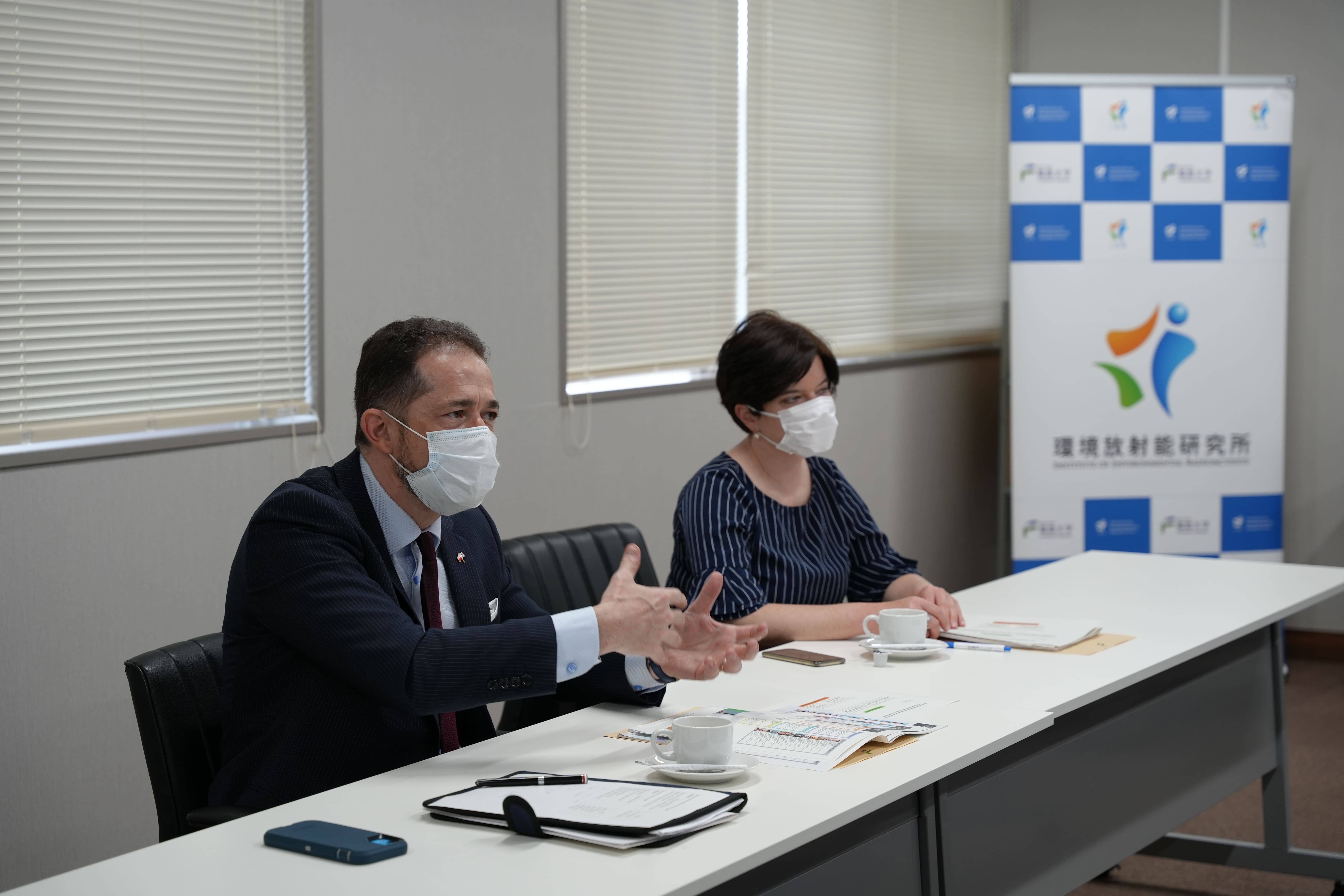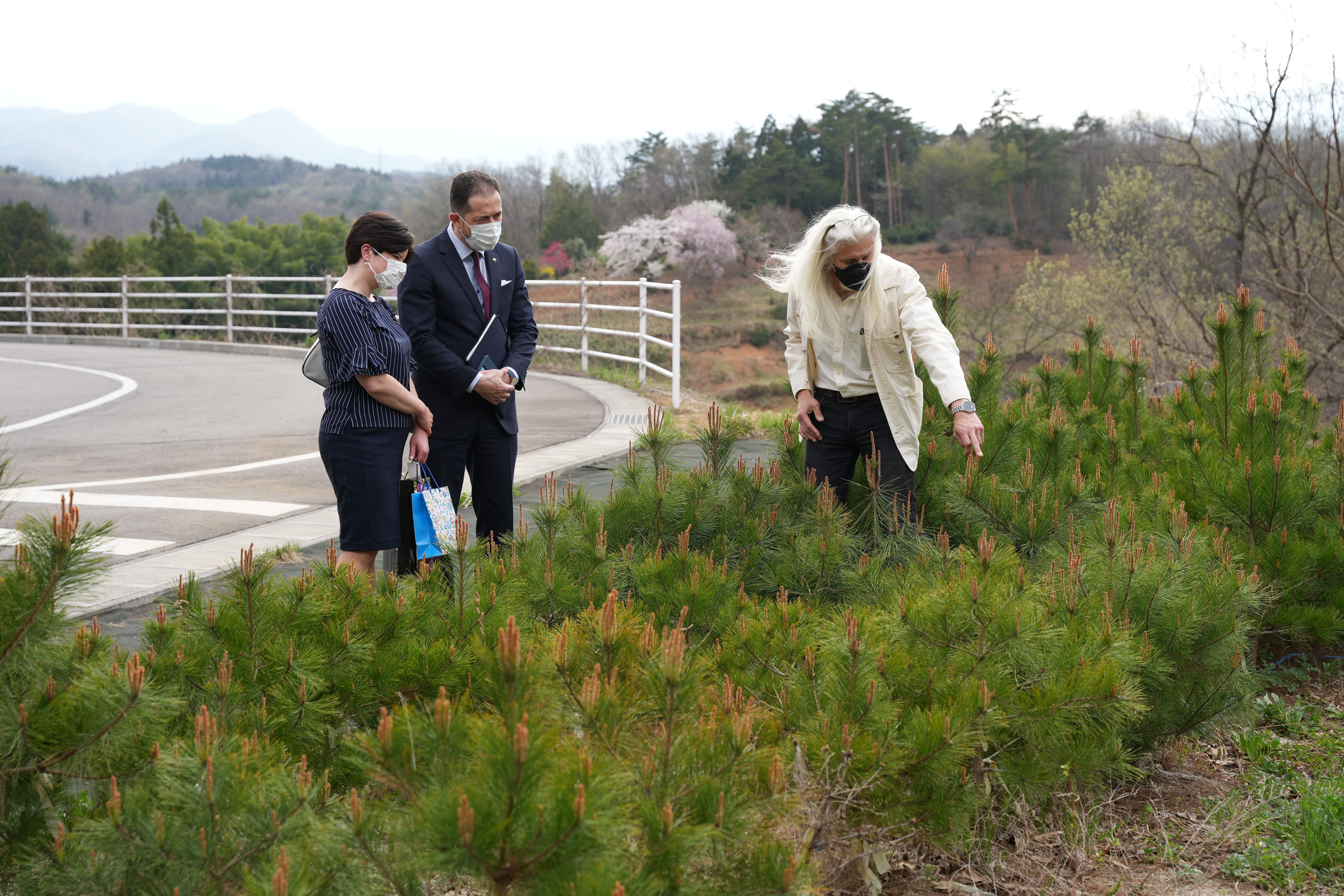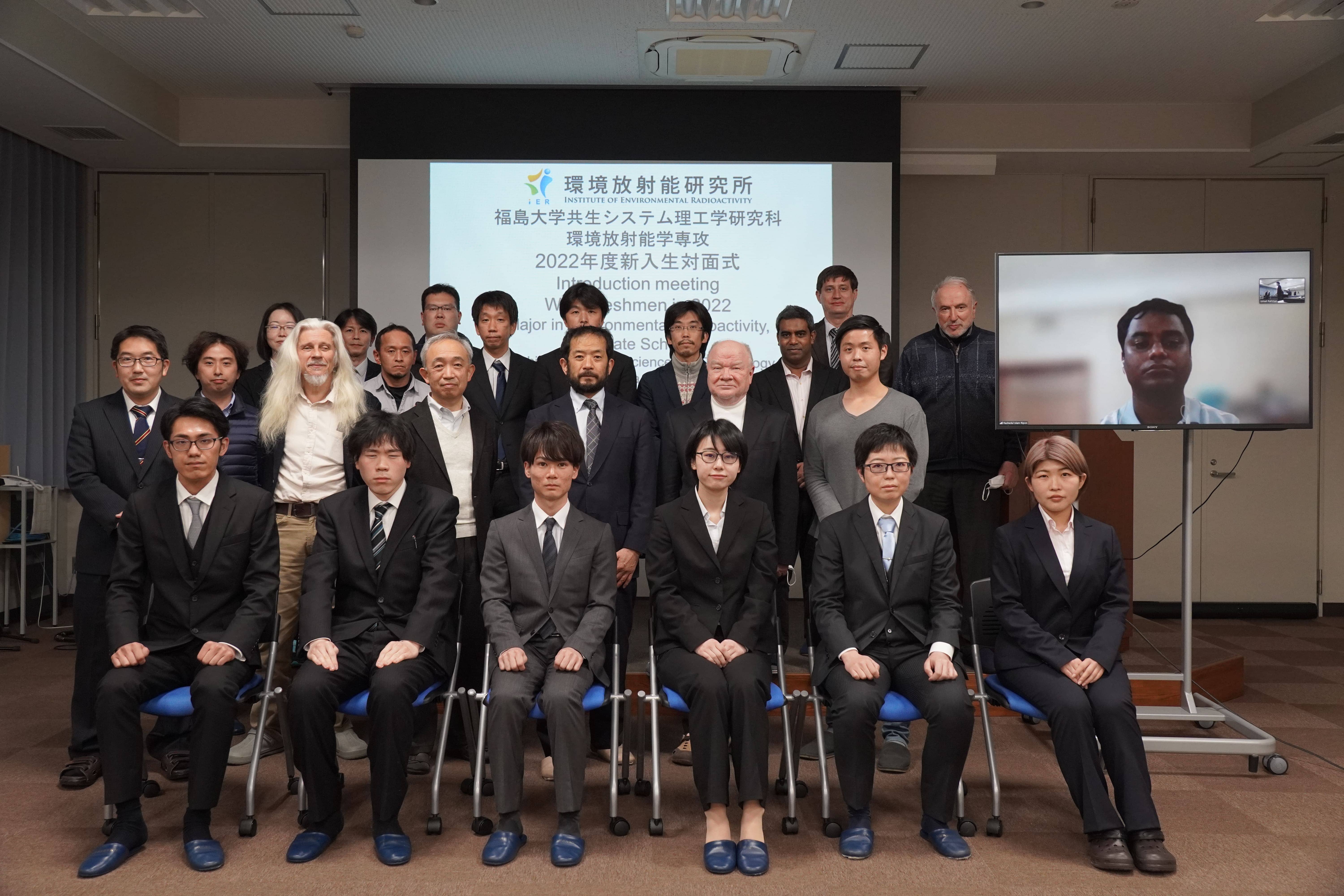IER Activity Log 2022
February 13 & 14, 2023 We held the 9th Annual Symposium
The IER holds an Annual Symposium every year to report research results to the general public and experts and to exchange opinions. The 9th Annual Symposium was held on February 13 and 14 under the theme of "Environmental Radioactivity: New Frontiers" as a hybrid of onsite and online sessions. The first day was held jointly with the 2022 ERAN Annual Meeting. We received many registrations and a total of approximately 410 people attended for two days for the Oral and Poster presentations for experts and the Symposium for the General Public.
For more details, please click here.January 30, 2023 The 9th IER seminar was held. <Project Senior Assistant Professor Ishiniwa and Project Professor Konoplev>
| Date & Time: | January 30, 2023 14:00~15:00 |
| Speaker: |
Project Senior Assistant Professor, ISHINIWA Hiroko Project Professor, Alexei KONOPLEV (Presentation order) |
| Presentation title: |
Genomic analysis of radiation effects on field mice in the difficult-to-return zone.(Ishiniwa) Seasonal variations of radiocesium (r-Cs) in aquatic environment and their mechanisms.(Konoplev) |
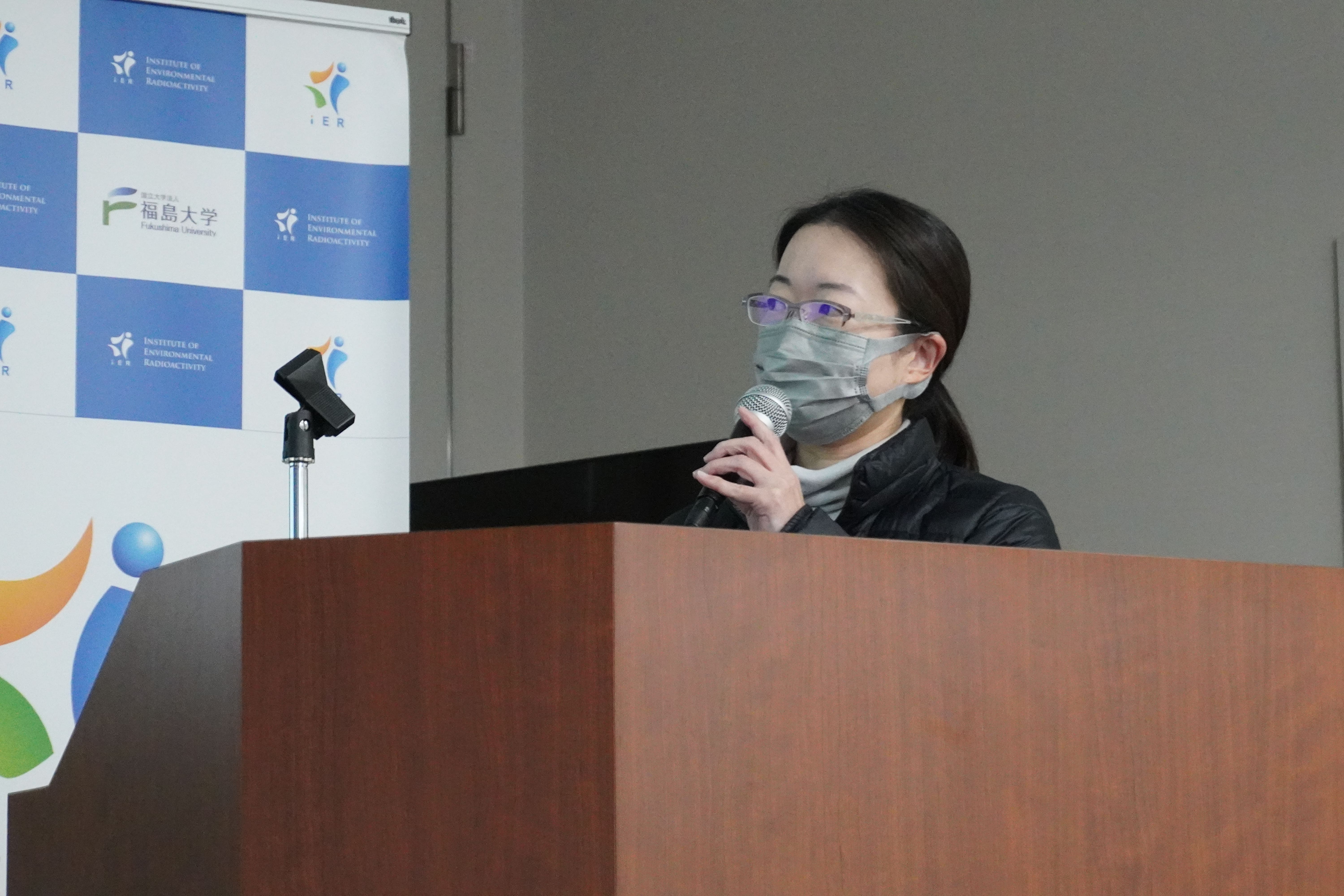 Project Senior Assistant Professor ISHINIWA Hiroko
Project Senior Assistant Professor ISHINIWA Hiroko
Institute of Environmental Radioactivity (IER) regularly holds the IER seminar in which the faculty members report on their research results, with the aim of facilitating their research activities and promoting communication.
In the 9th IER seminar of this fiscal year that held on January 30, 2023, two researchers gave presentations on their research activities and results. The seminar was attended by 29 researchers and students.
The first presentation was given by Project Senior Assistant Professor Ishiniwa. Radiation induces DNA mutations. Since the location of mutations is considered to be random and with no regularity, it is necessary to examine the entire genome to truly assess the effects of radiation on the DNA of organisms, but it is expensive and difficult to analyze all of the genome. There are also problems in data analysis: genome size varies among animal species, and genome sequence information on wildlife is fragmented, unintegrated and difficult to handle.
In order to clarify the effects of radiation on field mice living in the difficult-to-return zone, we have studied a method to extract and analyze only those gene regions from the genome that have functions related to the survival of the organisms.
Project Professor Konoplev presented a talk on Seasonal variations of radiocesium (r-Cs) in aquatic environment and their mechanisms.
He showed some research results for the Chornobyl NPP cooling pond, Glubokoe lake in Chernobyl exclusion zone and oligotrophic lake Vortsee in Germany, as well as for the Okuma ponds, Abukuma River and data for some other rivers of FDNPP contaminated area published by Nakanishi and Sakuma (2019). For all water bodies it was found that activity concentration of dissolved r-Cs in summer is essentially higher than in winter.
It was suggested that there are two basic mechanisms responsible for regular seasonal variations of dissolved Cs in water bodies: 1) increase of desorption rate due to increase of water temperature, and 2) generation of ammonium as a result of organic matter decomposition in anoxic conditions.
In Fukushima rivers, which are mostly shallow and fast flowing, ammonium concentration is usually negligible. For them the predominant factor of dissolved r-Cs seasonality is temperature dependence of r-Cs desorption. For stagnated stratified waters of ponds, lakes and dam reservoirs in anoxic conditions, the role of ammonium in r-Cs mobilization can be comparable with that of water temperature or even be prevailing.
After the presentation, various questions and opinions were exchanged among participants.
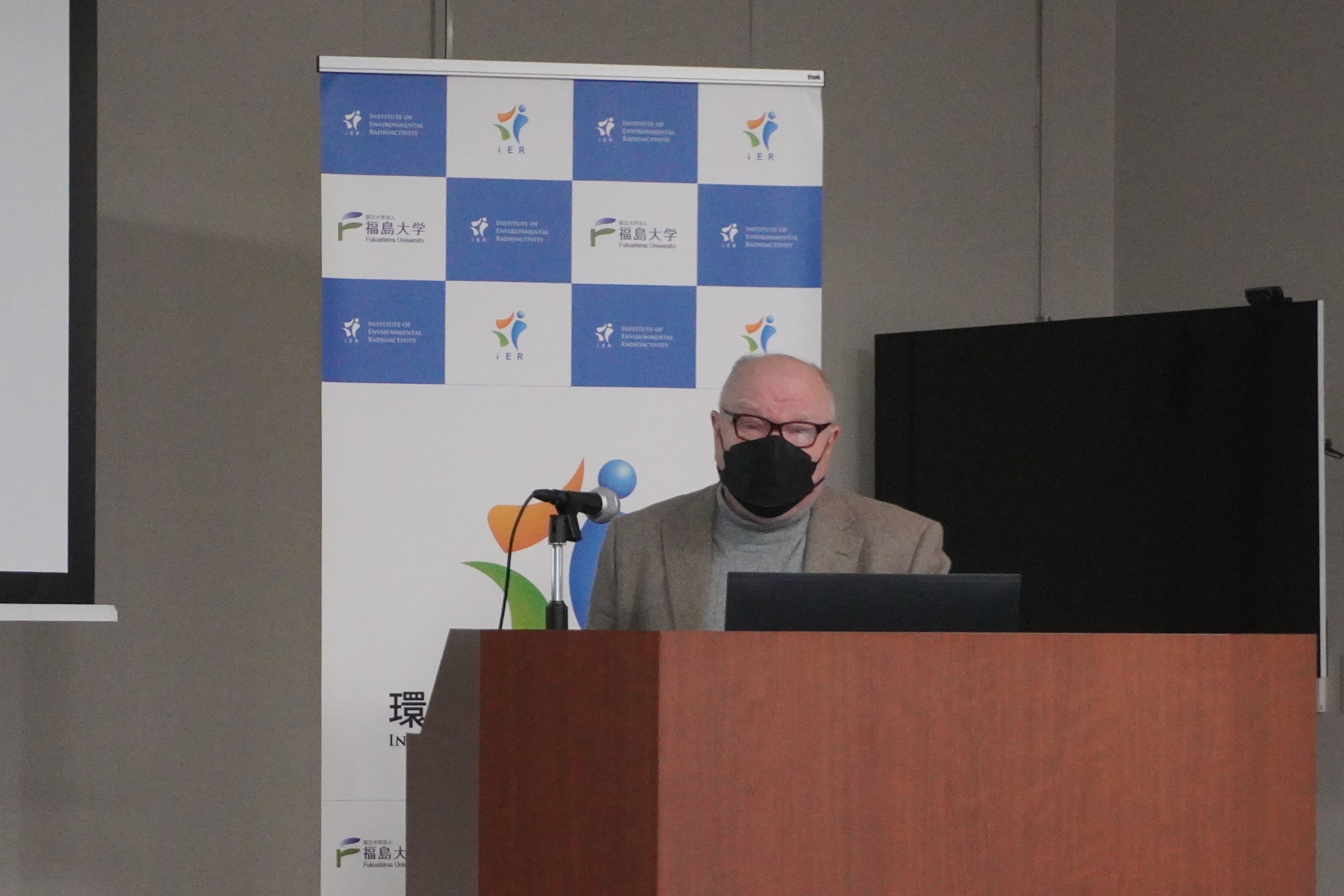 Project Professor Alexei KONOPLEV
Project Professor Alexei KONOPLEV
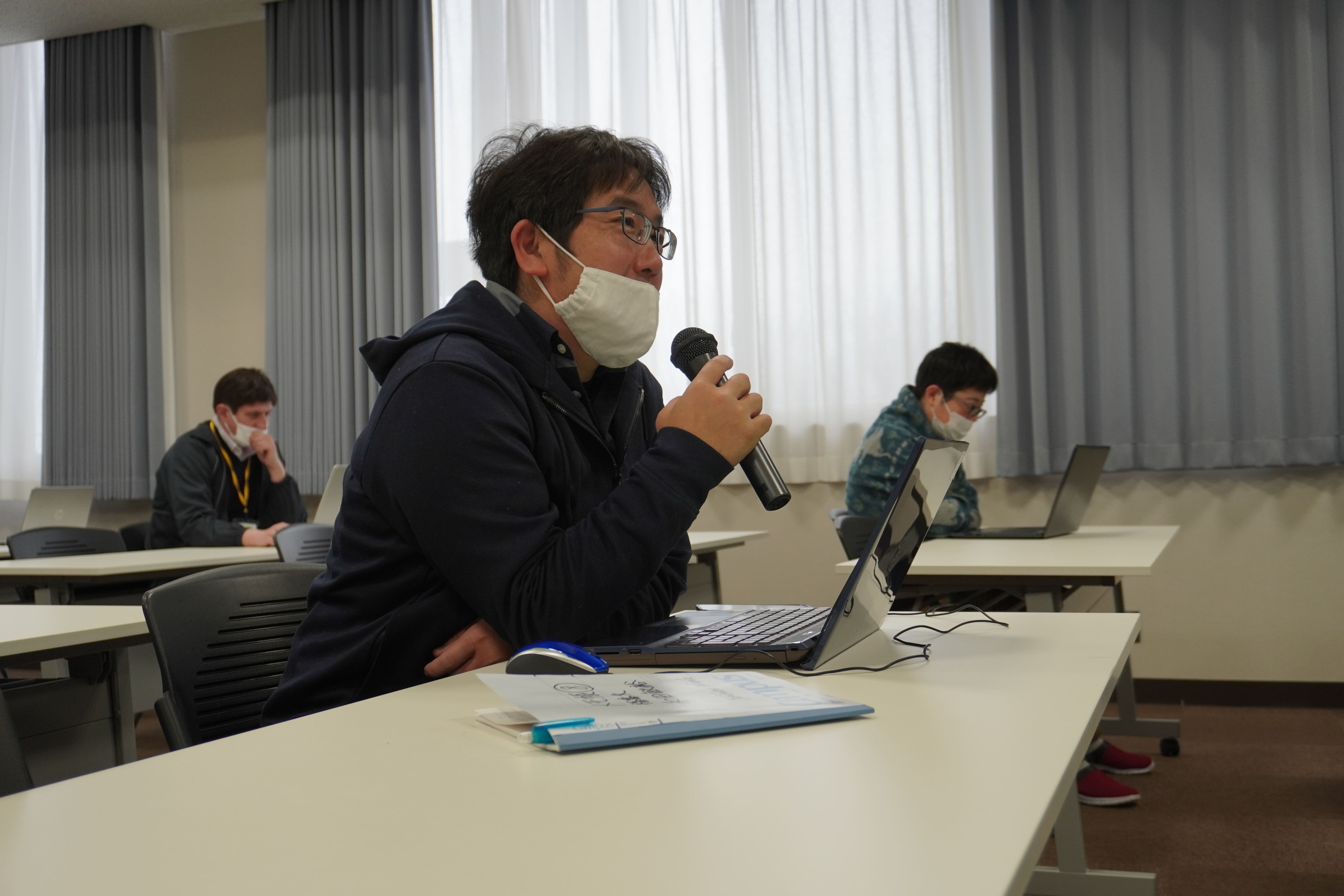 Questions and answers time
Questions and answers time
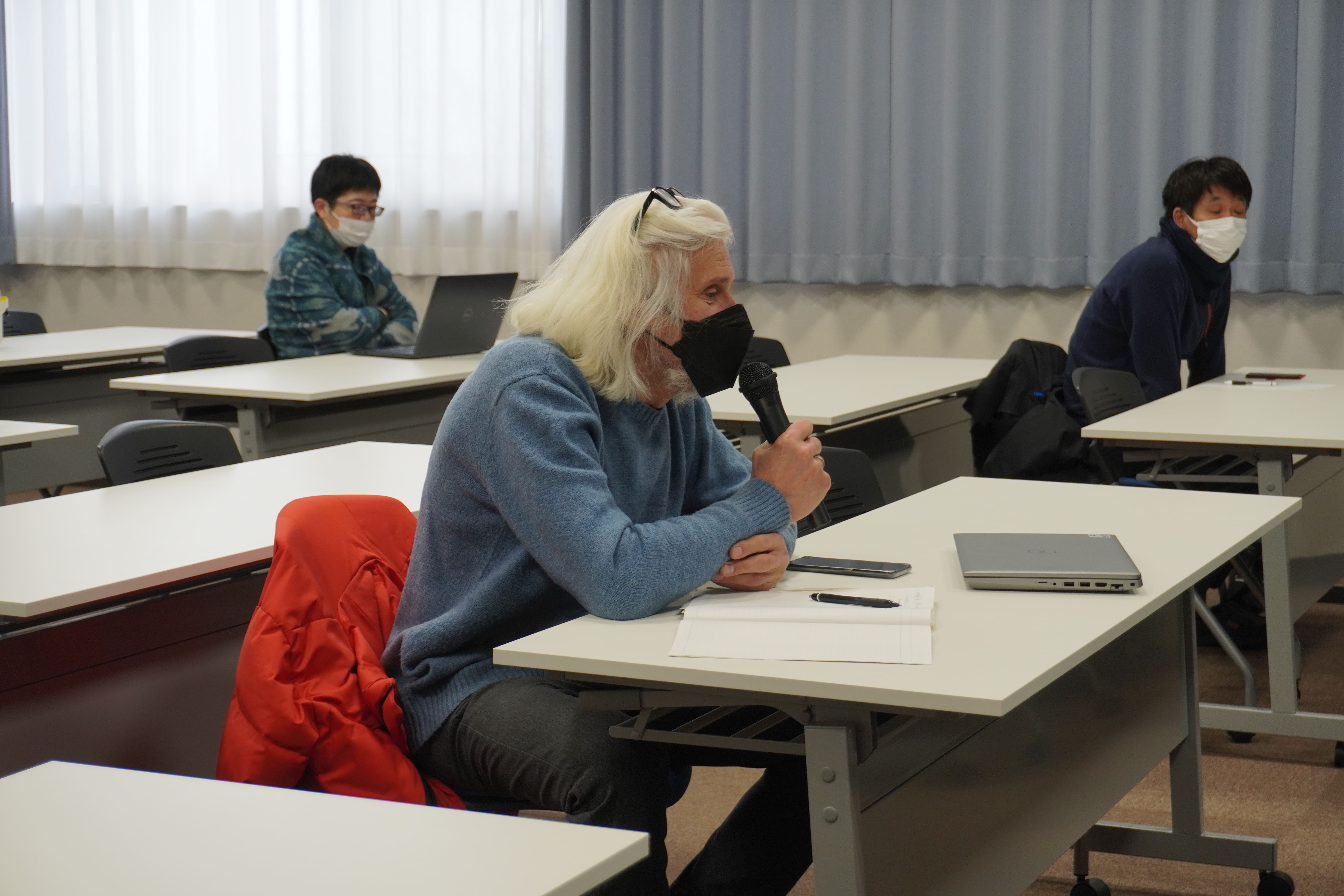 Questions and answers time
Questions and answers time
December 26, 2022 The 8th IER seminar was held.<Project professor TORII, Associate professor RAHMAN, Professor YOSCHENKO>
| Date & Time: | Monday, November 28, 2022, 14:00~16:00 |
| Speaker: |
roject professor, TORII Tatsuo Associate professor, Ismail RAHMAN Professor, Vasil YOSCHENKO (Presentation order) |
| Title: |
A New Concept Radiation Imager as a 3rd Gen. Gamma Camera [FRIE Detector] (Torii) Does open-beach ship-breaking affect the activity concentrations of terrestrial radionuclides in soil ? (Rahman) Root uptake of radiocesium into conifers in Fukushima forests and radioiodine into crops in field experiments in Chornobyl(Yoschenko) |
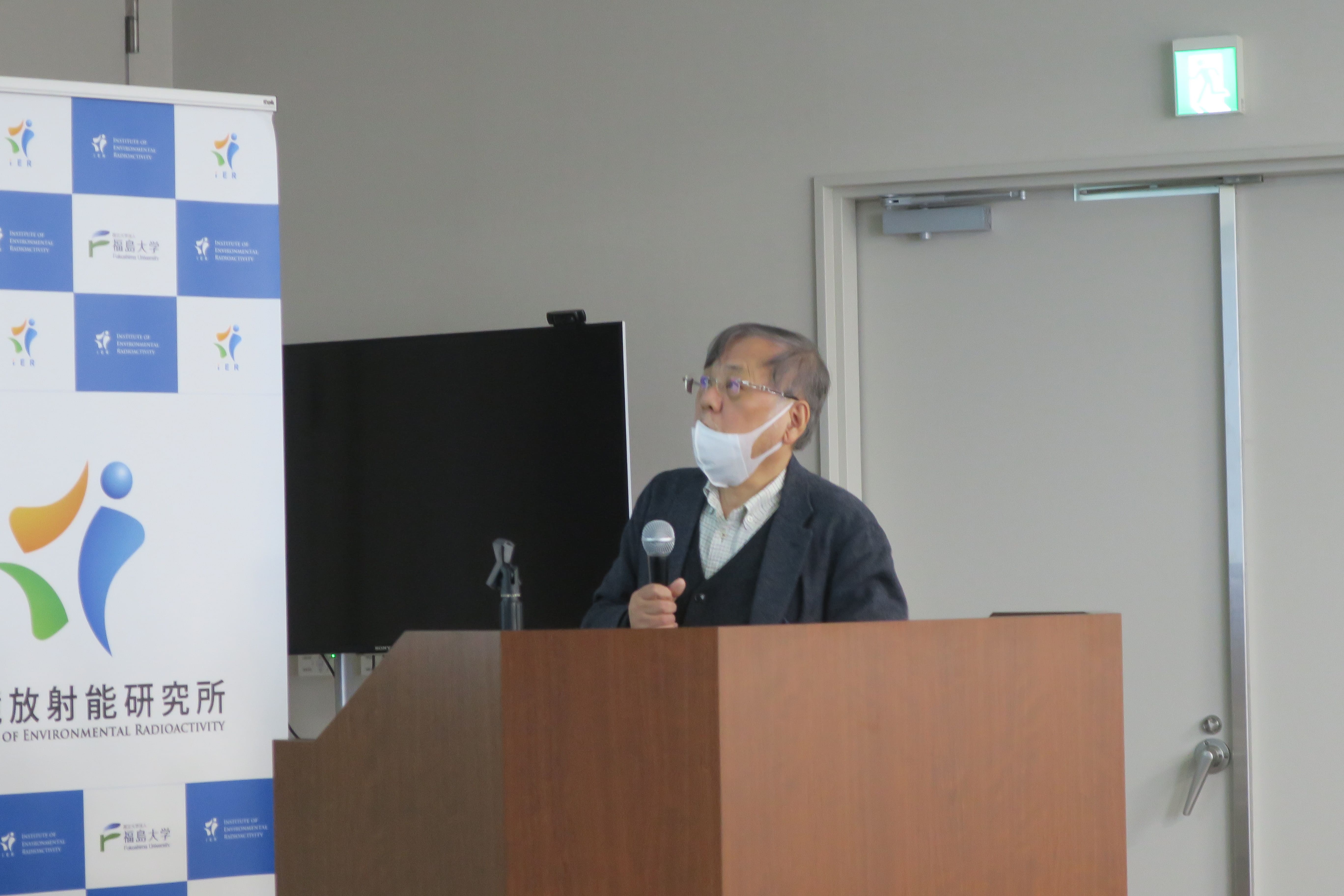 Project professor, TORII Tatsuo
Project professor, TORII Tatsuo
Institute of Environmental Radioactivity (IER) regularly holds the IER seminar in which the faculty members report on their research results, with the aim of facilitating their research activities and promoting communication. In the 8th IER seminar of this fiscal year that held on December 26, 2022, three researchers gave presentations on their research activities and results. The seminar was attended by 26 researchers and students.
Project Professor Torii presented about the development of a radiation distribution visualization tool based on a new concept. In this context, the radiation measuring instruments with a fractal structure, named FRIE, which provide a three-dimensional distribution of the radiation source, were explained. In the difficult-to-return zone, field measurement tests were carried out to determine the three-dimensional radiation distribution. Currently, he is developing a second unit that can handle on-site measurements, and are aiming for simultaneous all-round beta and γ-ray imaging that can be applied to environmental restoration and decommissioning in Fukushima, as well as various other fields.
Associate Professor Rahman presented the "Effects of open-beach ship-breaking on the activity concentrations of terrestrial radionuclides in soil." The report shared data from collaborative research conducted with researchers from the University of Chittagong, Bangladesh. The joint research initiative aims to (a) evaluate the spatio-temporal distribution of terrestrial radionuclides in soils and (b) assess potential health risks from terrestrial radionuclides in soils. The research was conducted because the distribution of natural radionuclides and radiation levels in the environment is essential for assessing the effects of radiation exposure on human beings due to terrestrial and extra-terrestrial sources. Therefore, the spatio-temporal distribution of U-238, Th-232, and K-40 activity concentrations in soils exposed to open-beach ship-breaking activity was evaluated, and potential health risks were assessed. The report concludes that open-beach ship-breaking does not increase the activity concentrations of terrestrial radionuclides in soil. In contrast, a suppressing impact can be assumed.
Professor Yoschenko presented recently published results of studies on root uptake of radiocesium into conifers in Fukushima forests and radioiodine into crops in field experiments in Chornobyl. Both studies indicate a significant dependence of the uptake of these radionuclides on the content of exchangeable forms of competing ions in the soil, potassium and stable iodine, respectively. The results of current studies of the variability of radionuclide concentrations in wood at the stand scale in Chornobyl and Fukushima and effect of tree age on the radial distributions of 90Sr and 137Cs in pine and birch trees in the Chornobyl Exclusion Zone were also discussed.
After each presentation, IER faculty members gave the presenters various questions and comments.
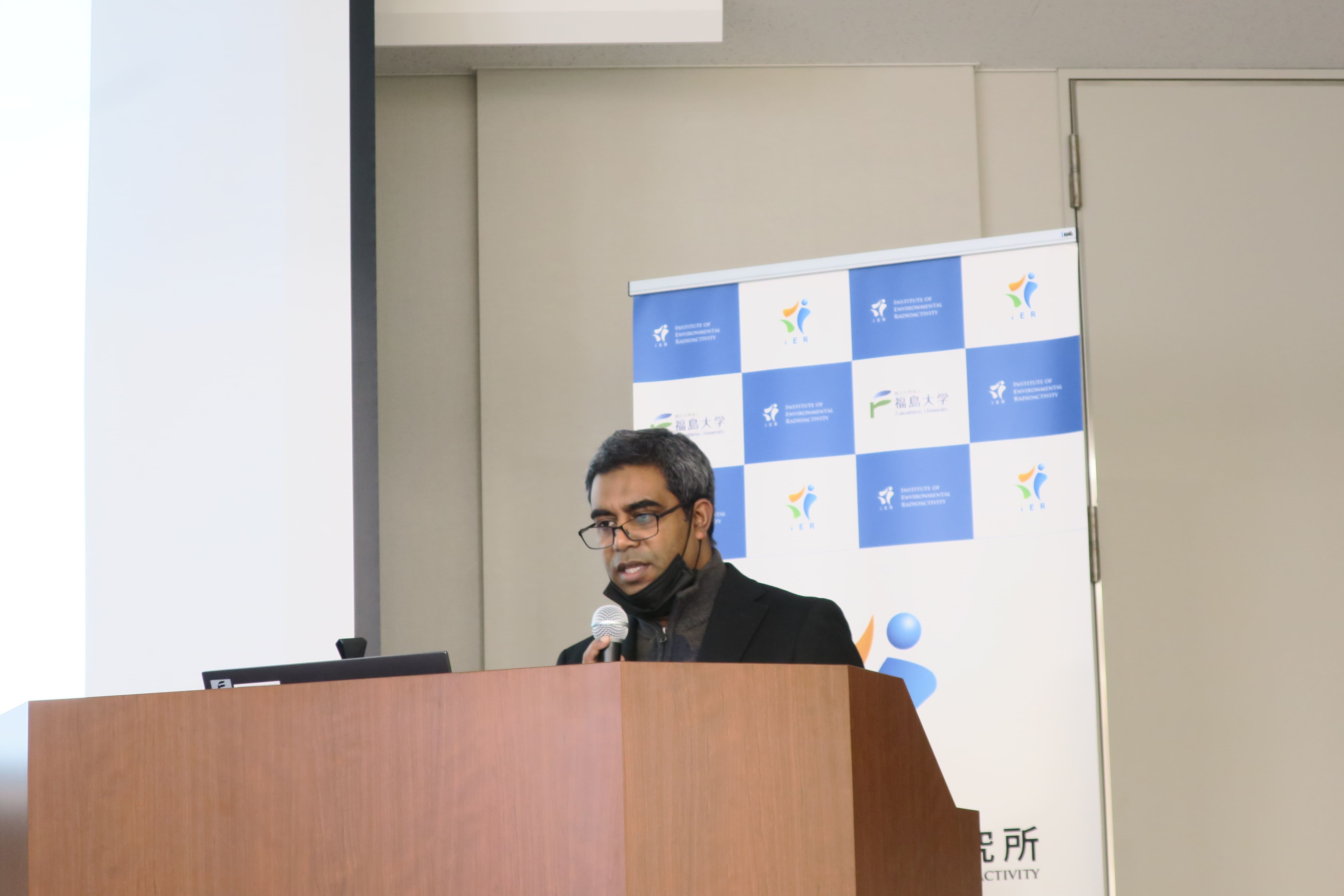 Associate professor, Ismail RAHMAN
Associate professor, Ismail RAHMAN
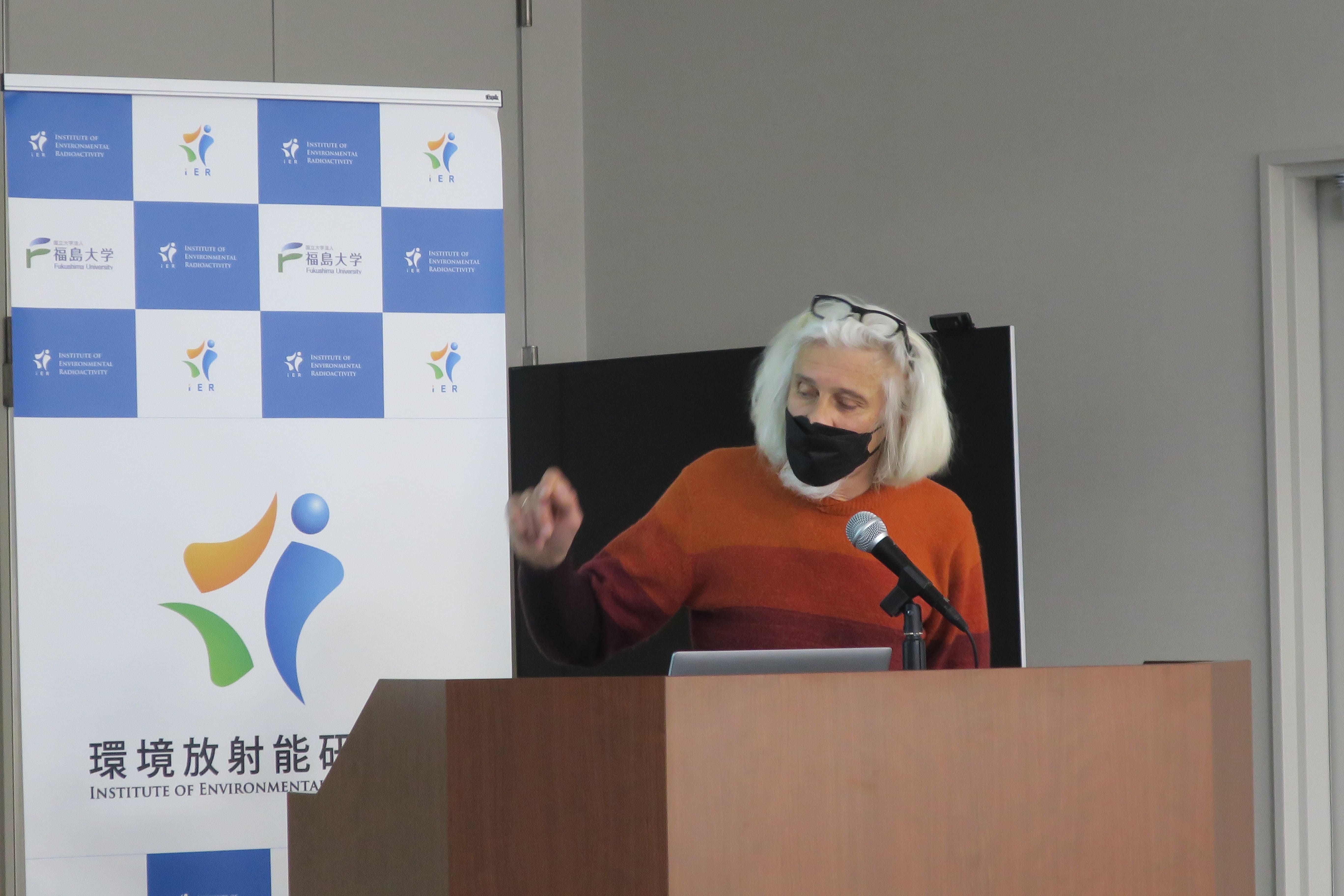 Professor, Vasil YOSCHENKO
Professor, Vasil YOSCHENKO
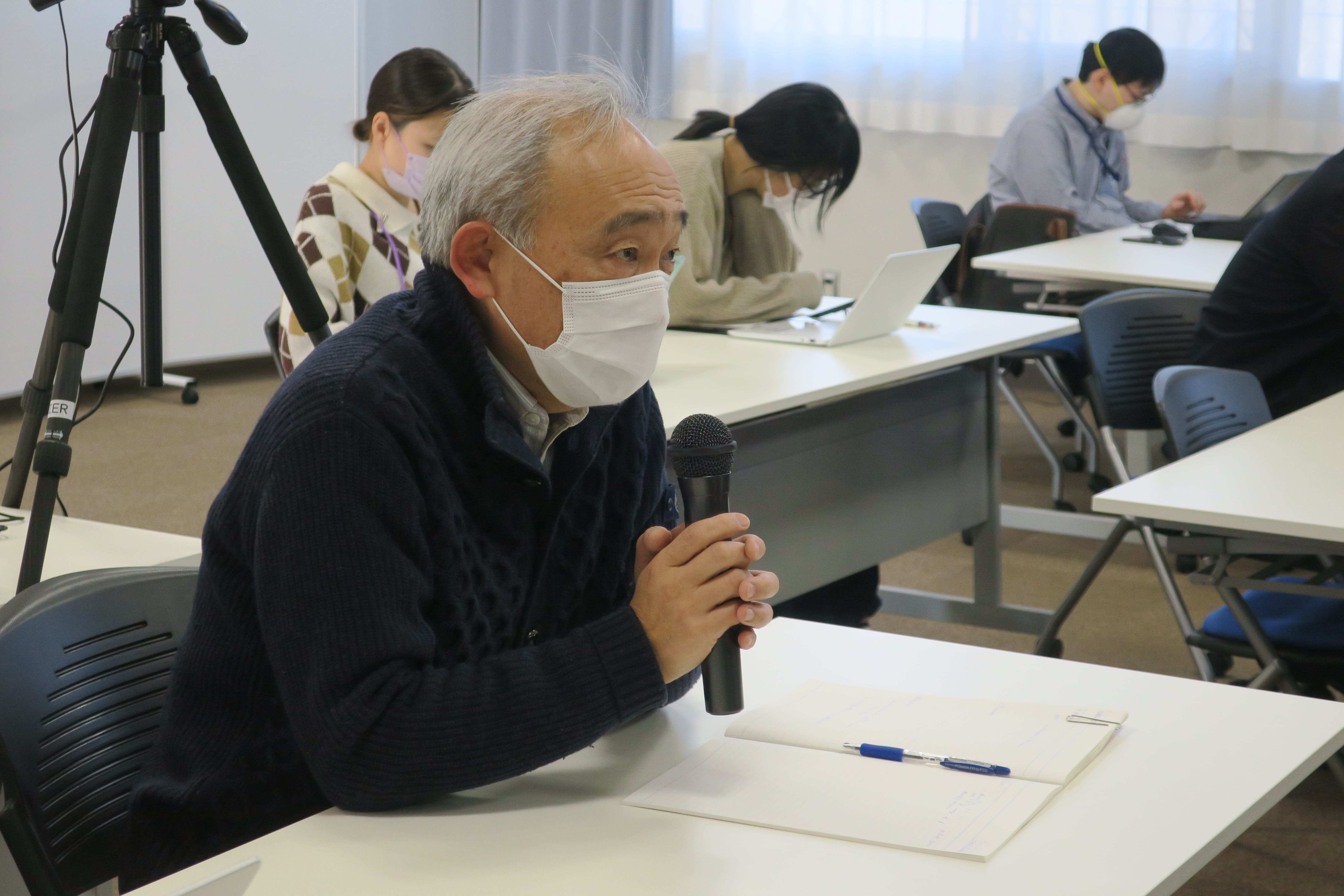 Question and answer time
Question and answer time
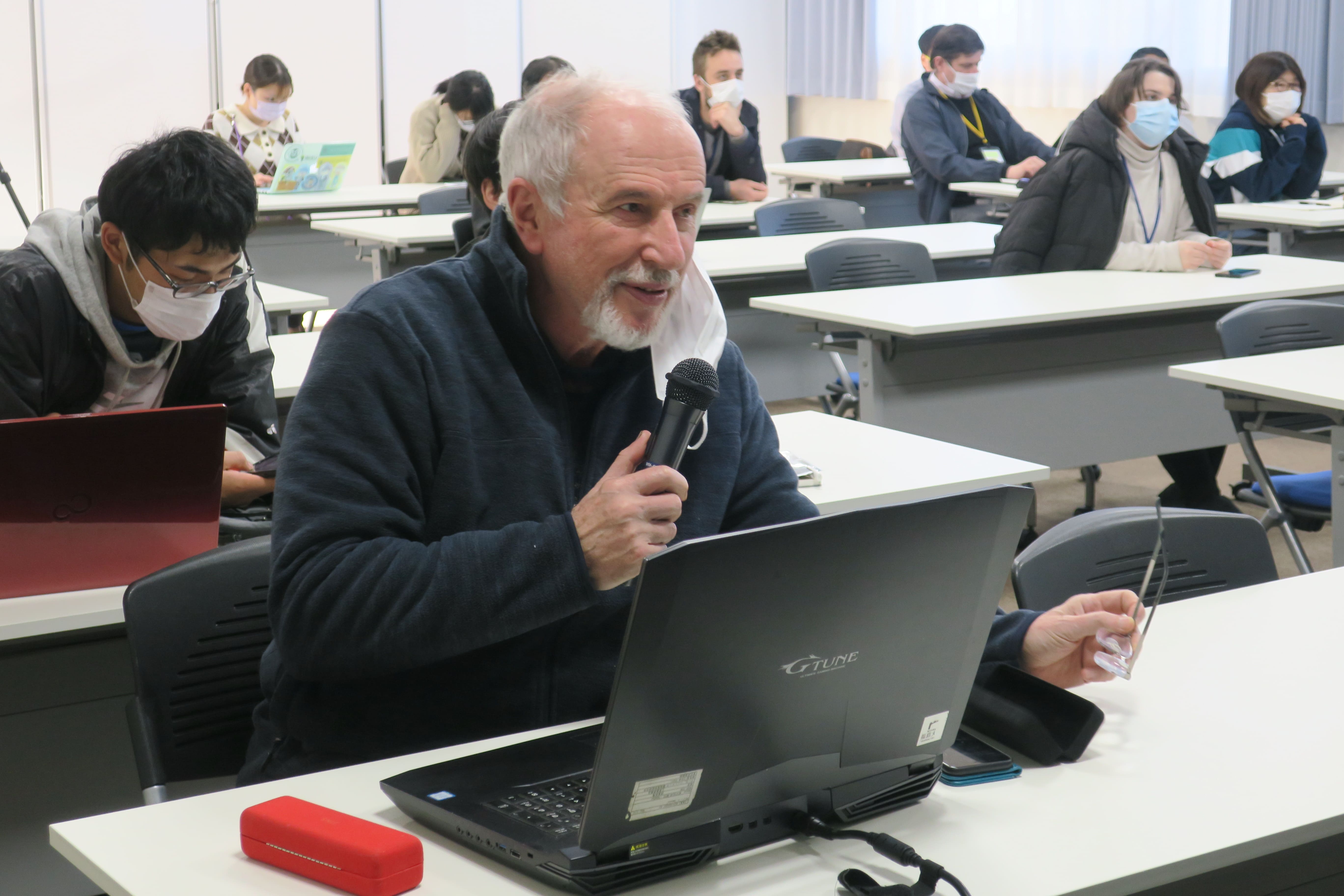
February 21st, 2023 We held the 11th IER Seminar of FY2022. <Graduate students>
| Date & time: | February 21st, 2023, 2:00pm-4:00pm |
| Topic: |
1) Estimation of annual Cesium-137 influx from the FDNPP to the coastal water nearby (SATO Shun: 1st year M.S. student, Major in Environmental Radioactivity) 2) Elucidation of 137Cs transfer processes in terrestrial and aquatic ecosystems in the difficult-to-return zone (YAMAGUCHI Daisuke: 1st year M.S. student, Major in Environmental Radioactivity) 3) Influence of Fukushima Dai-ichi Nuclear Power Plant accident, explored with land transaction data on municipalities in Fukushima Prefecture (SHOJI Nobutoshi: 2nd year M.S. student, Major in Environmental Radioactivity) 4) The dynamics of H-3 and Cs-137 in marine biota around the Rokkasho Reprocessing Plant, and on-going research at Fukushima (OHTSUKI Satoru: 1st year PhD student, Major in Environmental Radioactivity) |
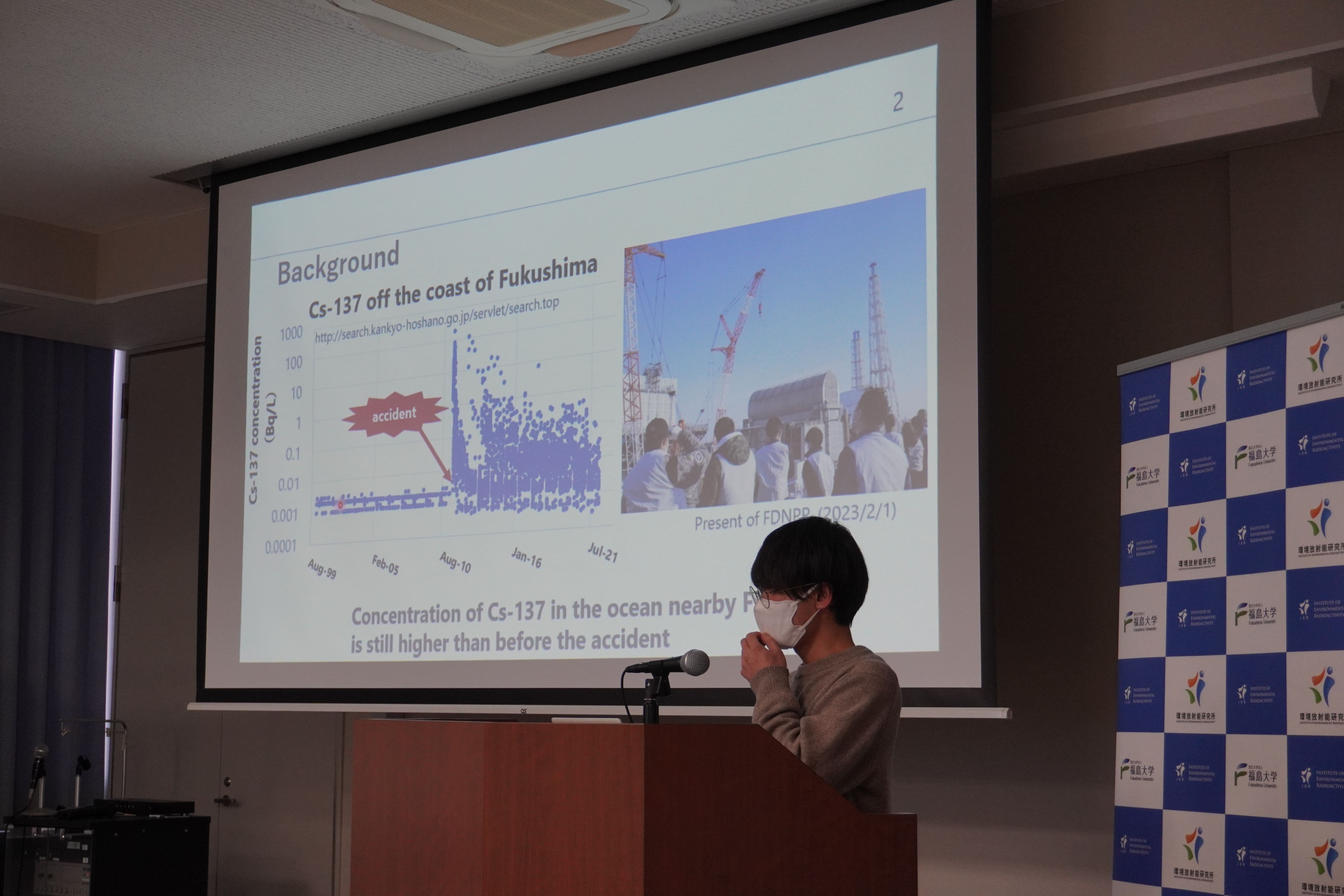 SATO Shun
SATO Shun
Institute of Environmental Radioactivity (IER) regularly holds the IER seminar, in which the faculty members report on their research results, with the purpose of facilitating their research activities and communication.
The 11th IER seminar was held on February 21, with 19 attendees. Three PhD and one M.S. students from Fukushima University Graduate School of Symbiotic Systems Science and Technology, who are conducting research activities under the supervision of the IER faculty members, made presentations in English on the progress of their respective research.
During the Q & A session, the students received many comments and advice from their supervisors as well as researchers in different research fields.
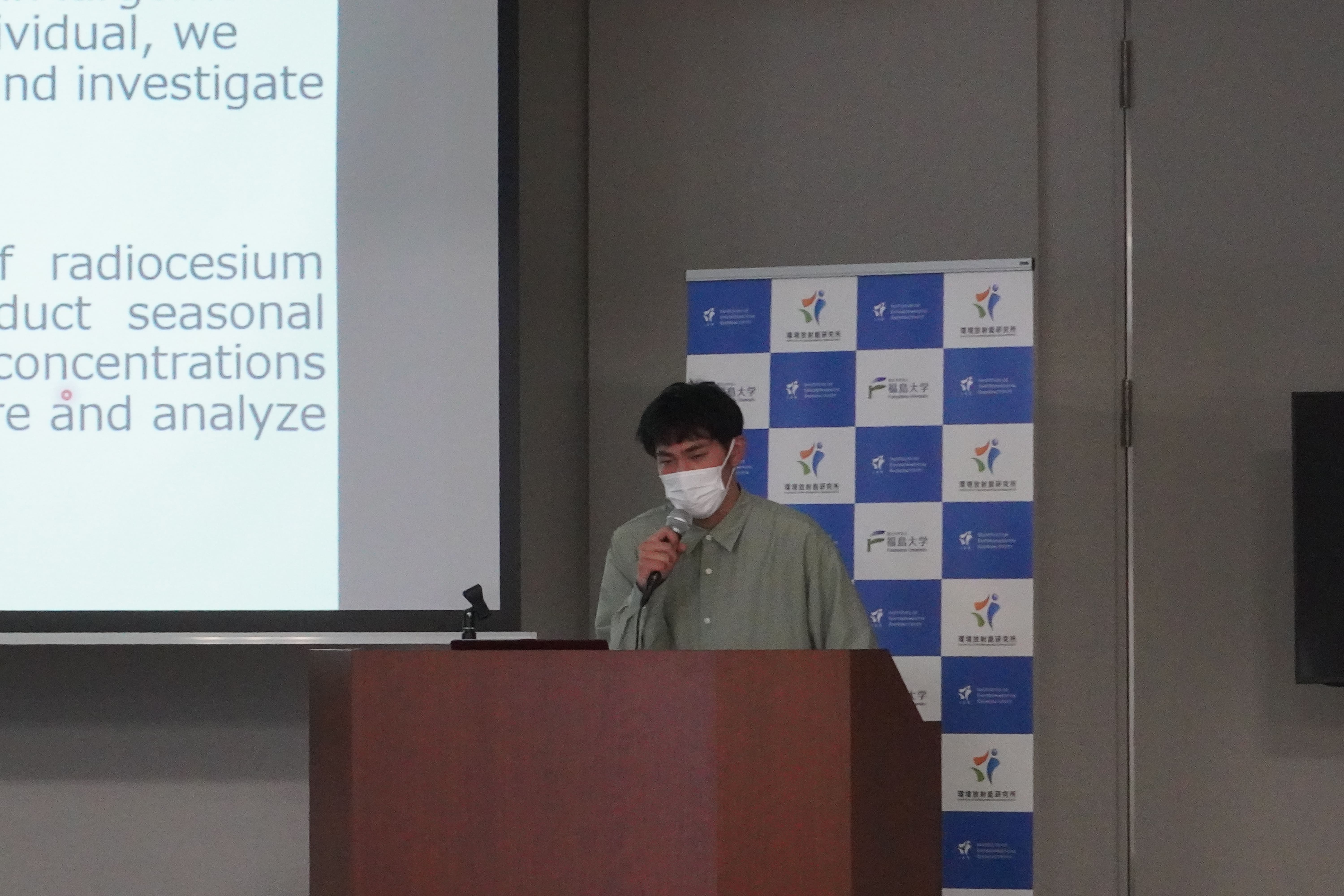 YAMAGUCHI Daisuke
YAMAGUCHI Daisuke
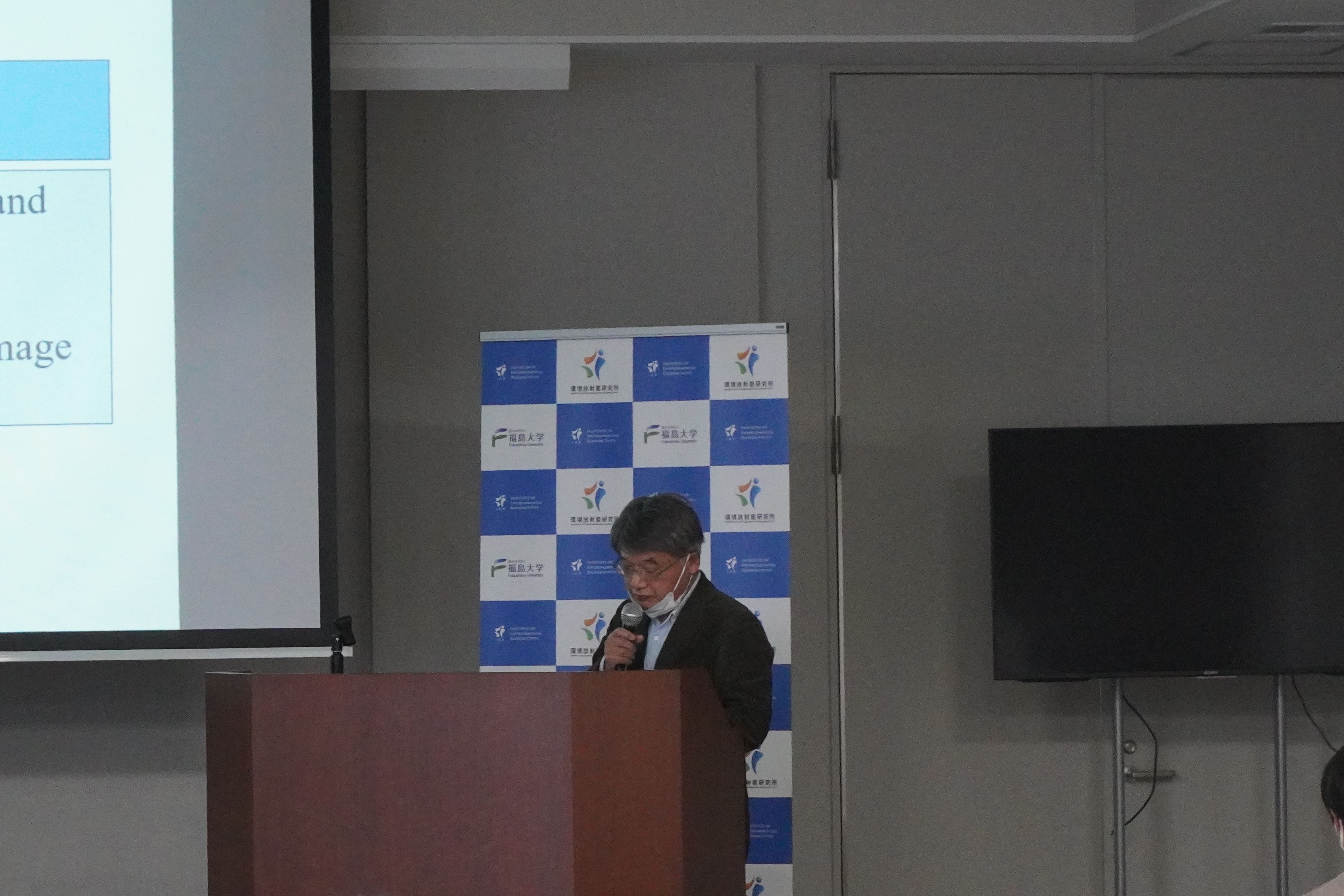 SHOJI Nobutoshi
SHOJI Nobutoshi
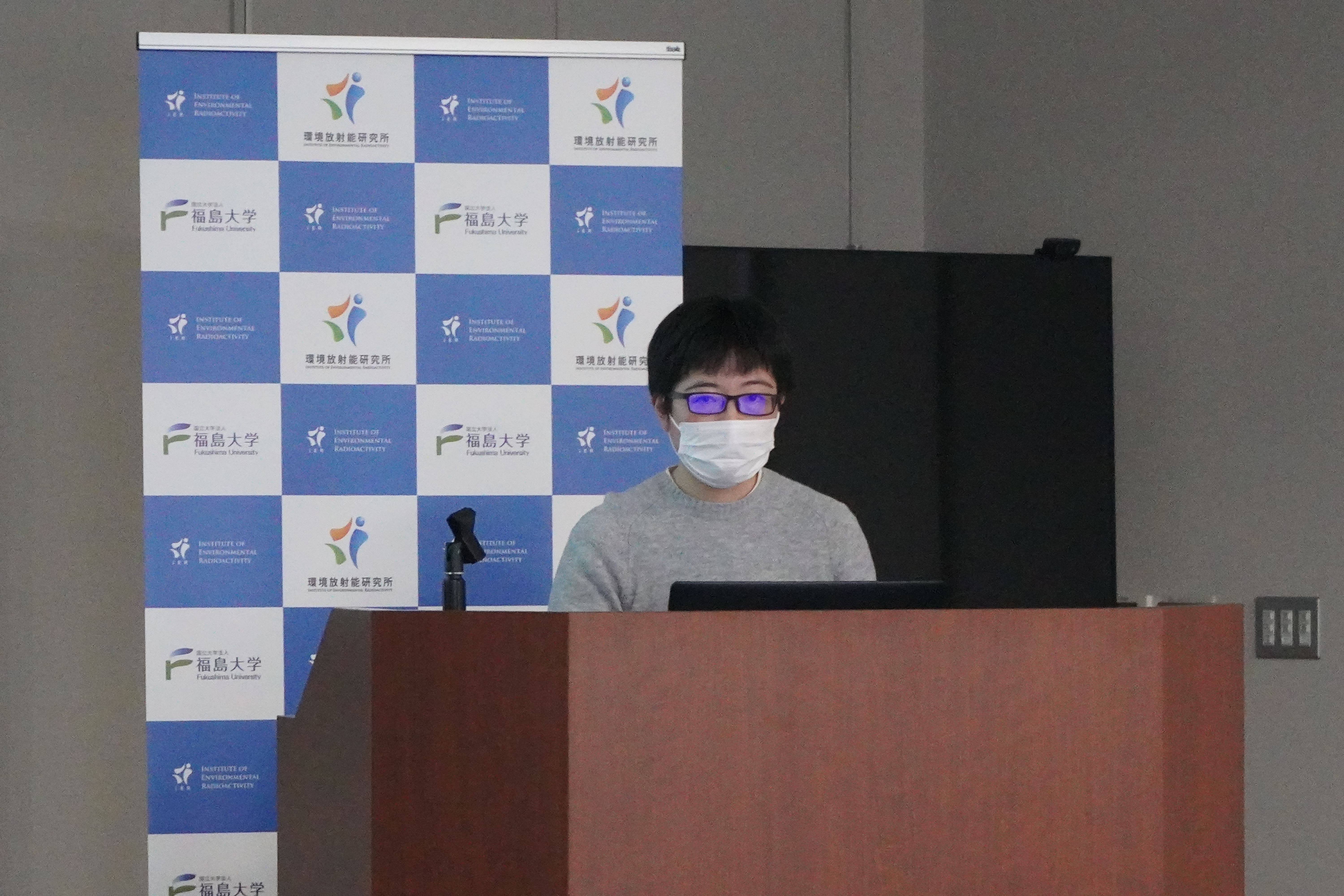 OHTSUKI Satoru
OHTSUKI Satoru
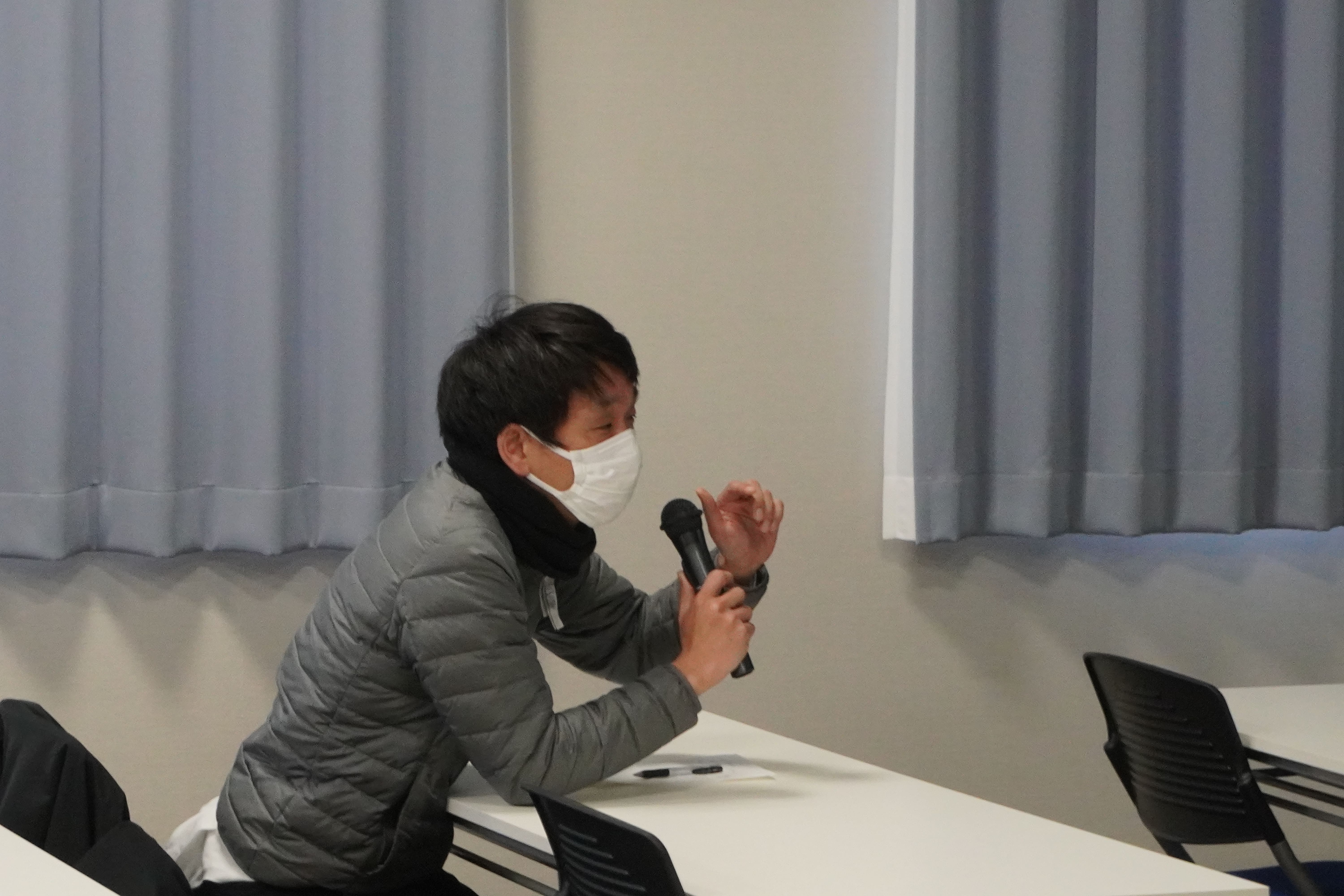 Question and answer session
Question and answer session
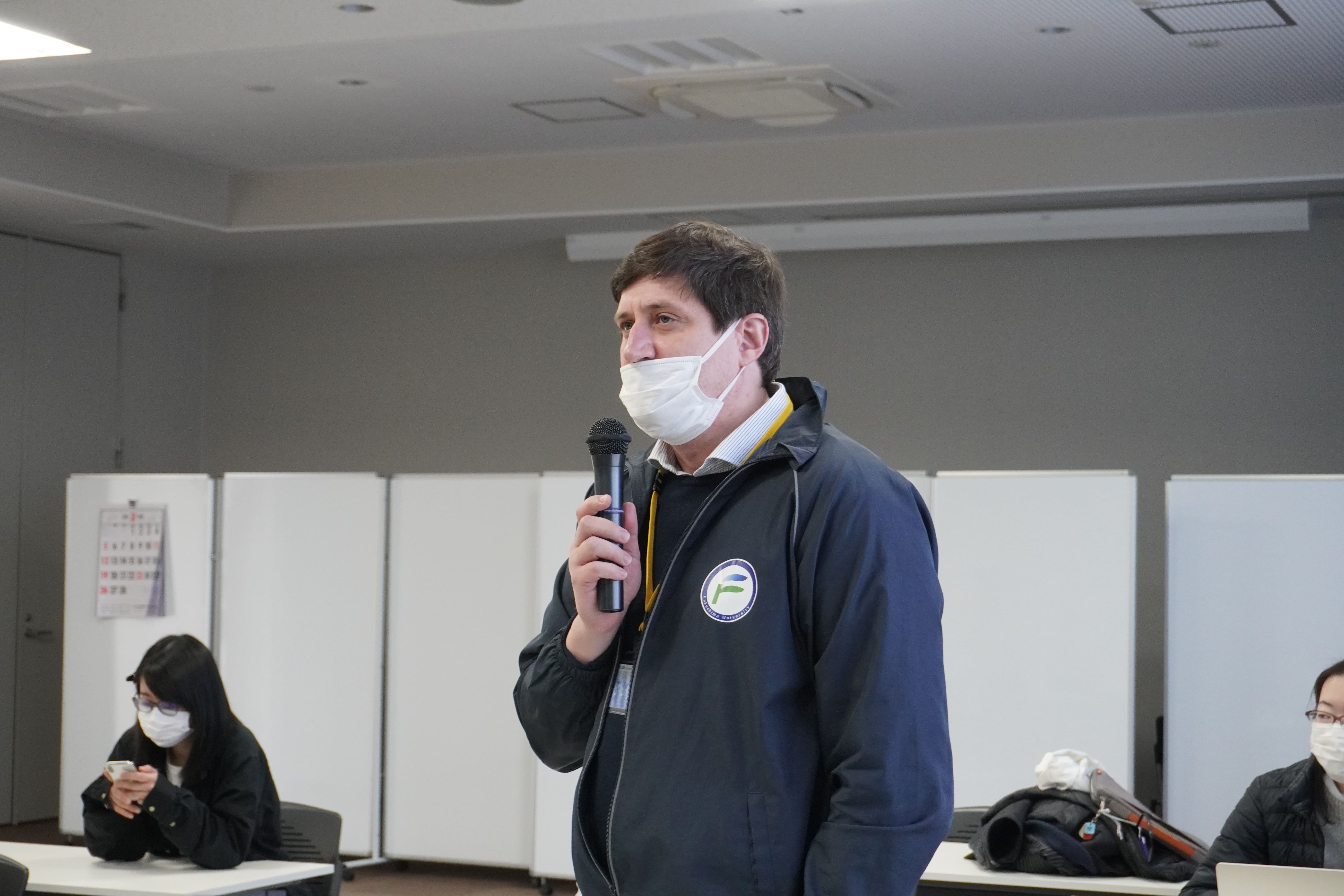
February 7th, 2023 We held the 10th IER Seminar of FY2022. <Graduate students>
| Date & time: | February 7th, 2023, 2:00pm-4:00pm |
| Topic: |
1) Elucidation of radiocesium contamination mechanism of fish using euryhaline fish as a model (MANOME Yuki: 1st year M.S. student, Major in Environmental Radioactivity) 2) Studies on 137Cs fractions in archived soil samples collected from Fukushima Prefecture in 2011 (YANAGIGAWA Kento: 1st year M.S. student, Major in Environmental Radioactivity) 3) Long-term dynamics of 137Cs accumulation at an urban pond (KUROSAWA Honoka: 1st year PhD student, Major in Environmental Radioactivity) 4) Synthesis and application of a supramolecule-based conjugate material for the separation of radionuclides from aqueous matrices (Rashedul Islam Ripon: 1st year PhD student, Major in Environmental Radioactivity) |
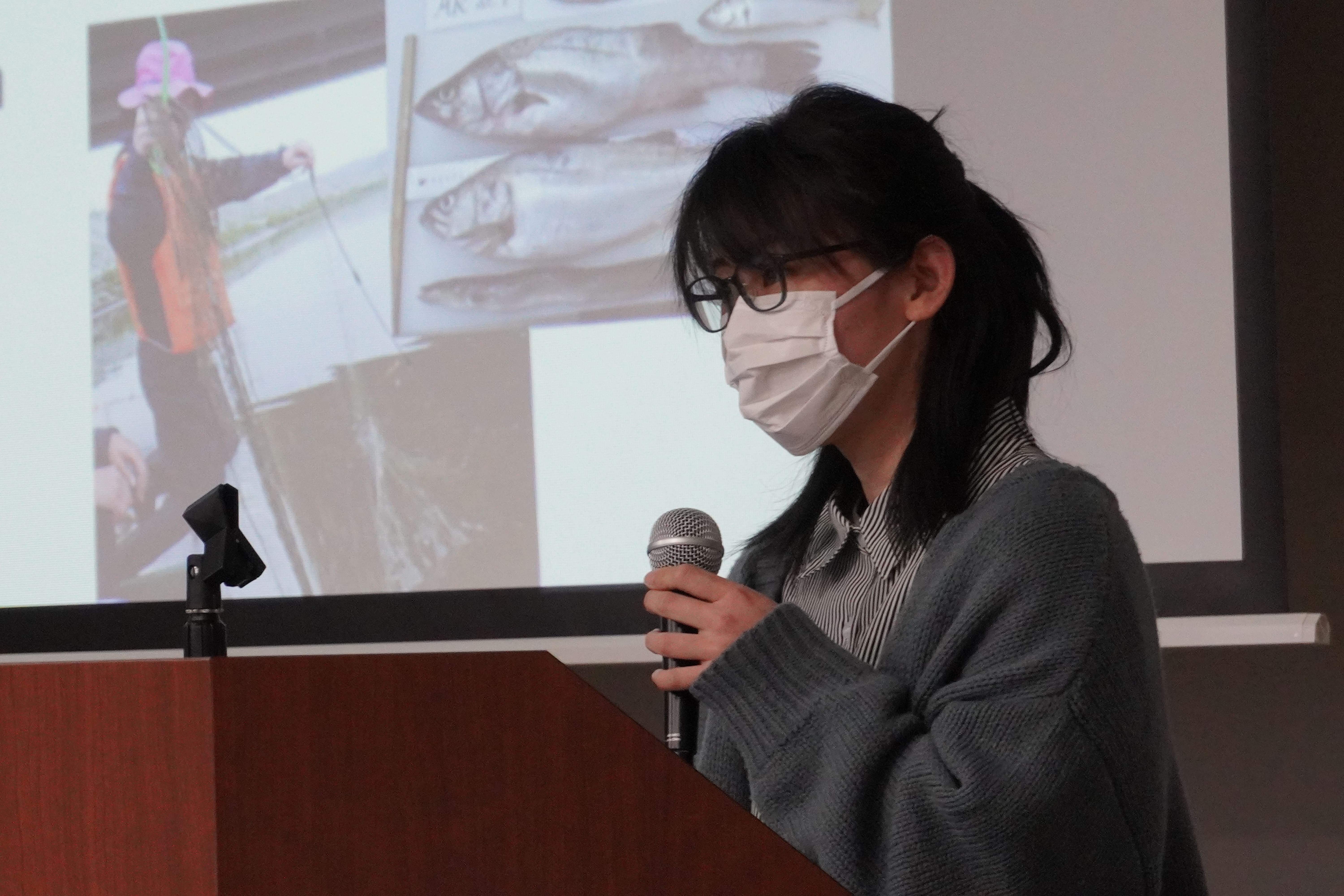 MANOME Yuki
MANOME Yuki
Institute of Environmental Radioactivity (IER) regularly holds the IER seminar, in which the faculty members report on their research results, with the purpose of facilitating their research activities and communication.
The 10th IER seminar was held on February 7, with 22 attendees. Two PhD and two M.S. students from Fukushima University Graduate School of Symbiotic Systems Science and Technology, who are conducting research activities under the supervision of the IER faculty members, made presentations on the progress of their respective research.
This was the first report for M1 and D1 students, and they gave an explanation in English respectively.
During the Q & A session, the students received many comments and advice from their supervisors as well as researchers in different research fields.
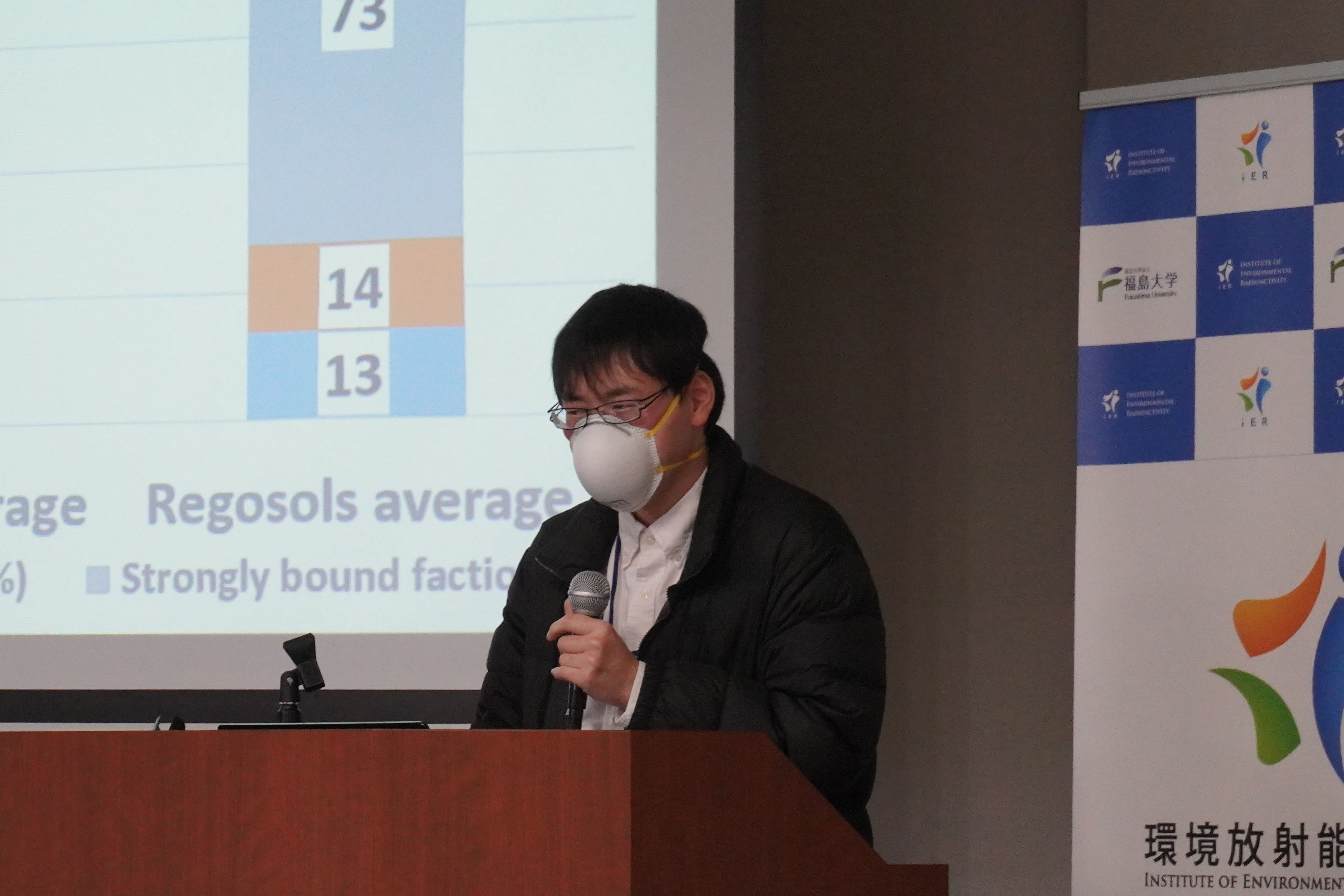 YANAGIGAWA Kento
YANAGIGAWA Kento
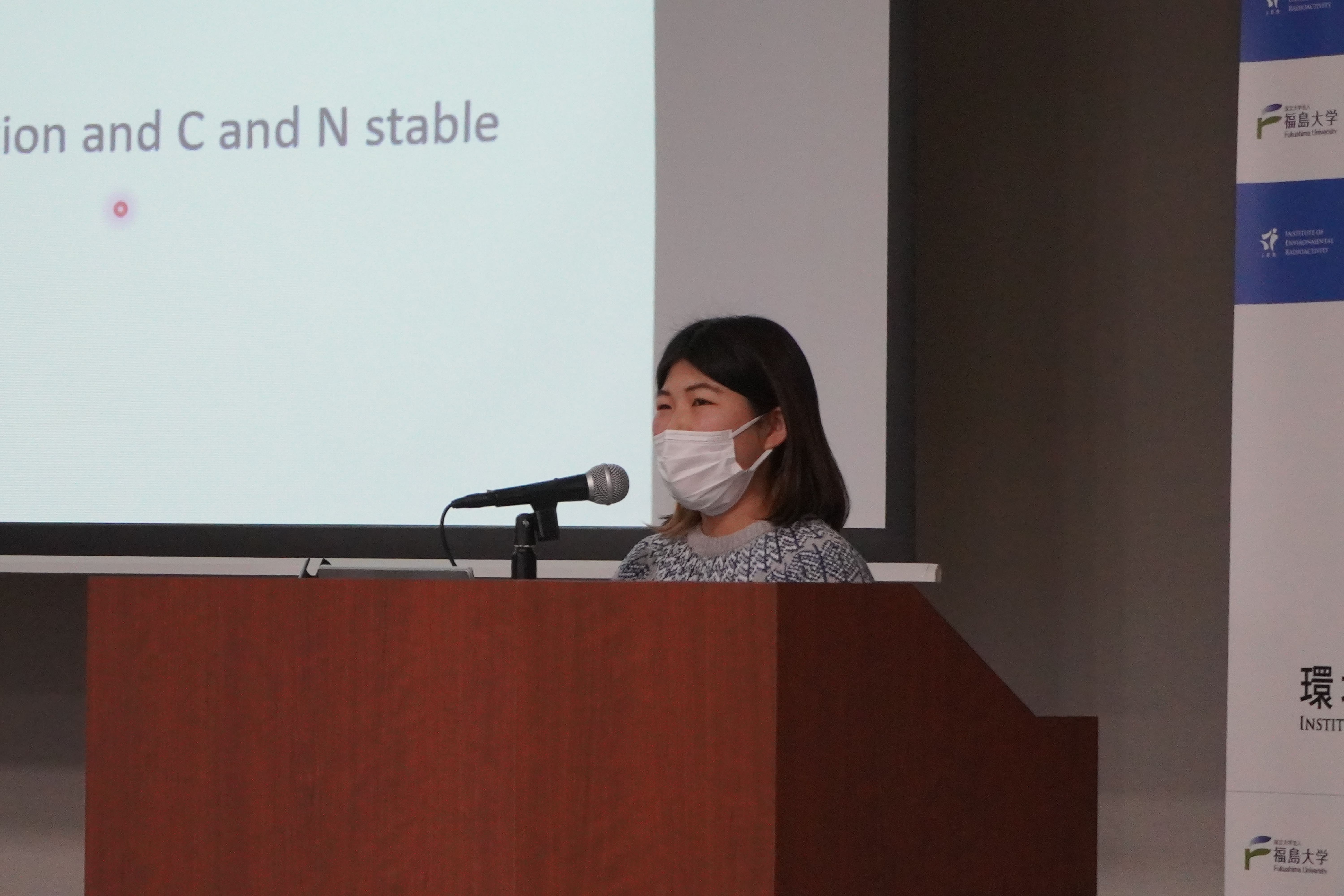 KUROSAWA Honoka
KUROSAWA Honoka
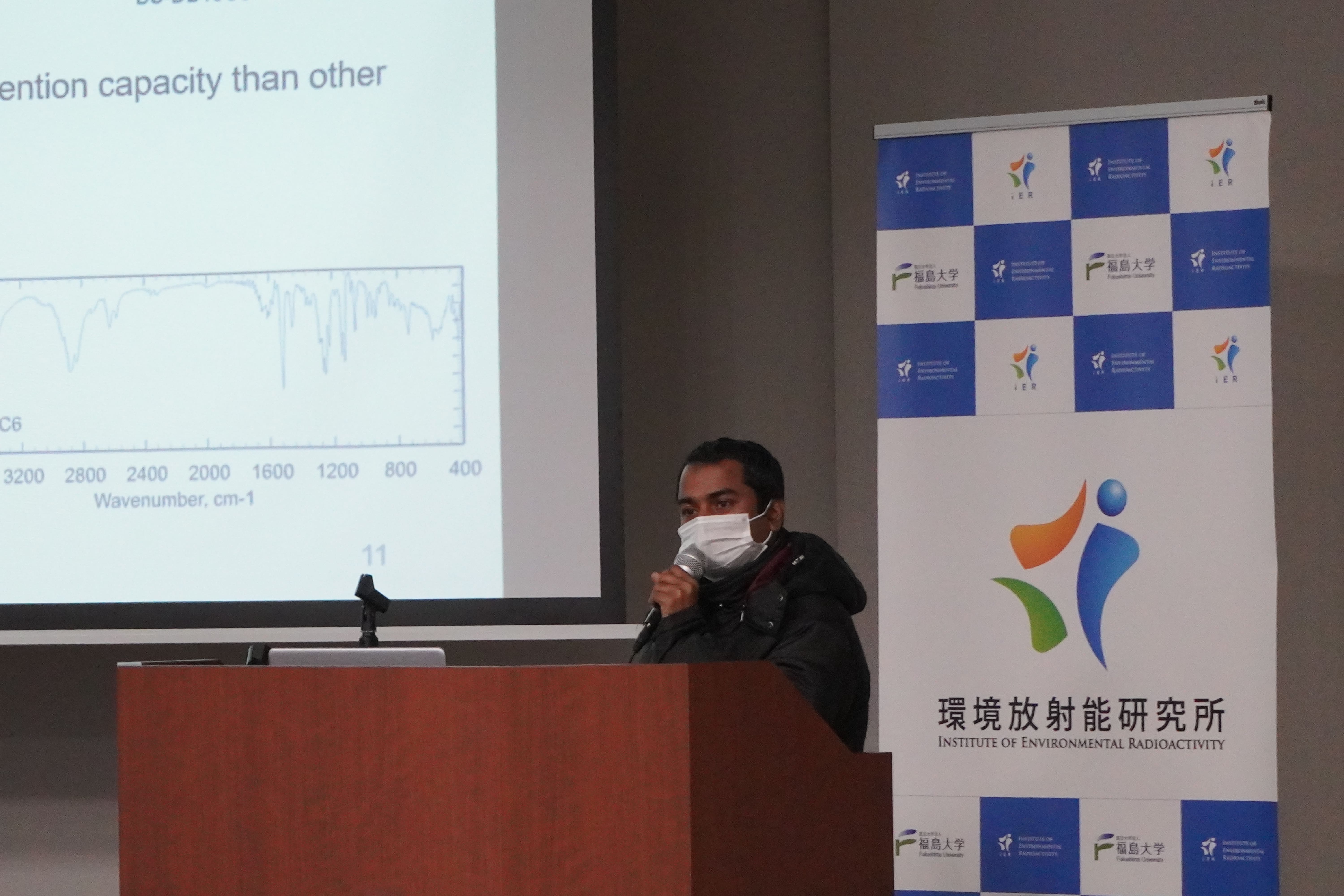 Rashedul Islam Ripon
Rashedul Islam Ripon
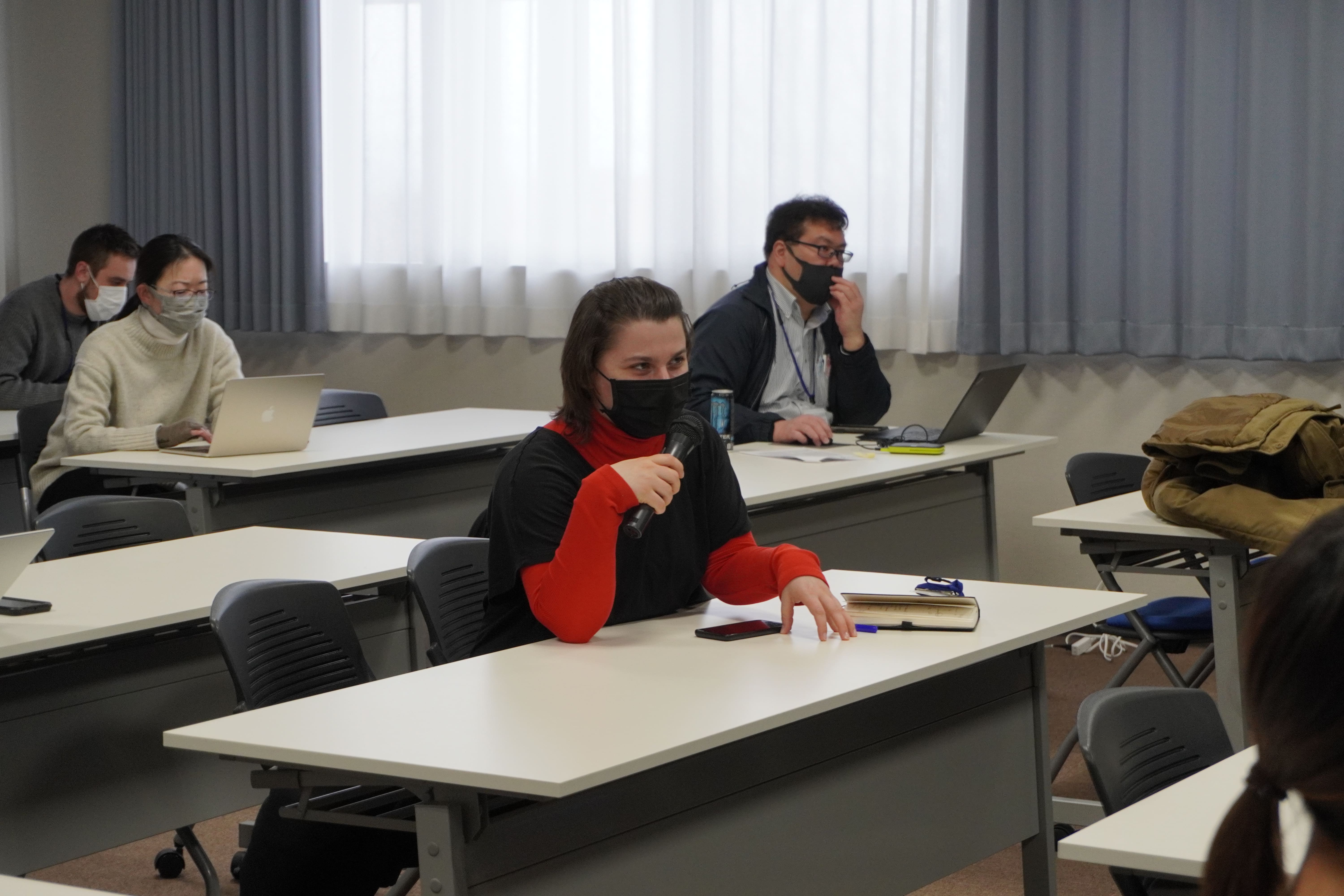 Question and answer time
Question and answer time
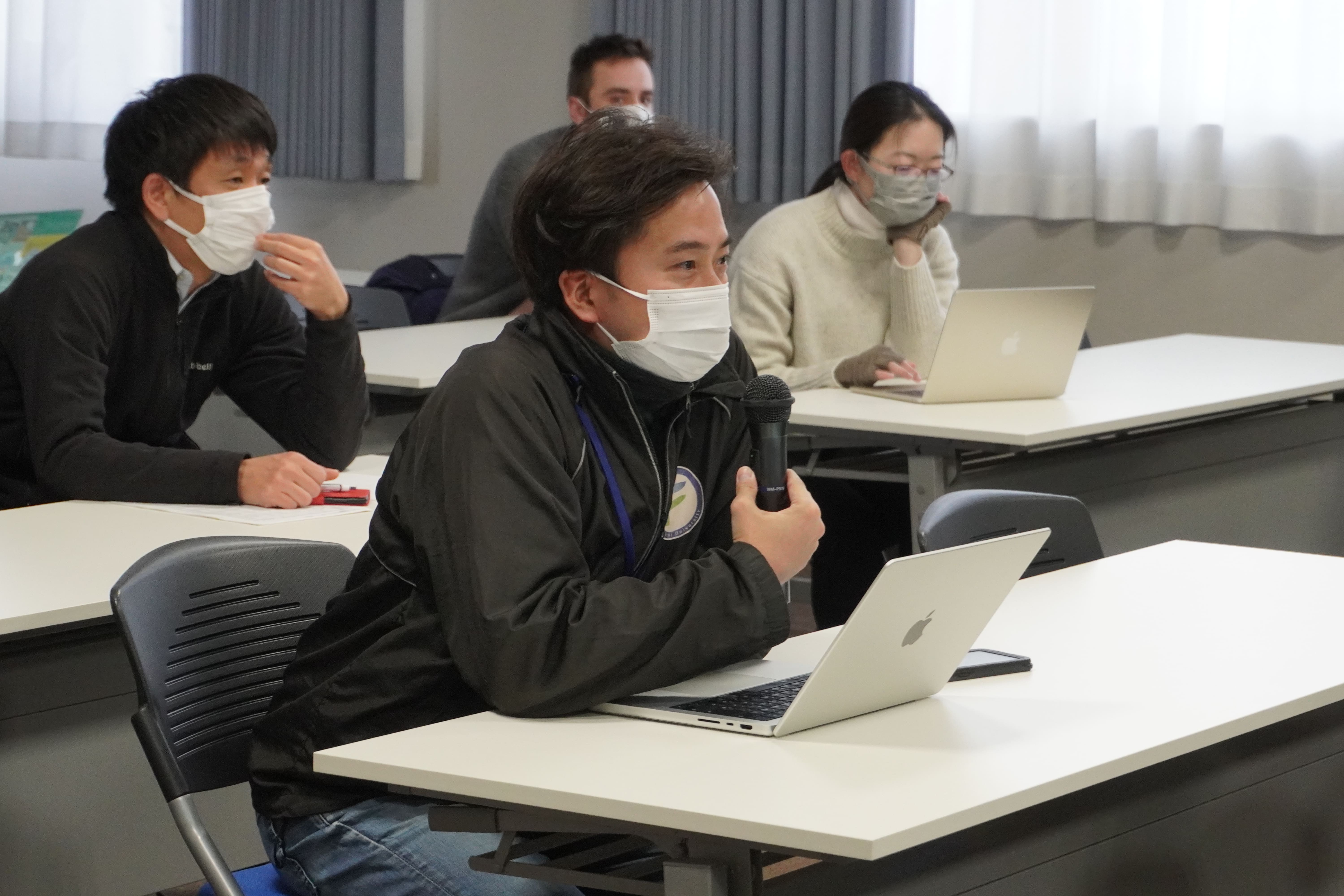
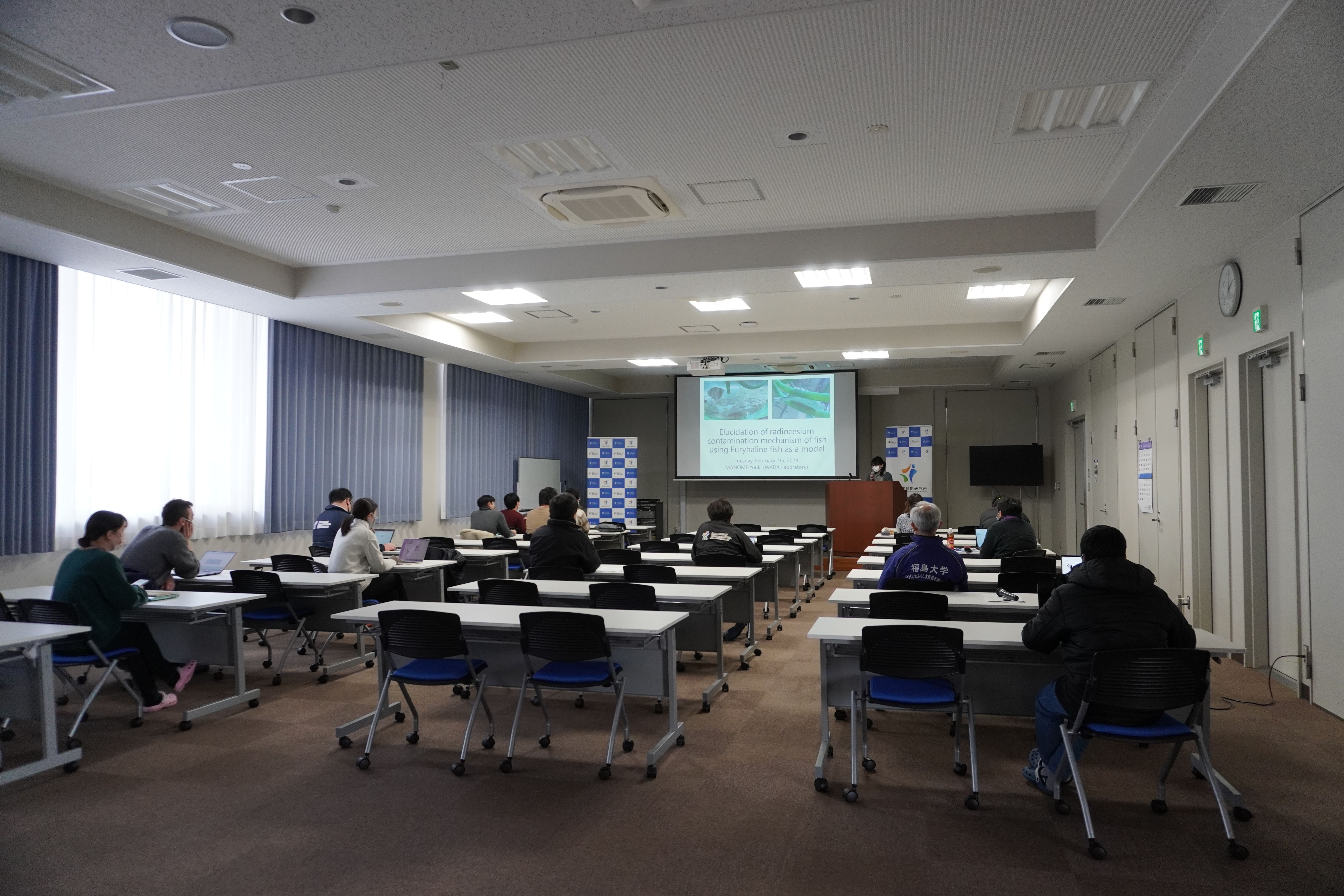 Overall view
Overall view
In January 2023, IER hosted researchers from Leiden University, the Netherlands.
IER hosted Assistant Professor Andrea Bartolucci and Tutor Jake Wright, both specializing in crisis and safety management, from January 20 to 26, 2023, under an academic exchange agreement with the Institute of Security and Global Affairs (ISGA), Faculty of Governance and Global Affairs, at Leiden University, the Netherlands. ISGA has established a master's course "Case Study Fukushima" to study the Fukushima disaster and nuclear accident from multiple perspectives, and two IER faculty members provided online lectures last March.
The purpose of this visit was to learn about the earthquake and nuclear power plant accident in Fukushima and its reconstruction in order to expand and improve the above educational program. We visited archival facilities of the disaster and local governments.
On January 21 and 22, we participated in a forum, and at a talk session titled "Passing on Fukushima's Experience," we heard firsthand from people who have been working to pass on their experiences about the difficulties they faced at the time of the earthquake and the efforts they are making for the future. On the following day, we visited Joban Coalfield Heritage, the Great East Japan Earthquake and Nuclear Disaster Memorial Museum, and Archive Museum of Tomioka, where they observed firsthand a variety of archival materials.
From January 23 to 25, we visited the TEPCO Decommissioning Archive Center, the Interim Storage Facility Information Center, and Namie Town Ukedo Elementary School (Remains of the Great East Japan Earthquake), etc. We also visited the municipalities of Tomioka, Okuma, and Namie to hear in detail from their officials about the situation at the time of the earthquake and accident, evacuation and return, reconstruction policies in each town, etc. In Tomioka Town and Okuma Town, we also heard from community development organizations about their efforts to facilitate the return and migration of residents. We also visited a former Futaba Town resident who evacuated to Koriyama City and plan to return home, as well as former Namie Town residents who evacuated to Fukushima City, to hear their thoughts on the challenges they face in returning to their homes.
On 26 January, we visited Koriyama City, which has long-standing ties with the Netherlands, and heard an explanation about Koriyama City's recovery measures from the nuclear disaster and its relationship with the Netherlands. When the Leiden University researchers asked questions about future policies, Mayor Shinagawa responded with various examples.
The two researchers from Leiden University said that they would like to reflect what they have learned from their visit to Fukushima in their educational program and share it with their students. IER would like to promote inter-disciplinary cooperation in research and educational activities with Leiden University, which has a rich international educational network and programs, with a view to student exchange in the future.
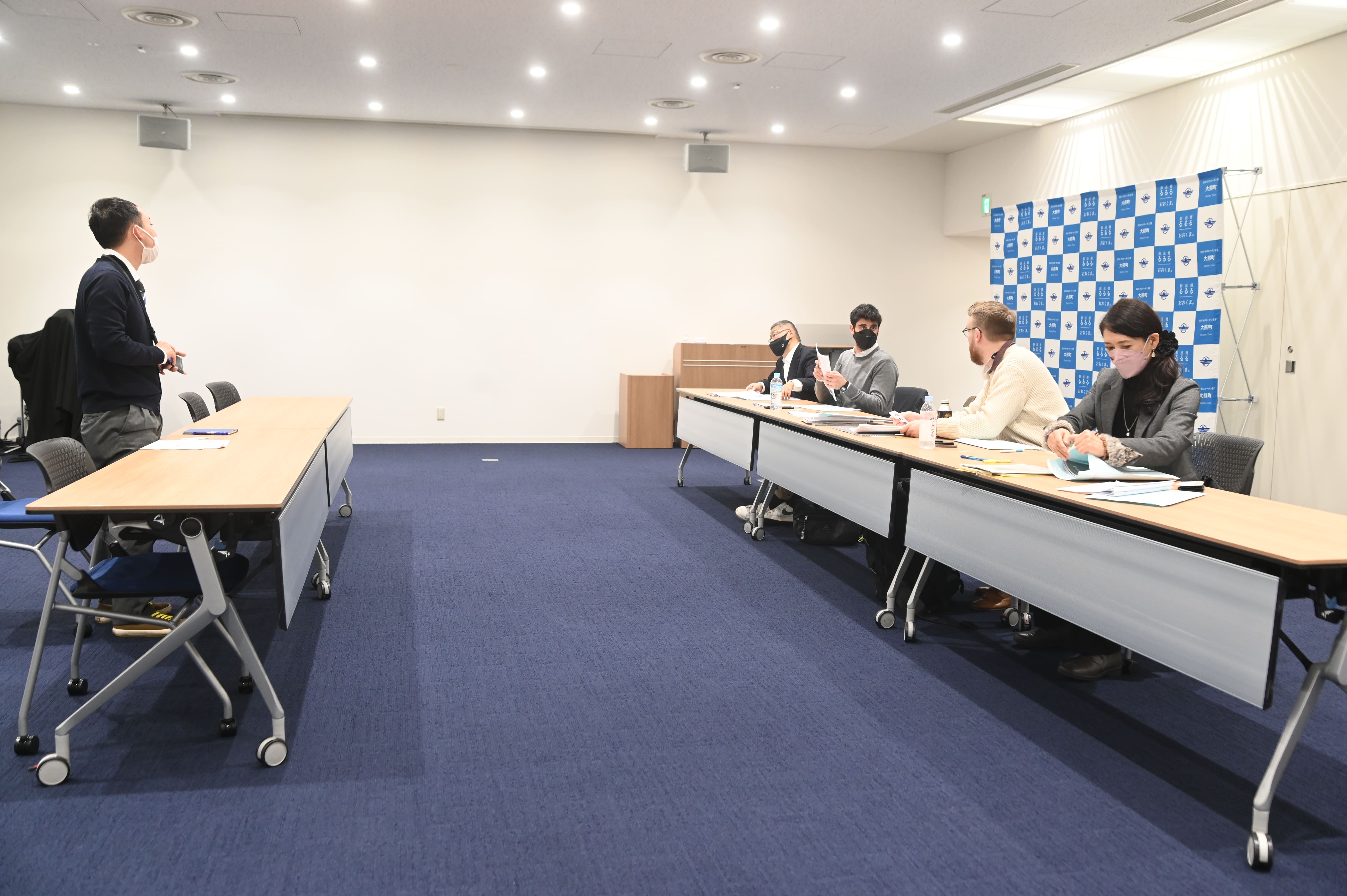 Interviewed local governments in Hamadori about the situation at the time of the earthquake and their reconstruction efforts (photo: Okuma Town).
Interviewed local governments in Hamadori about the situation at the time of the earthquake and their reconstruction efforts (photo: Okuma Town).
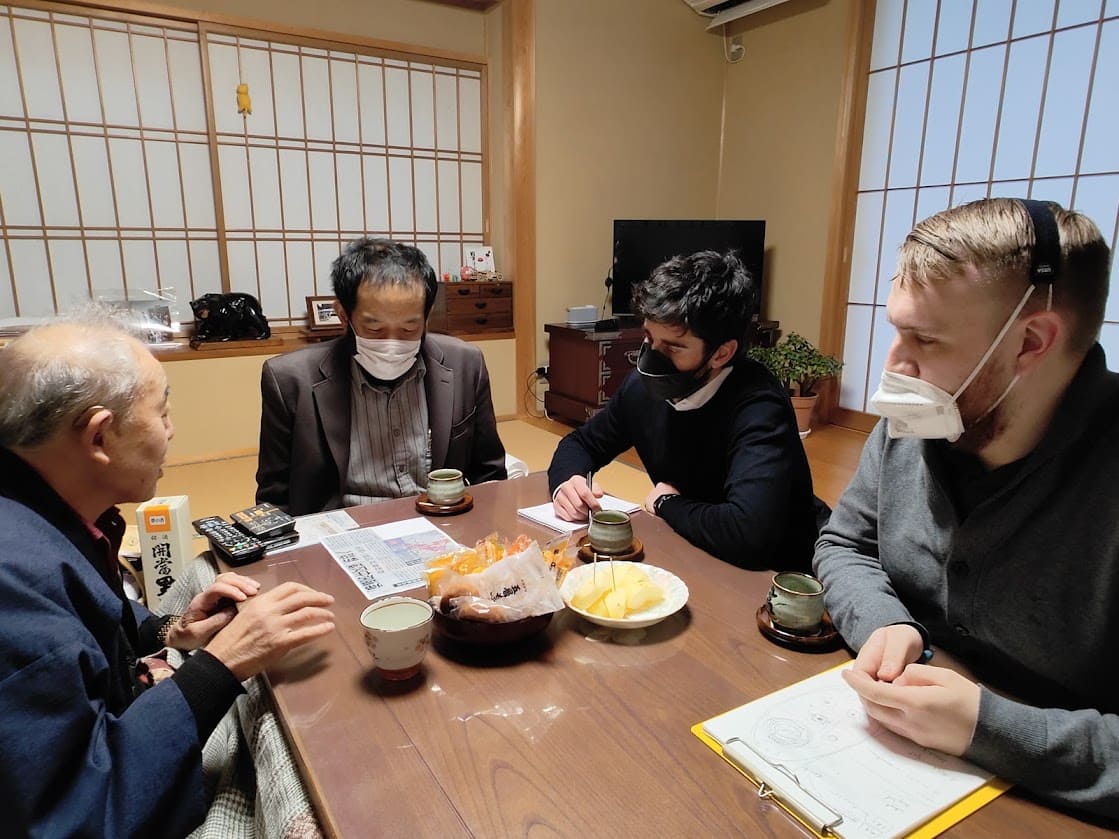 Talked with evacuees.
Talked with evacuees.
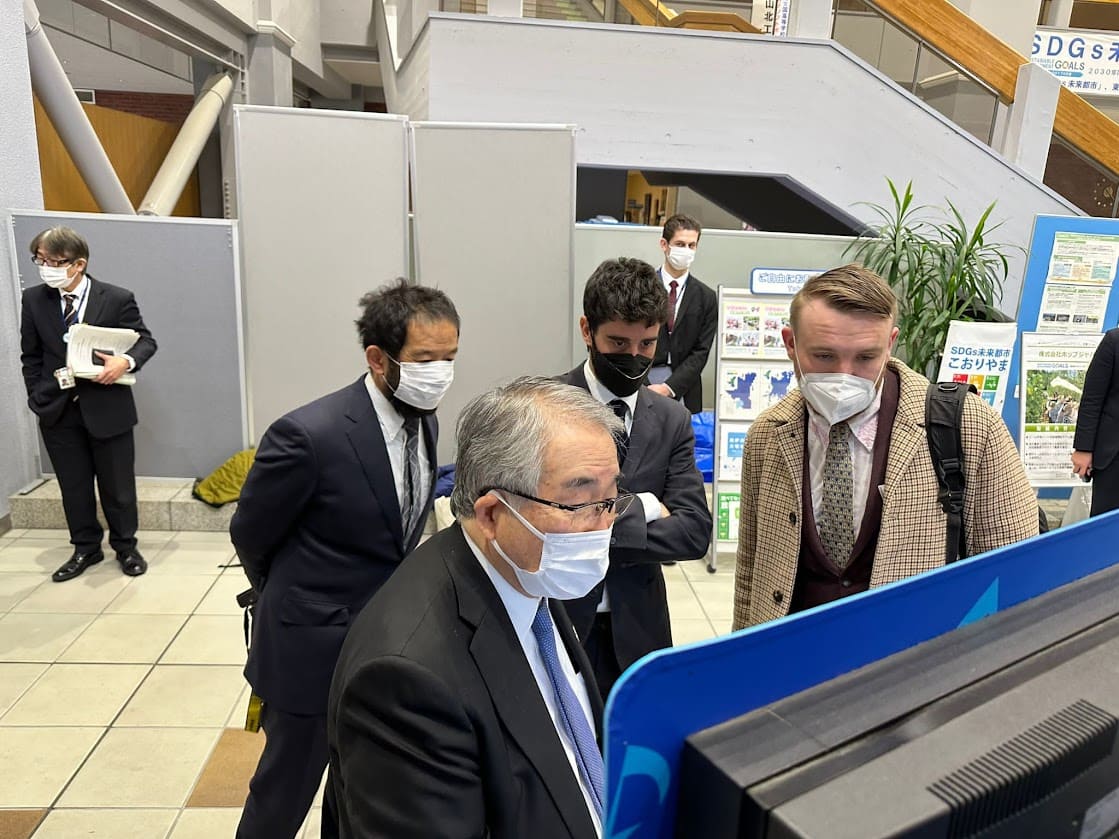 Mayor Shinagawa of Koriyama City
Mayor Shinagawa of Koriyama Cityexplaining reconstruction efforts
January 31, 2023 We held an IER Special Seminar.<Prof. Kashparov>
| Date & Time: | Thu. January 31, 2023, 16:00 ‒ 18:00 JST |
| Venue: | Online (Zoom) |
| Guest Speaker: | Prof. Valerii Kashparov, Director, Ukrainian Institute of Agricultural Radiology of NUBiP of Ukraine |
| Lecture Title: |
Soil and plant factors affecting mobility and bioavailability of radionuclides. Countermeasures |
In some of the classes of the Master’s Program of Major in Environmental Radioactivity, distinguished external researchers are invited as guest lecturers, and their classes are open to other faculty members on campus as “Special Seminars”.
On January 31, Guest Speaker Prof. Valerii Kashparov gave an online lecture on the subject “Terrestrial Radioecology”. The lecture was attended by the IER Graduate School Master student as well as by the IER members and visiting researcher. In his lecture, Prof. Kashparov talked about the uptake into foliar and roots of different radionuclides by different plant species and factors that can modify the uptake intensities, such as soil type, physical-chemical forms of radionuclides, contents of moisture, organic matter, and competing ions (nutrients) in the soil, etc. Prof. Kashparov also presented the permissible levels (national standards) of radionuclides in food and farm products in different countries, and stated the application and efficiency of an extensive list of countermeasures (removal of contaminated soil, adding clean soil, shallow and deep plowing, skimming and burying soil, fertilizing, liming, application of Prussian blue, processing of food products, clean feeding of animals, etc.), and gave examples of software developed for decision support on the application of countermeasures based on a cost-benefit analysis taking into account local conditions. The audience actively participated in the Q&A session, which covered issues related to the uncertainties in radiological assessments when operating with recommended values of transfer factors, the application of Prussian blue in fisheries and livestock, production of ethanol and alcoholic beverages from radioactively contaminated plant products, setting permissible levels for food and farm products, and others.
January 30, 2023 We held an IER Special Seminar.<Prof. Levchuk>
| Date & Time: | Thu. January 30, 2023, 16:00 ‒ 18:00 JST |
| Venue: | Online (Zoom) |
| Guest Speaker: | Dr. Sviatoslav Levchuk, Head of Lab, Ukrainian Institute of Agricultural Radiology of NUBiP of Ukraine |
| Lecture Title: | Radioecological monitoring: schedule, results, optimization |
In some of the classes of the Master’s Program of Major in Environmental Radioactivity, distinguished external researchers are invited as guest lecturers, and their classes are open to other faculty members on campus as “Special Seminars”.
On January 30, Guest Speaker Dr Sviatoslav Levchuk gave an online lecture on the subject “Terrestrial Radioecology”. The lecture was attended by the IER Graduate School Master student as well as by the members of the IER and visiting researchers. In his lecture, Dr. Levchuk spoke about radioecological monitoring as a tool to ensure the radiation protection of the population and acquiring radioecological knowledge. Dr. Levchuk described the types of monitoring (source, environmental and individual monitoring) and presented typical monitoring requirements and procedures, as well as specifics of monitoring under normal conditions and at different stages of radiation emergencies. A local case study was also presented to illustrate how radioecological monitoring is conducted. The audience took an active part in the Q&A session, which was addressed issues related to the effectiveness of routine monitoring for detecting local accidents, optimization of monitoring and increasing its potential for obtaining scientific data, migration of 90Sr and its transfer to cereals, and other topics.
January 27, 2023 We held an IER Special Seminar.<Prof. Kashparov>
| Date & Time: | Thu. January 27, 2023, 16:00 ‒ 17:50 JST |
| Venue: | Online (Zoom) |
| Guest Speaker: | Prof. Valerii Kashparov, Director, Ukrainian Institute of Agricultural Radiology of NUBiP of Ukraine |
| Lecture Title: | Field sampling and statistics in radioecology |
In some of the classes of the Master’s Program of Major in Environmental Radioactivity, distinguished external researchers are invited as guest lecturers, and their classes are open to other faculty members on campus as “Special Seminars”.
On January 27, Guest Speaker Prof. Valerii Kashparov gave an online lecture on the subject “Terrestrial Radioecology”. The lecture was attended by the IER Graduate School Master students as well as several members of the IER and visiting researchers. In his lecture, Prof. Kashparov talked about spatial and temporal variations of radionuclide deposition densities and concentrations in environmental samples, as well as the approaches to address the related uncertainties while conducting radioecological monitoring and radiological assessments. He discussed the regular, spot, and random components that causes heterogeneity in the radioactive contamination levels measured within the limited observation areas, as well as the impact of the sampling grid, sampling area, number of samples, and local factors on the accuracy of monitoring data. He gave some advice about the number of samples to obtain average values of the soil deposition, plant contamination, transfer factor, etc., with a designated accuracy. The audience actively participated in the Q&A session, which covered issues related to the problem of outlier values in radioecological monitoring, heterogeneity of element (e.g., potassium, stable iodine) distributions on a local scale, requirements for fish sampling to determine its contamination level, and mechanisms of 90Sr uptake by fish.
January 26, 2023 We held an IER Special Seminar.<Prof. Levchuk>
| Date & Time: | Thu. January 26, 2023, 16:00 ‒ 17:50 JST |
| Venue: | Online (Zoom) |
| Guest Speaker: | Dr. Sviatoslav Levchuk, Head of Lab, Ukrainian Institute of Agricultural Radiology of NUBiP of Ukraine |
| Lecture Title: | Terrestrial radioecology studies in Chornobyl |
In some of the classes of the Master’s Program of Major in Environmental Radioactivity, distinguished external researchers are invited as guest lecturers, and their classes are open to other faculty members on campus as “Special Seminars”.
On January 26, Guest Speaker Dr Sviatoslav Levchuk gave an online lecture on the subject “Terrestrial Radioecology”. The lecture was attended by the IER Graduate School Master and PhD students as well as the members of the IER and visiting researchers. In his lecture, Dr. Levchuk reviewed the long-term radioecological studies of terrestrial ecosystems in the Chornobyl Exclusion Zone, focusing at geochemical and biogenic migration of radionuclides in the soil. Dr. Levchuk presented a large amount of empirical data on the migration of 137Cs, 90Sr, Pu isotopes, radioisotopes of Cl and I, and others, and interpreted the observed regularities based on elemental properties, soil conditions such as pH, organic matter content, humidity, etc., and physical form of deposition. The requirements for the soil sampling were discussed, and practical advice were given on how to conduct representative and accurate sampling. The audience actively participated in the Q&A session, which covered issues related to the migration of radionuclides from the unsaturated soil zone to the aquifer, distribution coefficients of radionuclides in different soil conditions in Chornobyl and Fukushima, modeling of radionuclide migration, and the availability of results of the Chornobyl studies.
January 12, 2023 We held an IER Special Seminar.<Prof. Shinano>
On January 12, Guest Speaker Professor Takuro Shinano gave a lecture on the subject “Terrestrial Radioecology”. The lecture was attended by the IER Graduate School Master and PhD students as well as members of the IER and other departments of Fukushima University. The lecture was also streamed online. The main topics of the lecture were the impacts of the Fukushima accident on agriculture and countermeasures such as decontamination of plants, decontamination of soil, and mitigation of radiocesium uptake by plants. Among the remaining problems in agriculture, the applicability of transfer factor (or concentration ratio between soil and plants), differences between soil types, and the role of exchangeable potassium in regulating the radiocesium uptake were discussed. The audience actively participated in the Q&A session, which covered issues related to plant decontamination, the impact of countermeasures on soil quality, the effect of potassium fertilizers and Prussian blue on uptake of radiocesium by plants, cost-benefit analysis of agricultural countermeasures, and the perspectives of agriculture on radioactively contaminated lands in Fukushima Prefecture.
December 10, 2022 The 18th Dialog meeting was held at in Iwaki, Fukushima
ER held the 16th dialogue meeting at Koriyama, Fukushima Prefecure. IER has been holding these meetings since 2016, in order to feedback our research results to local communities. Click here for details.
Ukrainian researcher visited Interim Storage Facility and Fukushima Nuclear Power Plants
As part of SATREPS Chornobyl project, IER hosted Ukrainian researcher Dr. Olena BURUDO for technical training from August to December 2022. Dr. Burdo has been studying the effects of radiation on wildlife following the Chornobyl Nuclear Power Plant accident. During her training in Japan, she visited a interim storage facility to store soil removed during decontamination work, and Fukushima Daiichi and Daini Nuclear Power Plants to learn about post-accident efforts in Japan. Also joining the tour was Dr. Solomon AMUNO, a researcher from University of Saskatchewan, Canada, who has stayed for a short period in Fukushima conducting field research.
November 25, Tour of interim storage facility
At the beginning of the tour, Dr. Burdo and other members received a brief overview about the current situation of the transportation of removed soil and construction work of the facility at the information center. The then head out on a bus for a tour of the facility.

 Head to the site!
Head to the site!
 Observing the process of opening bags containing soil and sorting out non-soil items such
Observing the process of opening bags containing soil and sorting out non-soil items such
The interim storage facility is constructed in between Futaba Town and Okuma Town, Fukushima Prefecture, surrounding Fukushima Daiichi Nuclear Power Plant, and covers an area of 16km2. We visited the southern part of the facility, located in Okuma Town. In the facility, there are still traces of people’s lives, such as houses, schools, community centers, shrines, and a nursing home that remains just as it was, when the big earthquake occurred on March 11, 2011.
 View the entire facility from the hill.
View the entire facility from the hill.
 Flexible container bags (filled with removed soil)
Flexible container bags (filled with removed soil) collected from temporary storage sites throughout Fukushima Prefecture.
In Chornobyl, there has been no large-scale decontamination as has been done in Fukushima, and the exclusion zone has not been reorganized since the accident 36 years ago. During the tour, Dr. Burdo listened with great interest to the explanation about the huge facility, the decontamination activities to restore a safe environment for people to live in, and the associated soil removal and disposal operations.
December 5-6 Tour of Fukushima Daiichi and Daini Nuclear Power Plants
Both Daiichi and Daini nuclear plants were hit by a tsunami after the earthquake on March 11, 2022, and lost the power needed to cool the nuclear fuels. The Daini, however, was able to secure an external power source, which prevented the accident, while Daiichi was unable to secure a power source, leading to a hydrogen explosion.
TEPCO staff explained the situation at the Daini immediately after the earthquake and how they were able to secure power and prevent an accident after the loss of power due to the tsunami. At the Daiich, Dr. Burdo and IER members learned about the circumstances that led to the accident at each reactor, the ongoing decommissioning work, and the ALPS treated water containing tritium that is scheduled to be released from next fiscal year onward.
 Fukushima Daini Nuclear Power Plant
Fukushima Daini Nuclear Power Plant
 At the hill where is able
At the hill where is able to view all facilities of Daini
 Observing the actual cables that were laid
Observing the actual cables that were laidby hand over a distance of 9 kilometers
immediately after the earthquake
to power the reactor buildings at Daini.
 Before the tour of Daiichi,
Before the tour of Daiichi, learned how the serious accidents occurred
at each reactors 1 to 4,TEPCO Decommissioning Archive Center
 Touched the bottle filled
Touched the bottle filled with ALPS treated water
 Viewed the damaged reactors 1 to 4
Viewed the damaged reactors 1 to 4from the hill in the Daiichi within the premises.

By actually visiting the plants, the participants were reminded of the seriousness of the accident and learned that decommissioning work is currently being carried out using all available technology and that concerted efforts are being made to prevent the generation of contaminated water as much as possible. Dr. Burdo seemed to be impressed by the differences in the post-accident response between Chornobyl and Fukushima, and asked a lot of questions. We hope that this visit will be useful for each researcher’s future research activities.
November 28, 2023 The 7th IER seminar was held.
<Project Researcher Tatsuno, Trainee of SATREPS project, Burdo>
| Date & Time: | Monday, November 28, 2022, 2:00-3:00 PM |
| Speaker: |
TATSUNO Takahiro, Project Researcher Olena BURDO, Researcher of Institute for Nuclear Research, National Academy of Science, Ukraine/Trainee of the SATREPS project (Presentarion order) |
| Presentation title: |
The contribution of Cesium rich microparticles to Cs concentration of river water and forest soil in Takase River watershed(Tatsuno) Radiation effects in Rodents from Chornobyl exclusion zone Ukraine(Burdo) |
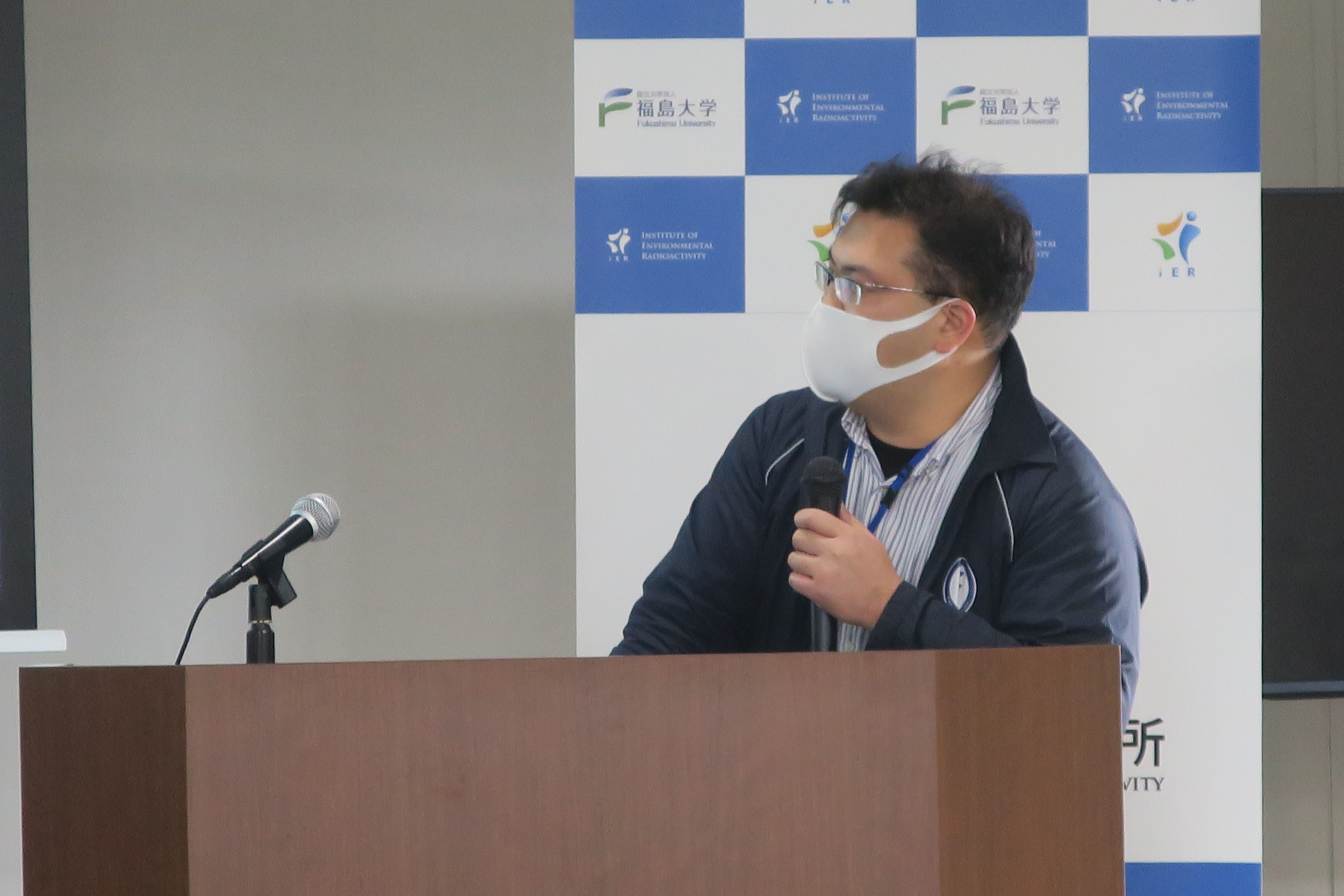 Dr. Tatsuno
Dr. Tatsuno
Institute of Environmental Radioactivity (IER) regularly holds the IER seminar in which the faculty members report on their research results, with the aim of facilitating their research activities and promoting communication.
In the 7th IER seminar of this fiscal year that held on November 28, 2022, two researchers gave presentations on their research activities and results. The seminar was attended by 20 researchers and students.
Dr. Tasuno presented his research on the distribution and dynamics of highly radioactive cesium-containing particles called CsMP (Radioactive cesium-rich microparticles) in soils and rivers. The results of field surveys and sample measurement and analysis showed that CsMPs are rather distributed in the soil surface layer and that they are discharged into rivers due to soil erosion during rainfall events but their effect on the solid-liquid partition coefficient (Kd) is small.
Dr. Burdo is a researcher of Institute for Nuclear Research, National Academy of Science, Ukraine, and having training at IER and other research institutes in Japan as a JICA trainee of SATREPS Chornobyl project since August this year. She gave an overview of the research she has conducted in Ukraine, including research on wildlife around the Cooling Pond (a reservoir that supplies cooling water to the Chornobyl Nuclear Power Plant), which is part of the SATREPS Chornobyl project. She also explained the DNA and chromosome analysis methods that she learned during her training in Japan.
After each presentation, IER faculty members gave the presenters various questions and comments.
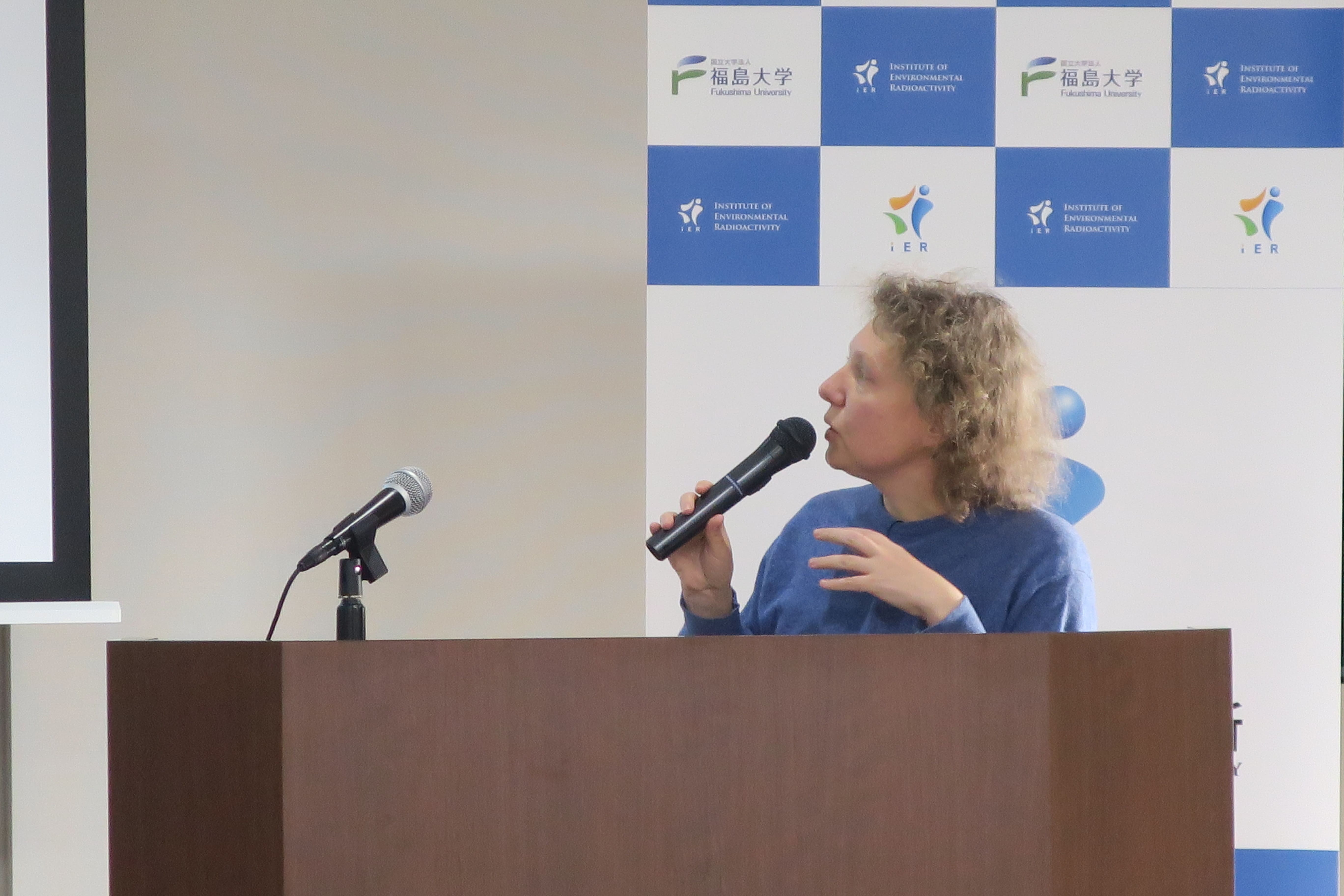 Dr. Burdo
Dr. Burdo
On December 9, 2022, Director Nanba attended the award ceremony held at the Embassy of France
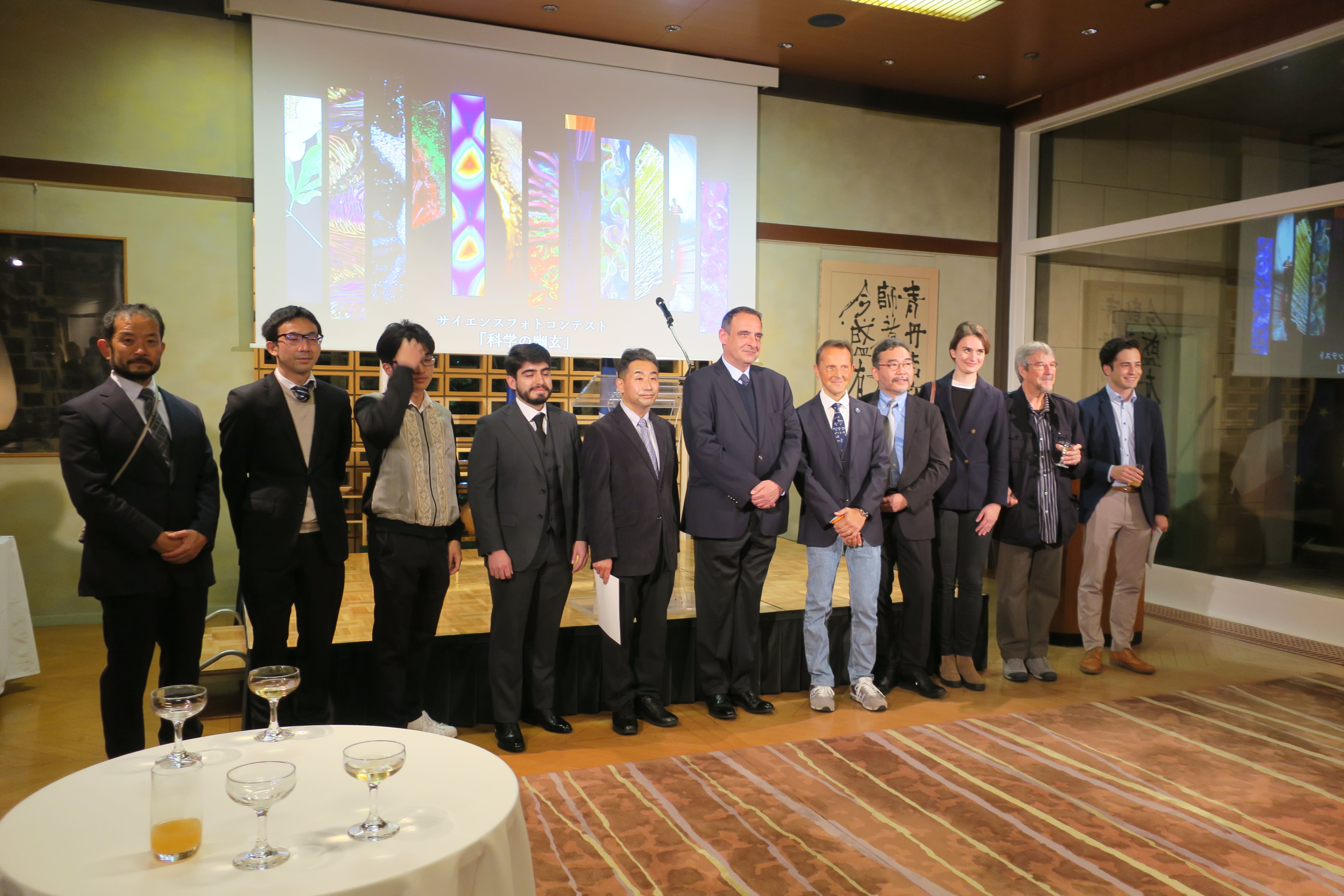 Ambassador Philippe SETTON
Ambassador Philippe SETTON and finalists (including proxies)
On December 9, 2022, Director Nanba attended the award ceremony of the 2nd Science Photo Contest “Beauté cachée de la science” sponsored by the Embassy of France in Tokyo on behalf of his French collaborator Dr. Andre GILLES, who was selected as one of the 12 finalists.
Andre's photo titled "Kintsugi" is a close-up of a frog's eye, and the frog's golden iris looks like a piece of kintsugi, a Japanese art of repairing broken pottery. Our collaborative team is studying the effects of ionizing radiation on the DNA of tree frogs (damage and repair).
The contest is open to photos that focus on the beauty behind the science, and the finalists will be posted online for everyone to vote on the winning photos. Unfortunately, Andre's work did not win a prize. Importantly, however, the light falls also on the research project itself and researchers' collaboration behind the photo through the contest.
Participants engaged in lively conversations about science, art, future exchanges and so on with the Ambassador, members of Service for Science and Technology (SST), researchers from a wide range of fields and corporate CSR professionals, as they viewed the photos displayed at the reception hall. It is hoped that future collaborations between Japan and France will be greatly promoted and deepened.
Reference URL (finalists and winners)https://concoursyugen.jp.ambafrance.org/ja/
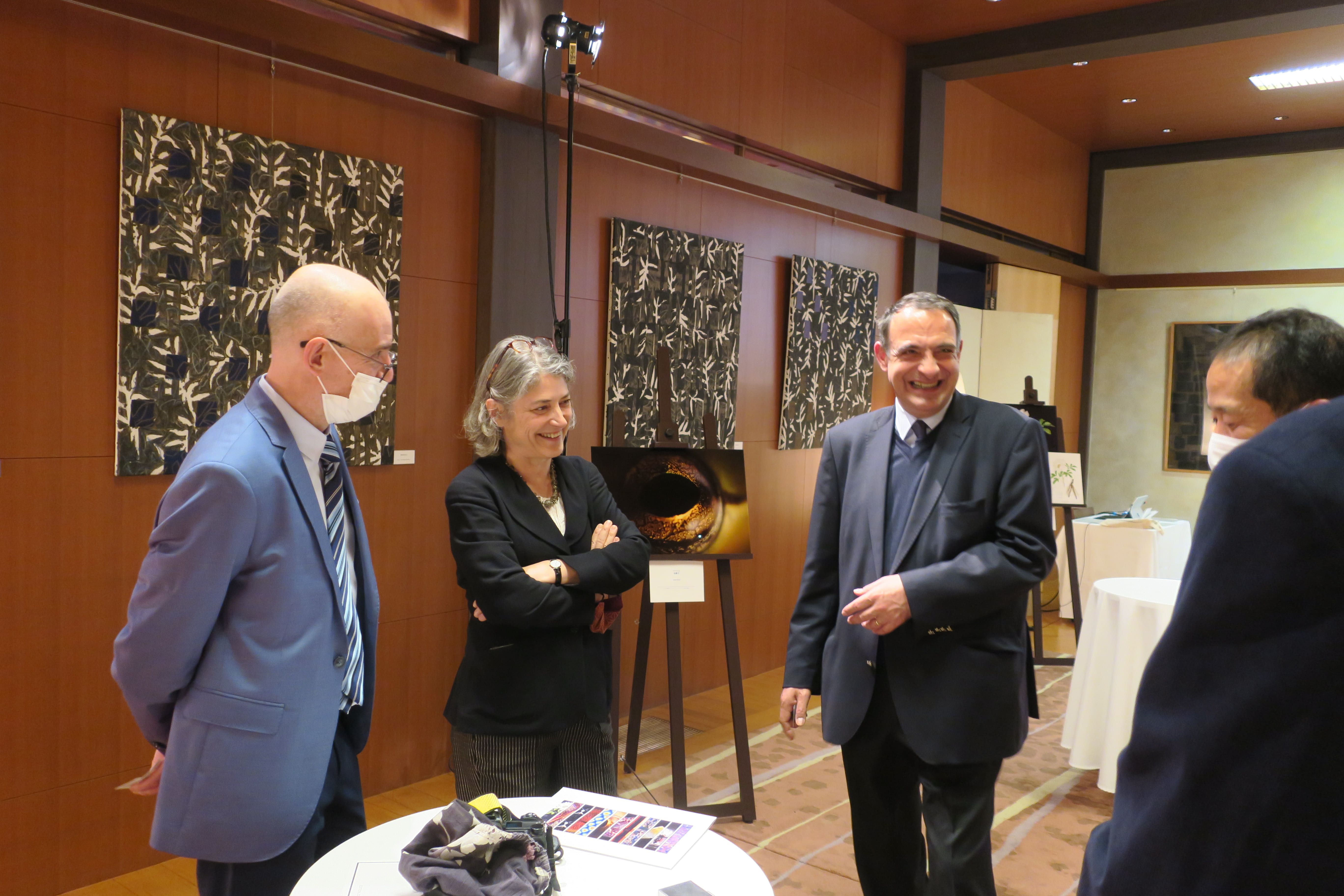 Director Nanba talking with the Ambassador and Embassy staff in front of Andre’s photo
Director Nanba talking with the Ambassador and Embassy staff in front of Andre’s photo
On December 6th, 2022, Director General from IRSN visited the IER, Fukushima University.
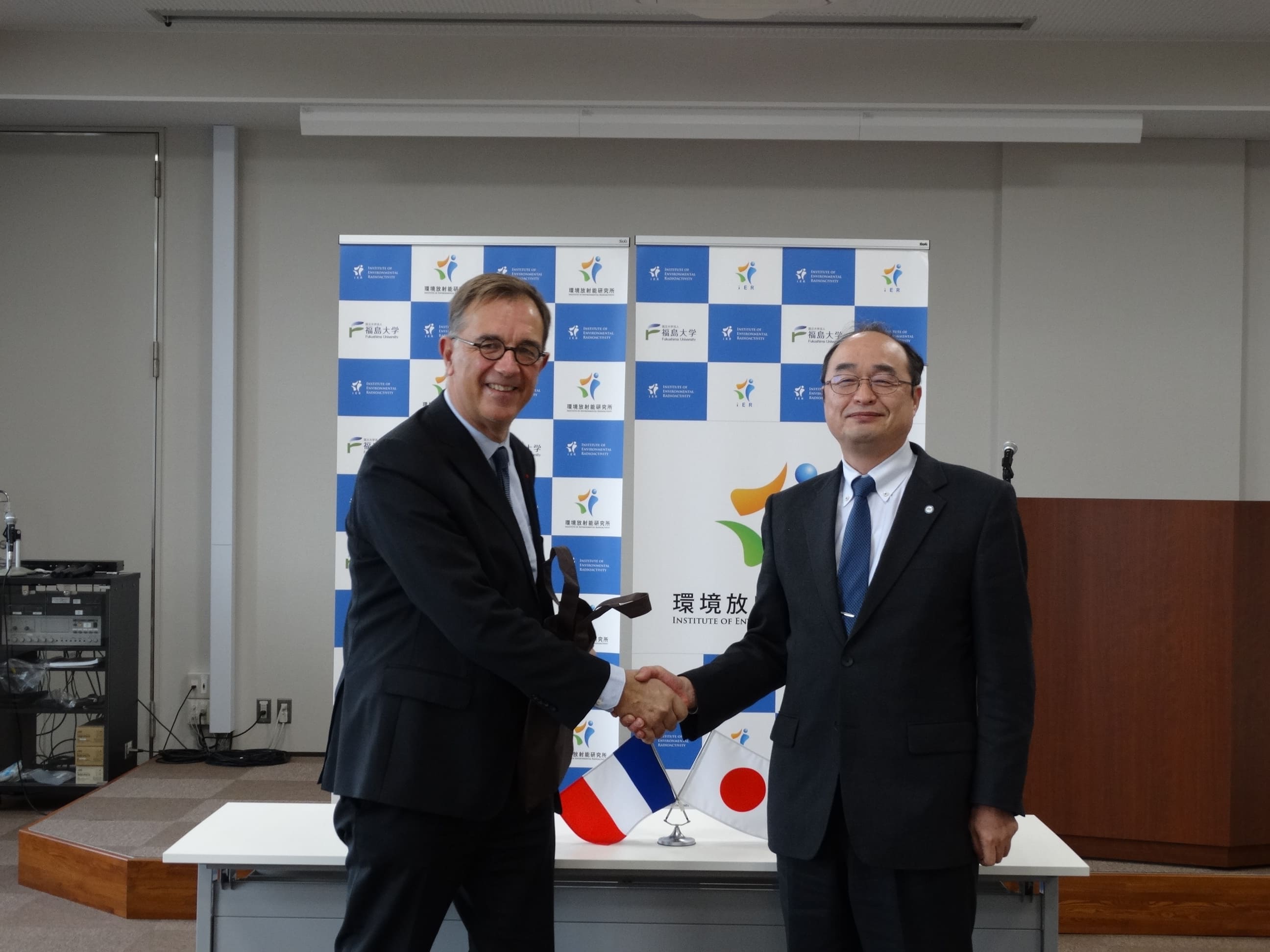 Mr. Jean-Christophe NIEL, Director (Left),
Mr. Jean-Christophe NIEL, Director (Left), and President Miura (right)
On Tuesday, December 6, 2022, Dr. Jean-Christophe NIEL, Director General of the “Institute de Radioprotection et de Sûreté Nucléaire-IRSN”, and Mr. Sylvain PETIT, European and International Cooperation Manager, visited IER, paid a courtesy call on President Miura and met with IER researchers.
During the meeting with the President MIURA Hiroki, the President reiterated his gratitude for IRSN’s support in dealing with the aftermath of the Fukushima nuclear accident, and the Director General expressed his appreciation to Fukushima University for its strong partnership and continued collaborative research in Fukushima.
During the meeting with IER researchers, Director NANBA Kenji, Professor Vasyl YOSCHENKO, Associate Professor WAKIYAMA Yoshifumi, and International Visiting Scholar CHABOCHE Pierre-Alexis from France presented research activities, including ongoing projects (frogs and bees), forest soils expected to be initiated, and a French-Japanese collaboration (Mitate Lab). Both institutes confirmed their plans for the exchanges of researchers with a view to further progress.
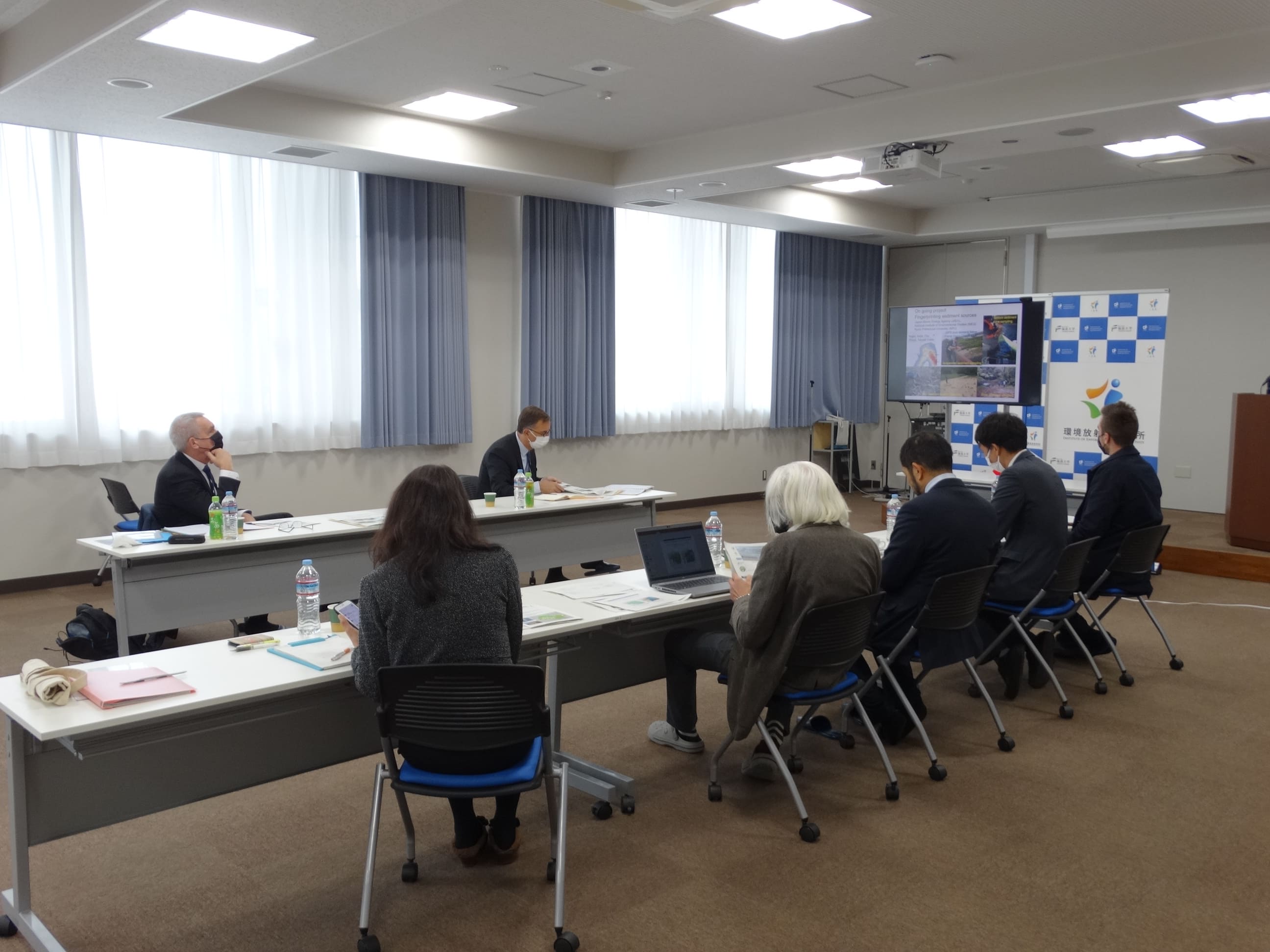 Meeting with IER researchers
Meeting with IER researchers
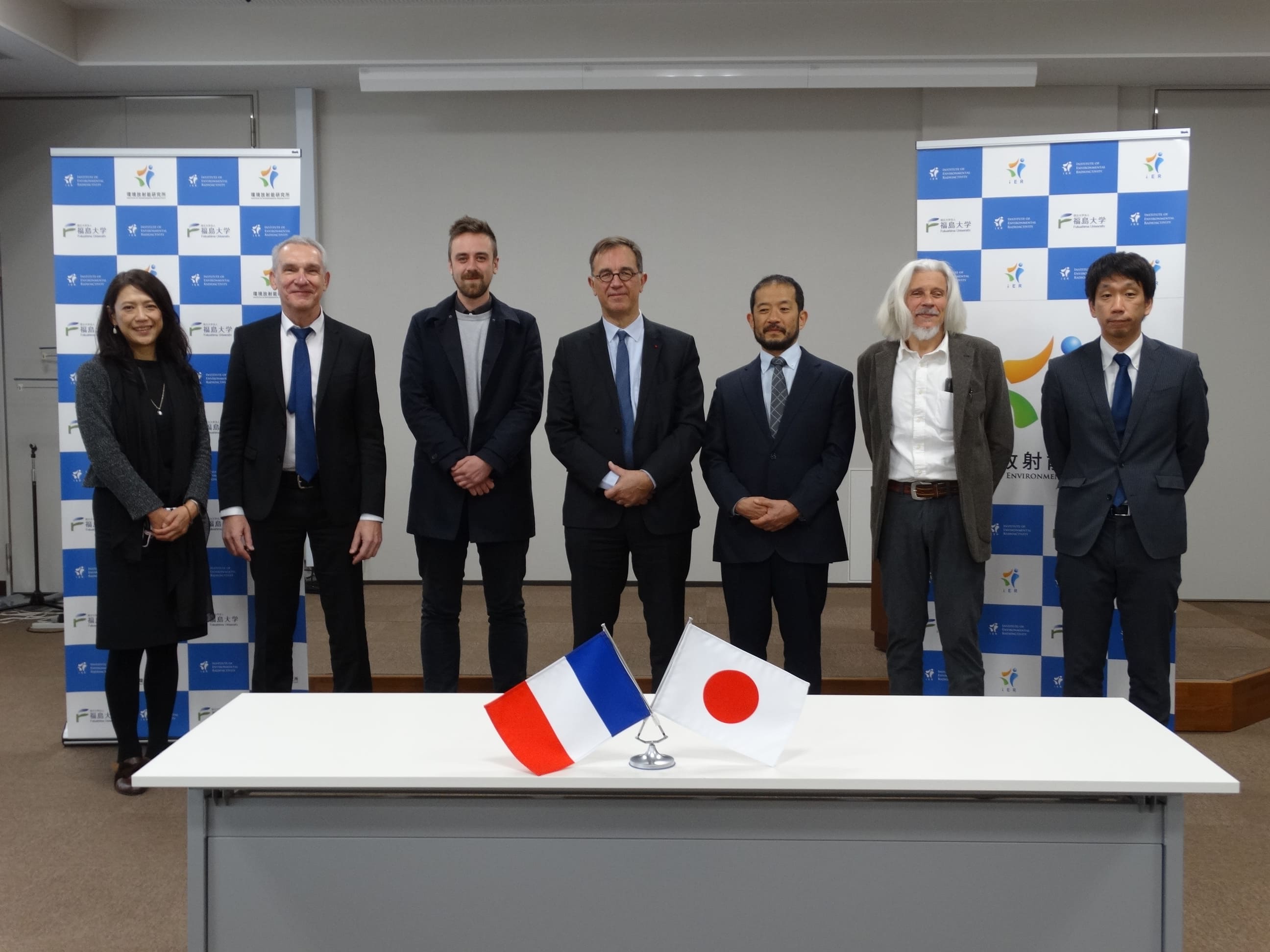
October 29-30, 2022 Special seminar was held in Hamadori
A special seminar titled "Environmental Radioactivity Seminar in Hamadori" was held in Futaba Town, Okuma Town, and Tomioka Town in Hmadori region of Fukushima Prefecture, on October 29 and 30, 2022. This seminar was held in the framework of the “Projects for Human Resource Infrastructure Development utilizing ’Fukkou-Chi / Intellectual Bases for Reconstruction’ of universities”, which is carried out by the Fukushima Innovation Coast Promotion Organization. IER is participating as a co-applicant in one of the projects "Establishment Intellectual Exchange Bases through the Capacity Building in the Field of Disaster and Radiation Medicine Sciences", whose main implementing body is Nagasaki University. Twenty-four students from Fukushima University and Fukushima College of Technology participated in the seminar.
The first day began in a lecture room at the Great East Japan Earthquake and Nuclear Disaster Museum in Futaba Town, where four IER professors gave lectures on the environmental impact of the nuclear accident, and a storyteller from the museum gave a talk.
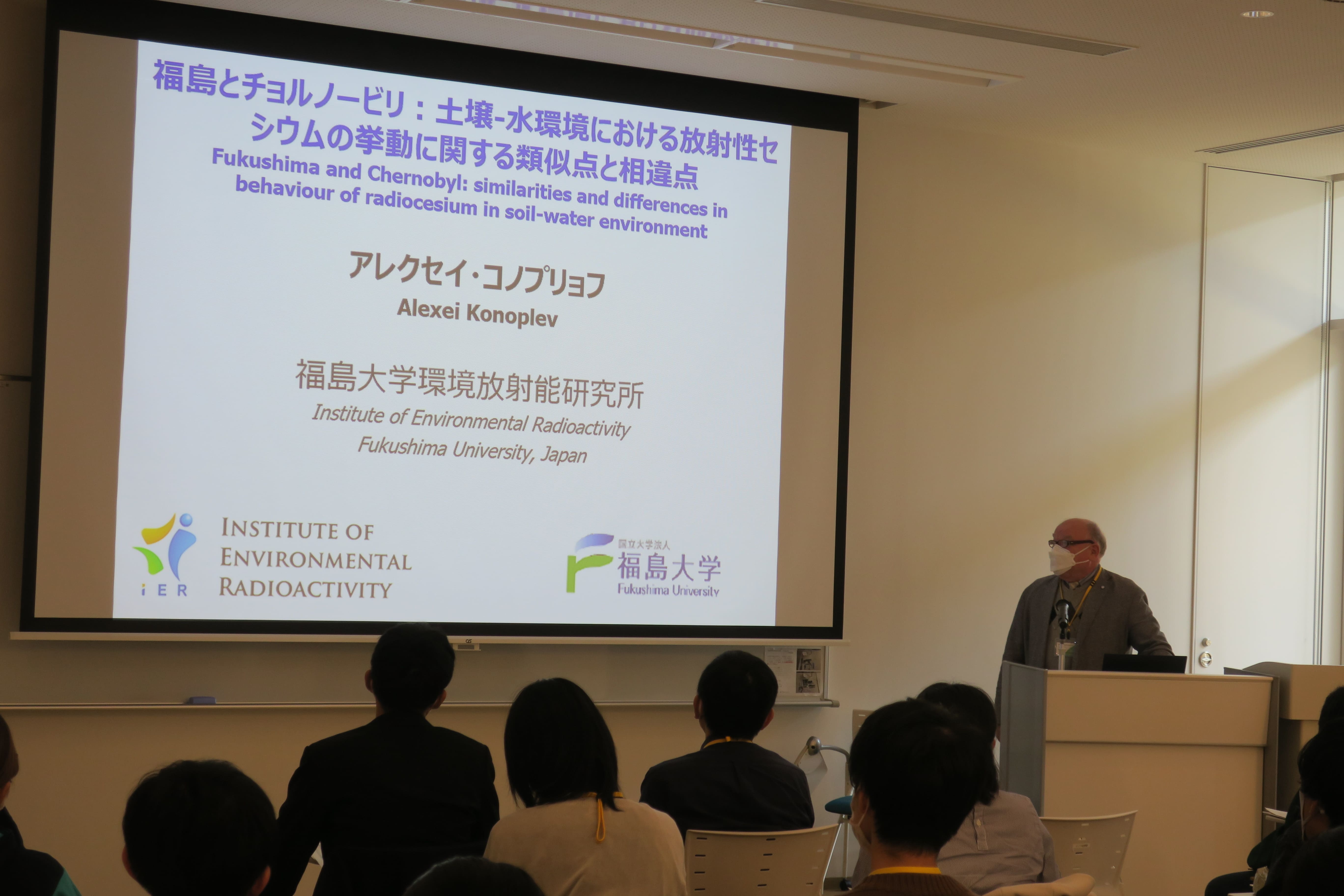
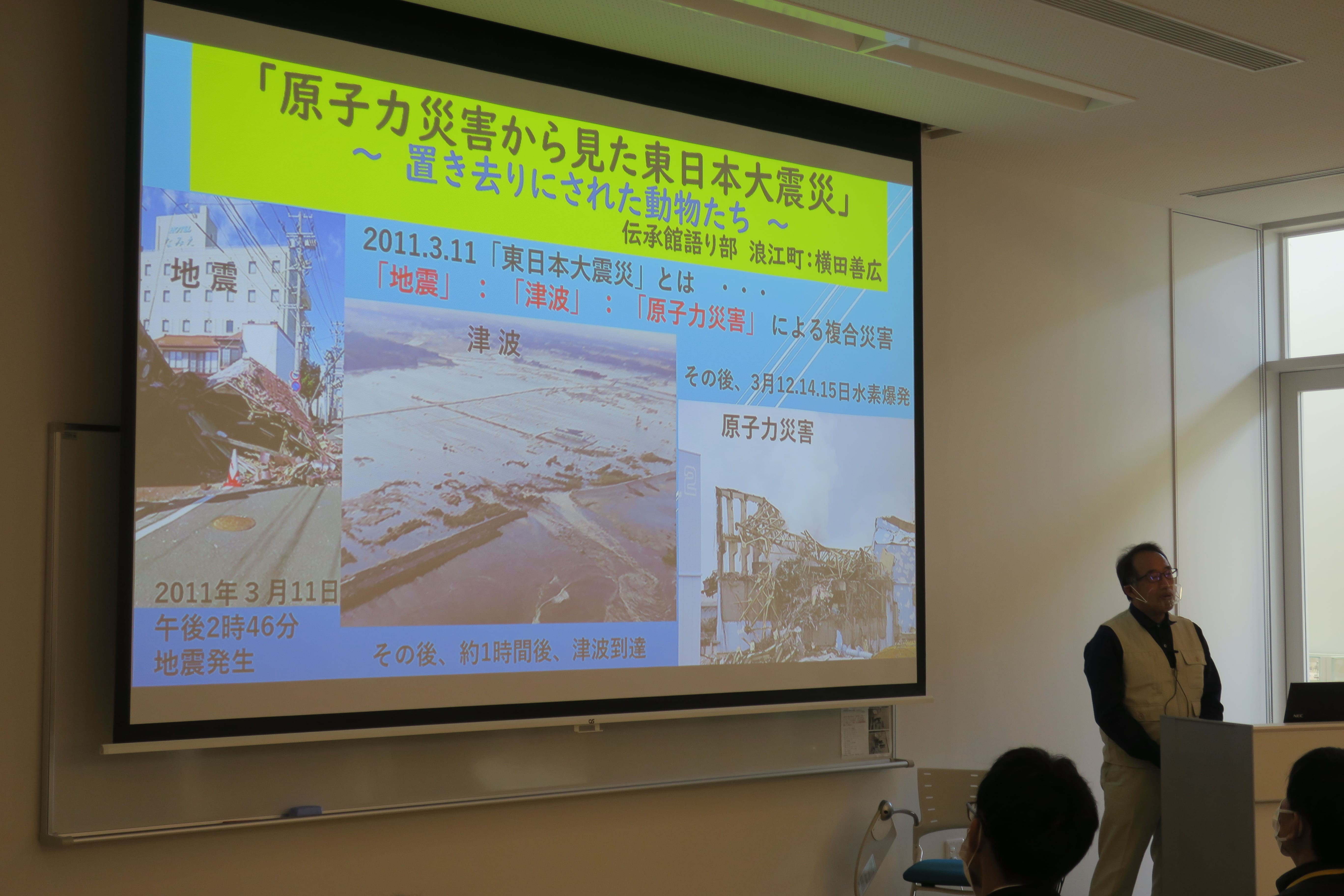
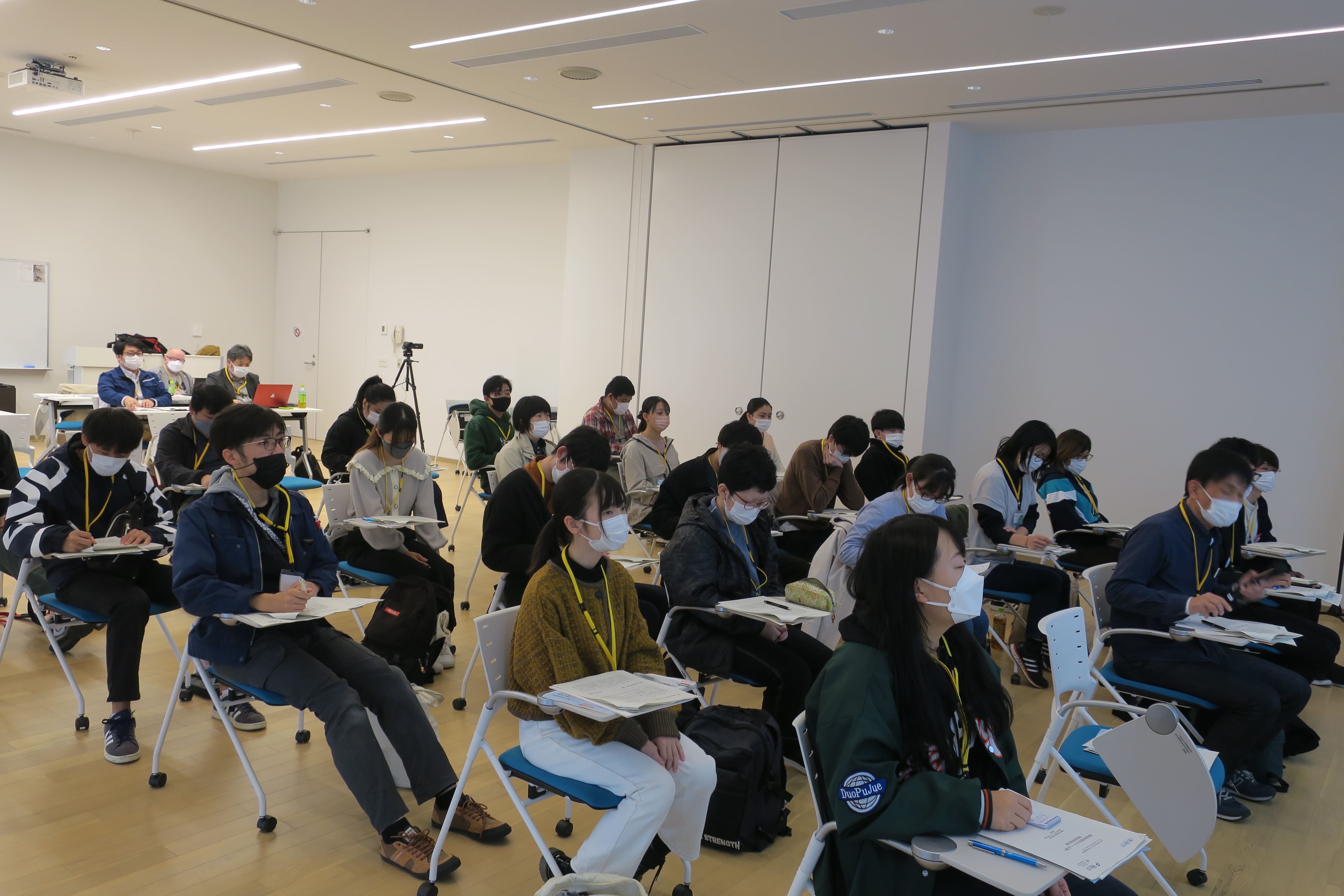
In the afternoon, after visiting the exhibit of the museum, the students toured the area around the Futaba Station and the Interim Storage Construction Information Center. Students asked many questions about the efforts in Futaba Town, where residents have just begun to return home after the accident, and about the disposal of soil removed by decontamination activities.
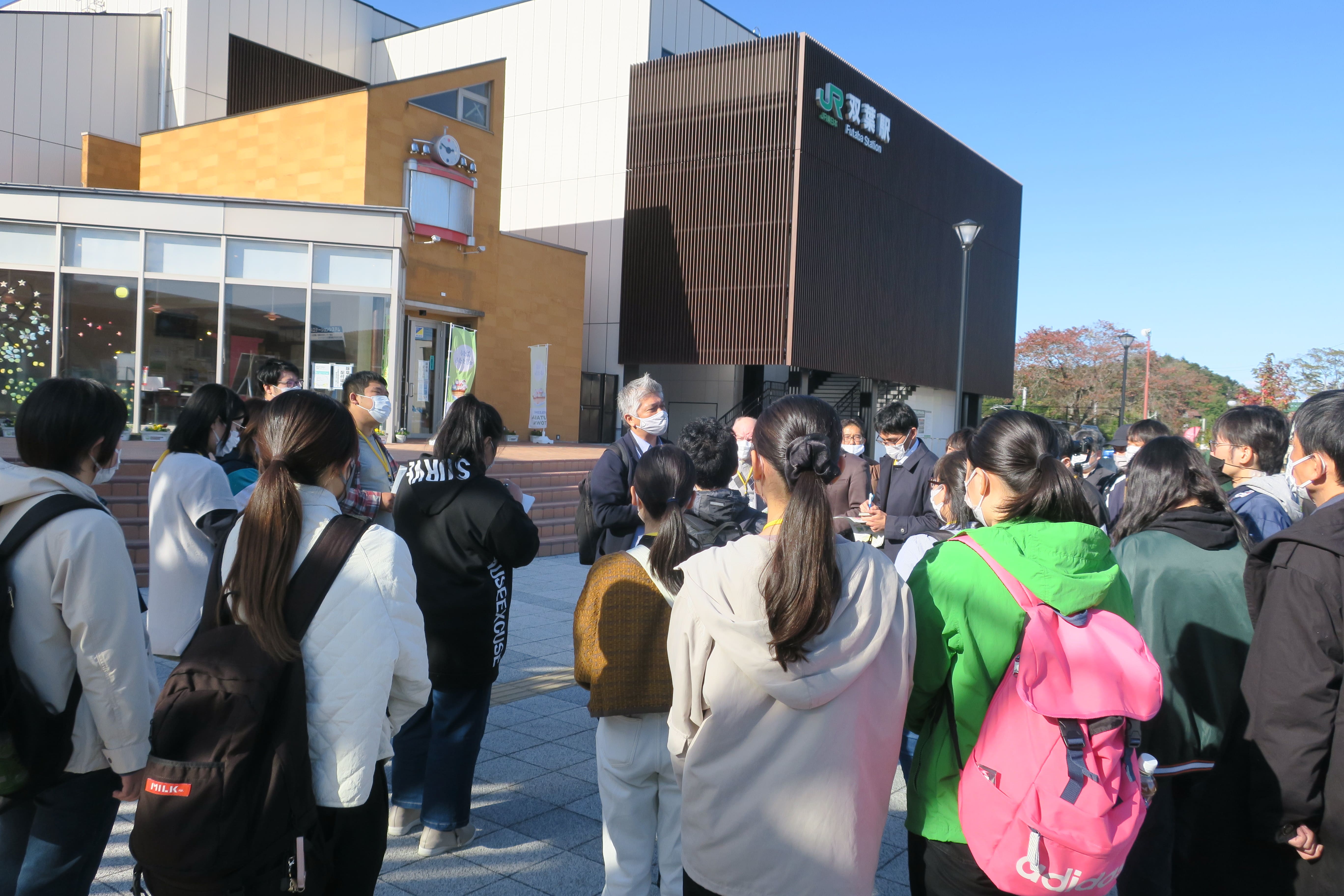 Mr. Hashimoto of Futaba Town Hall
Mr. Hashimoto of Futaba Town Hallintroduced Futaba Town's efforts.
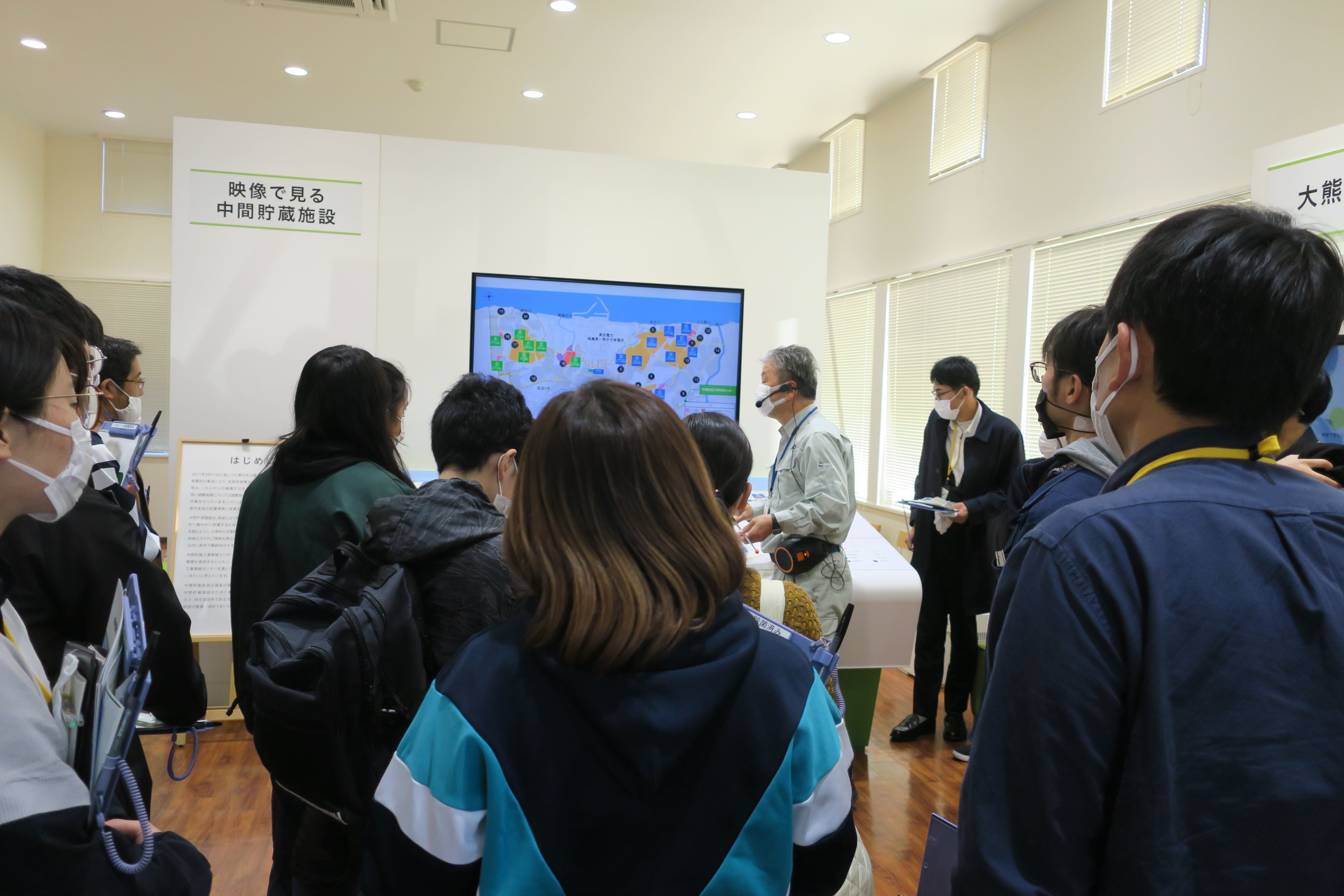 Visited Interim Storage Facility Information Center
Visited Interim Storage Facility Information Center
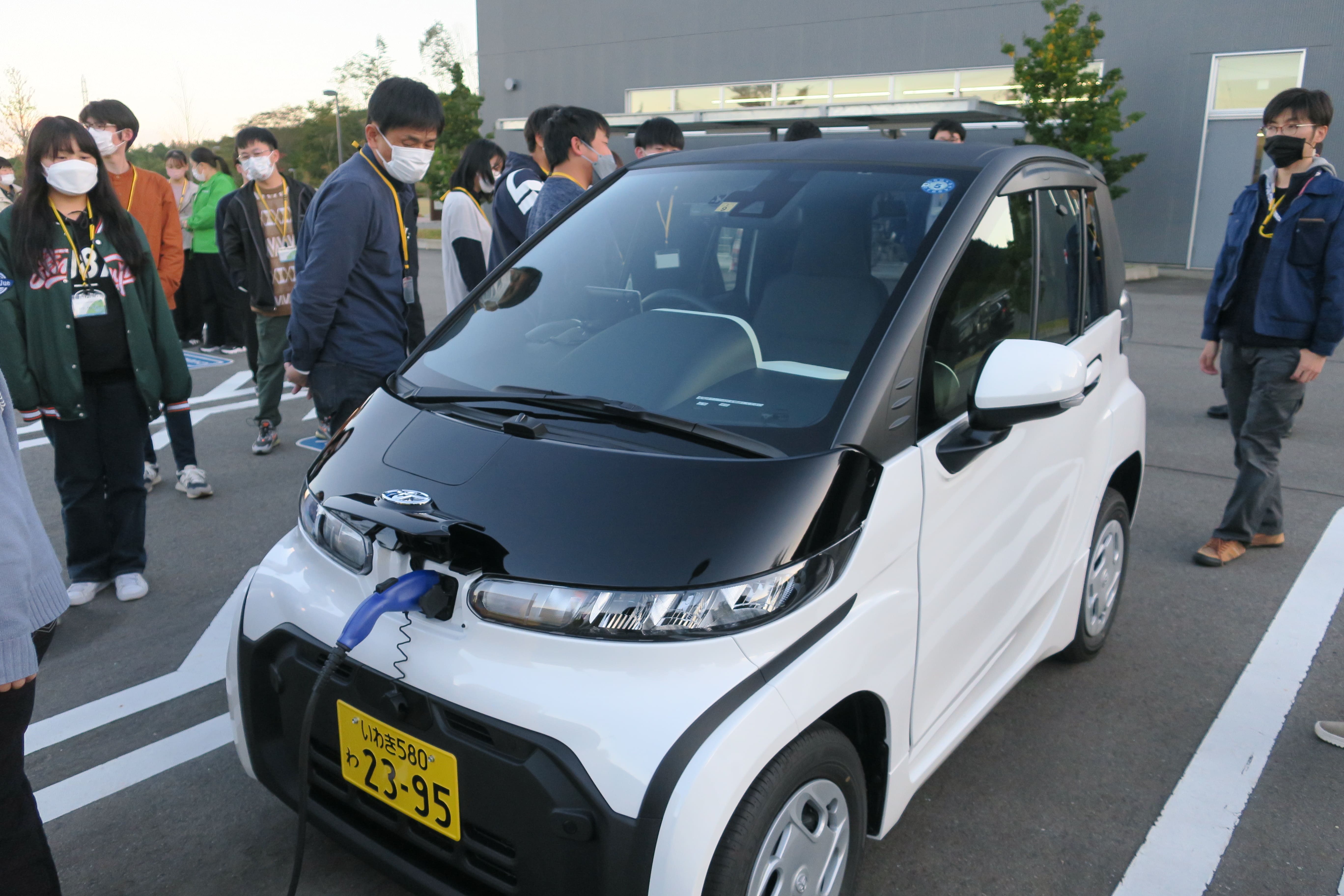 Visited Okuma Town, which aims
Visited Okuma Town, which aims to become a "zero-carbon town”
In the morning of the second day, students visited TEPCO Decommissioning Archive Center and Historical Archive Museum of Tomioka. In the afternoon, graduate students in the sciences gave research presentations and students from both the humanities and science had group discussions. The participants commented that they were able to learn about various view points and different perceptions of radioactivity through the discussions.
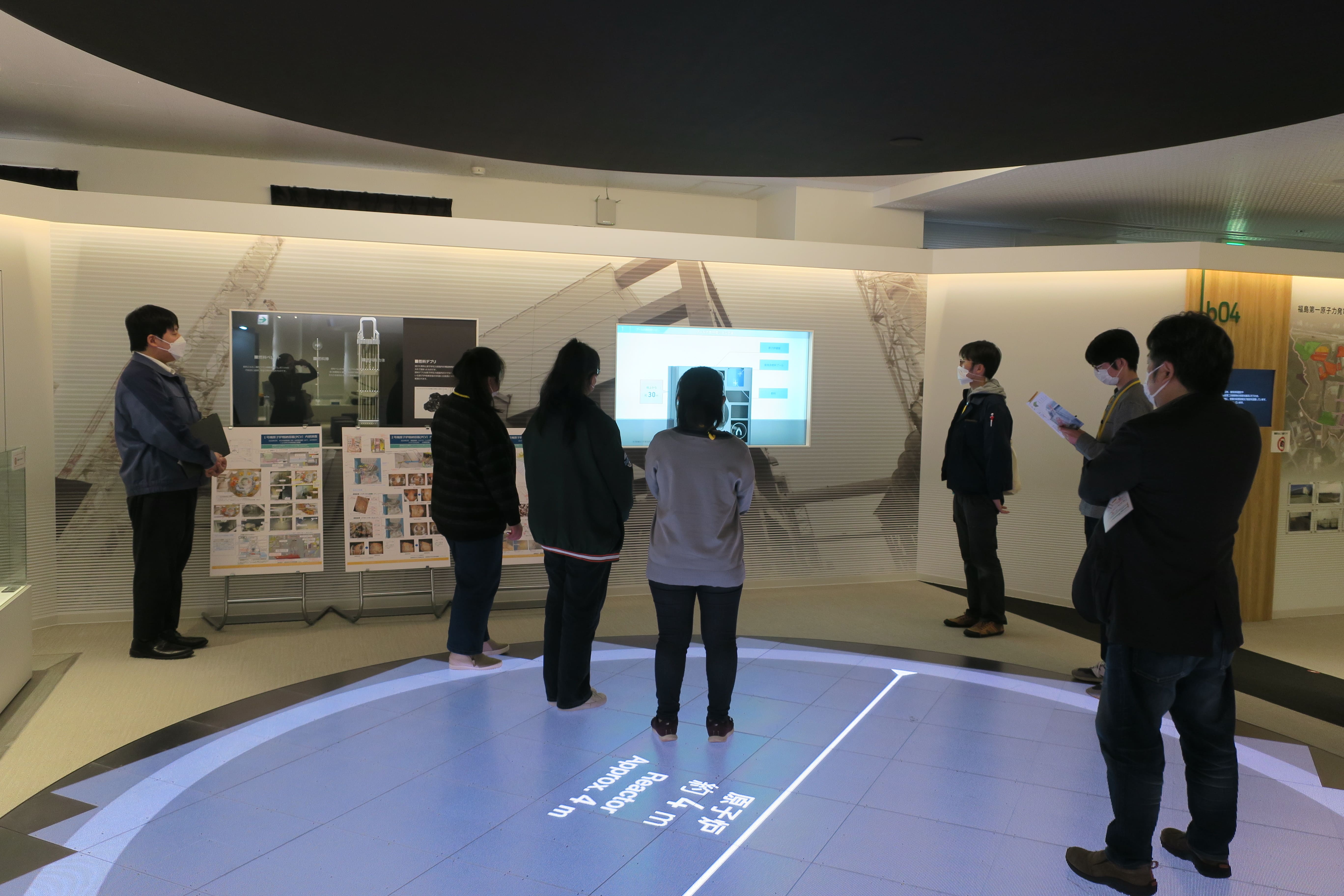 TEPCO Decommissioning Archive Center
TEPCO Decommissioning Archive Center
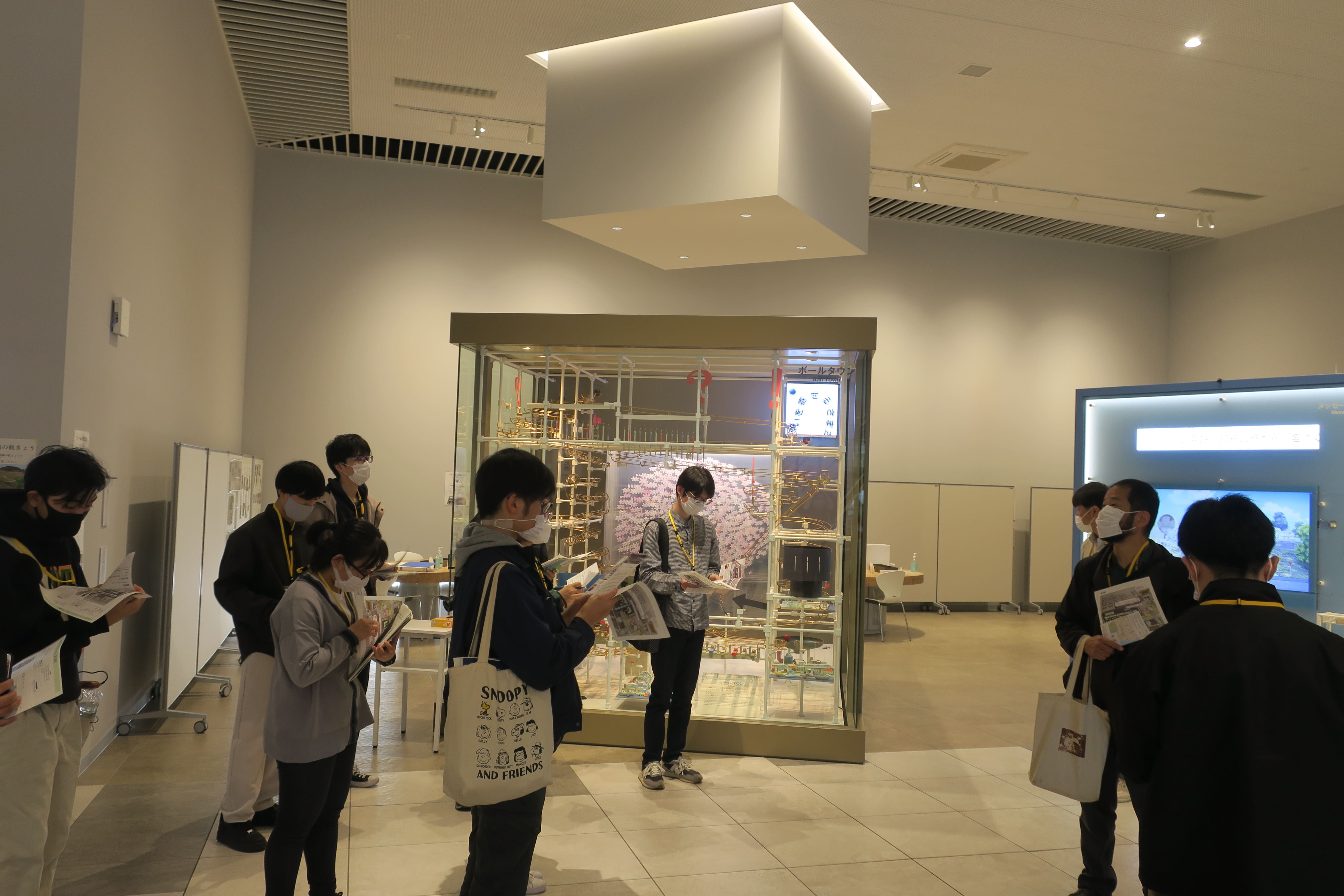 The Historical Archive Museum of Tomioka
The Historical Archive Museum of Tomioka
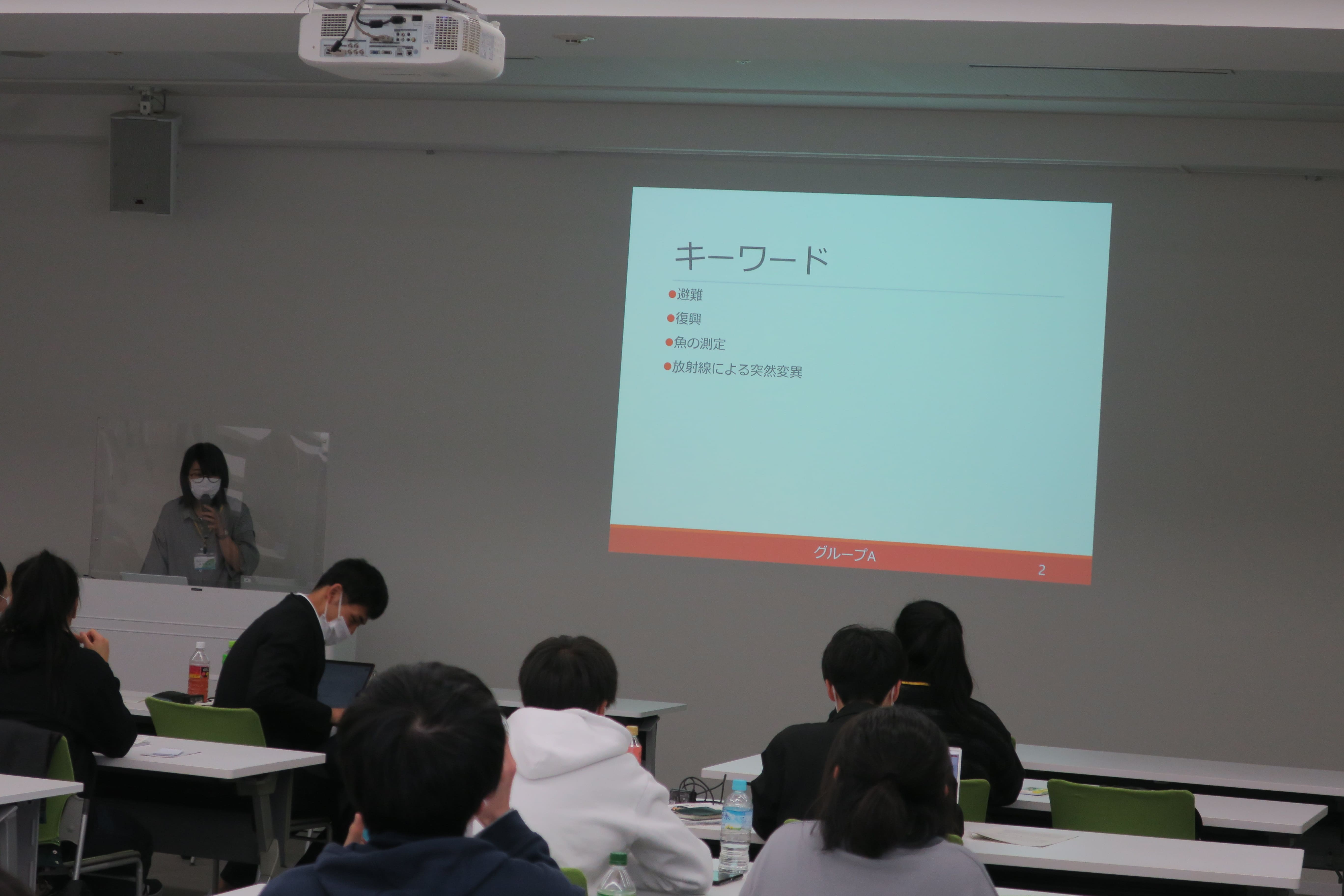 Research presentations by science graduate students.
Research presentations by science graduate students.Many questions were raised by humanities students as well.
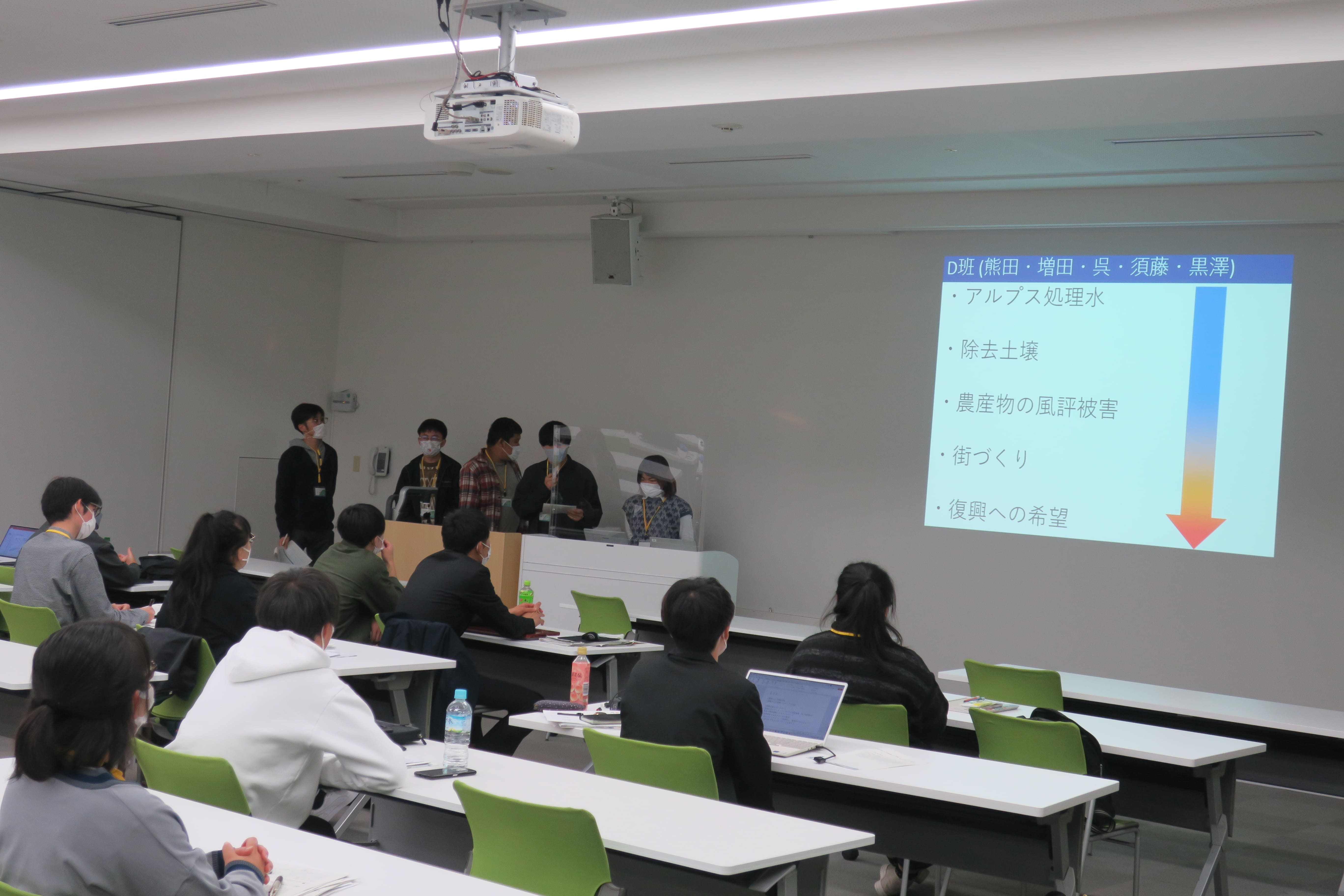 Presentations after group discussions
Presentations after group discussions
IER hopes to continue to provide students with opportunities to see and hear firsthand the current situation in the areas affected by the nuclear accident, and to be involved in the development of human resources who can contribute to the reconstruction of the Hamadori region.
September 26, 2022 We held the 4rd IER Seminar in-person and online Zoom participants.
<Project Researcher, KANASASHI, Associate Professor, WADA>
| Date & Time: | Mon. September 26, 2022, 2:00 p.m. - 3:00 p.m. |
|
Speaker (In order of presentation): |
Project Researcher, KANASASHI Tsutomu Associate Professor, WADA Toshihiro (Presentation order) |
| Presentation Title: |
Lepidostomatidae larvae uptake 137Cs from leaves and excrete particulate materials with 137Cs in streams (KANASASHI) Remaining issues for Fukushima’s fisheries recovery and application of biology tags to track the horizontal / vertical movements of flatfish (WADA) |
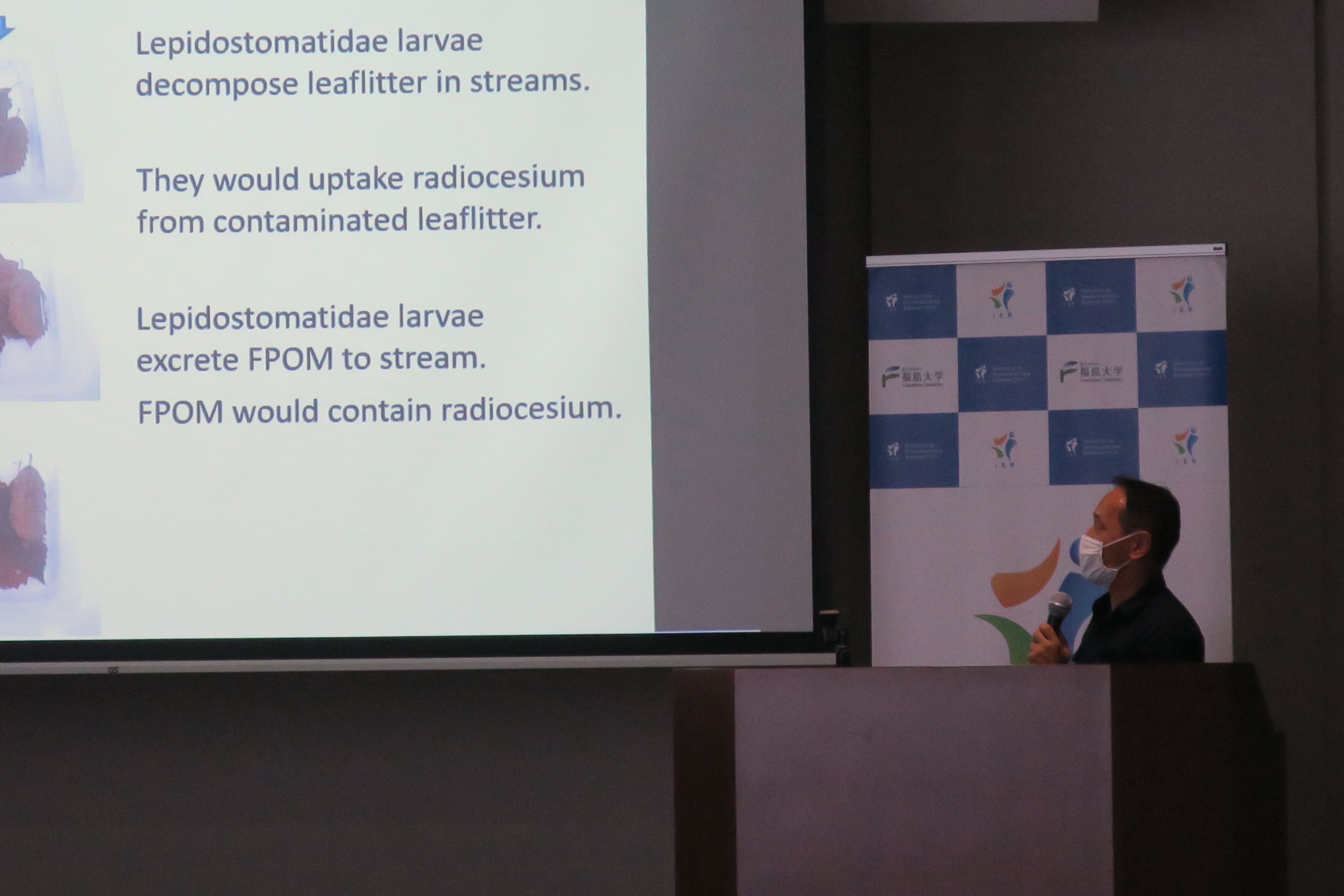 Project Researcher Kanasashi
Project Researcher Kanasashi
Institute of Environmental Radioactivity (IER) regularly holds the IER seminar in which the faculty members report on their research results, with the aim of facilitating their research activities and promoting communication.
The fourth IER Seminar in this fiscal year was held on September 26 with two presentations by Project researcher KANASASHI Tsutomu and Associate Professor WADA Toshihiro. The seminar was attended by 20 researchers and graduate students, including online attendees.
Project Researcher KANASASHI presented about variations of radiocesium concentration in processes eating leaflitter and excreting particulate materials by larvae of Lepidostomatidae in headwater streams. To clarify this variation will be important to understand radiocesium transferring from riparian forests to headwater streams. Laboratory experiment showed that the larvae had lower 137Cs concentration than the leaflitter and particulate materials, and the particulate materials had higher 137Cs concentration than the leaflitter. These results speculated that the larvae absorbed and accumulated more essential nutrient substances than 137Cs from the leaflitter. This experiment will be continued to accumulate data, and elements’ concentration in the leaflitter, larvae, and particulate materials will be measured and analyzed.
Associate Professor WADA made a presentation on remaining issues for Fukushima’s fisheries recovery and application of depth-temperature archival tags to track the horizontal/vertical movements of flatfish. Major problems such as tsunami damage to fisheries-related facilities and radiocesium contamination of marine products after the FDNPP accident have almost been settled . However, it is extremely important for the full recovery of fisheries in Fukushima to assess the potential risk of migration of contaminated fish in the FDNPP port. He has then developed a method to track the horizontal/vertical movements of spotted halibut by using the archival tags. By analyzing data of recaptured fish attached with the tag, he was able to track the horizontal and vertical movement of fish, and also to obtain evidence that fish can migrate into and out from the FDNPP port. In the future, the developed method will be applied to other fish like tiger puffer.
After the presentation, various questions and opinions were exchanged among participants.
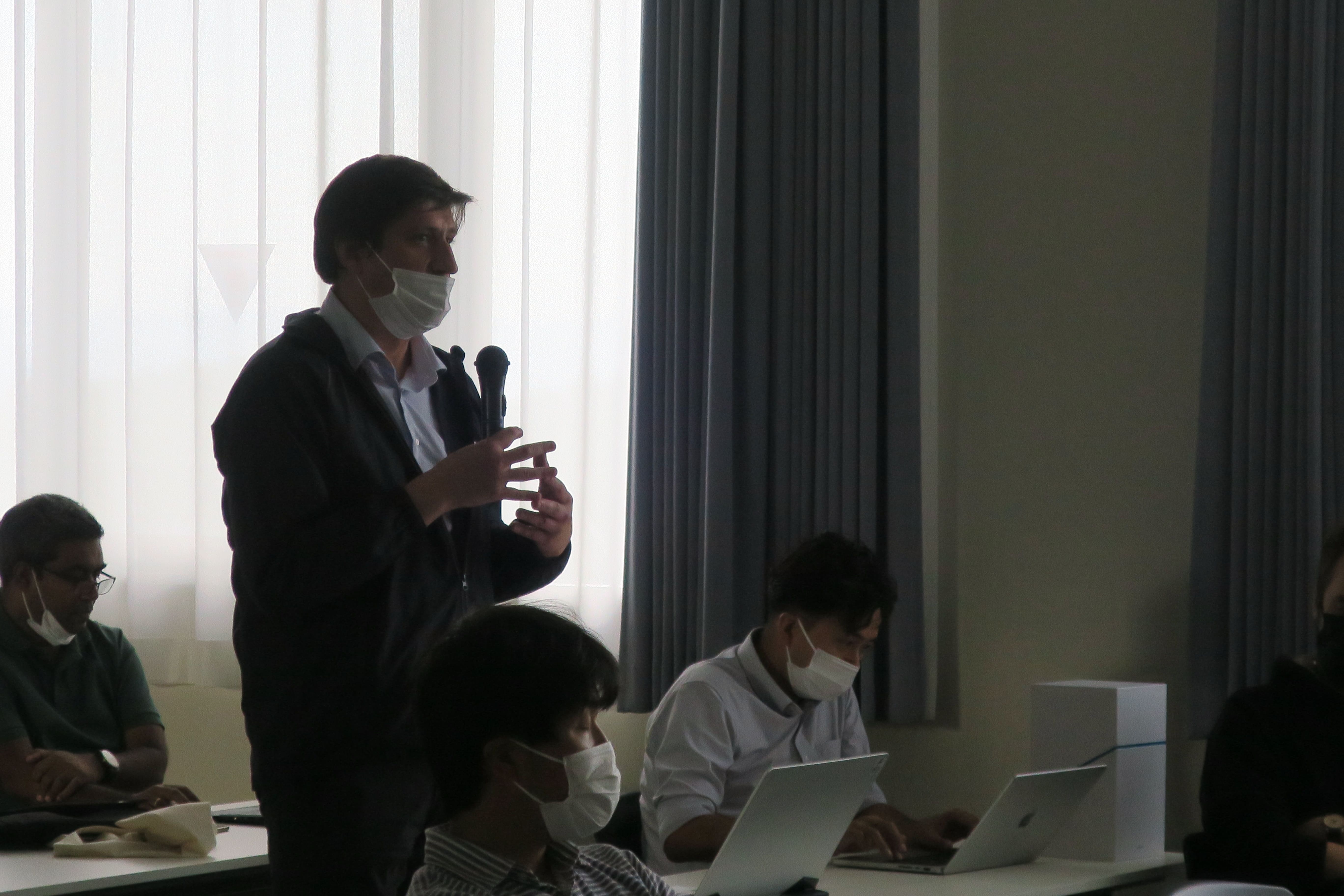 Associate Professor Wada
Associate Professor Wada
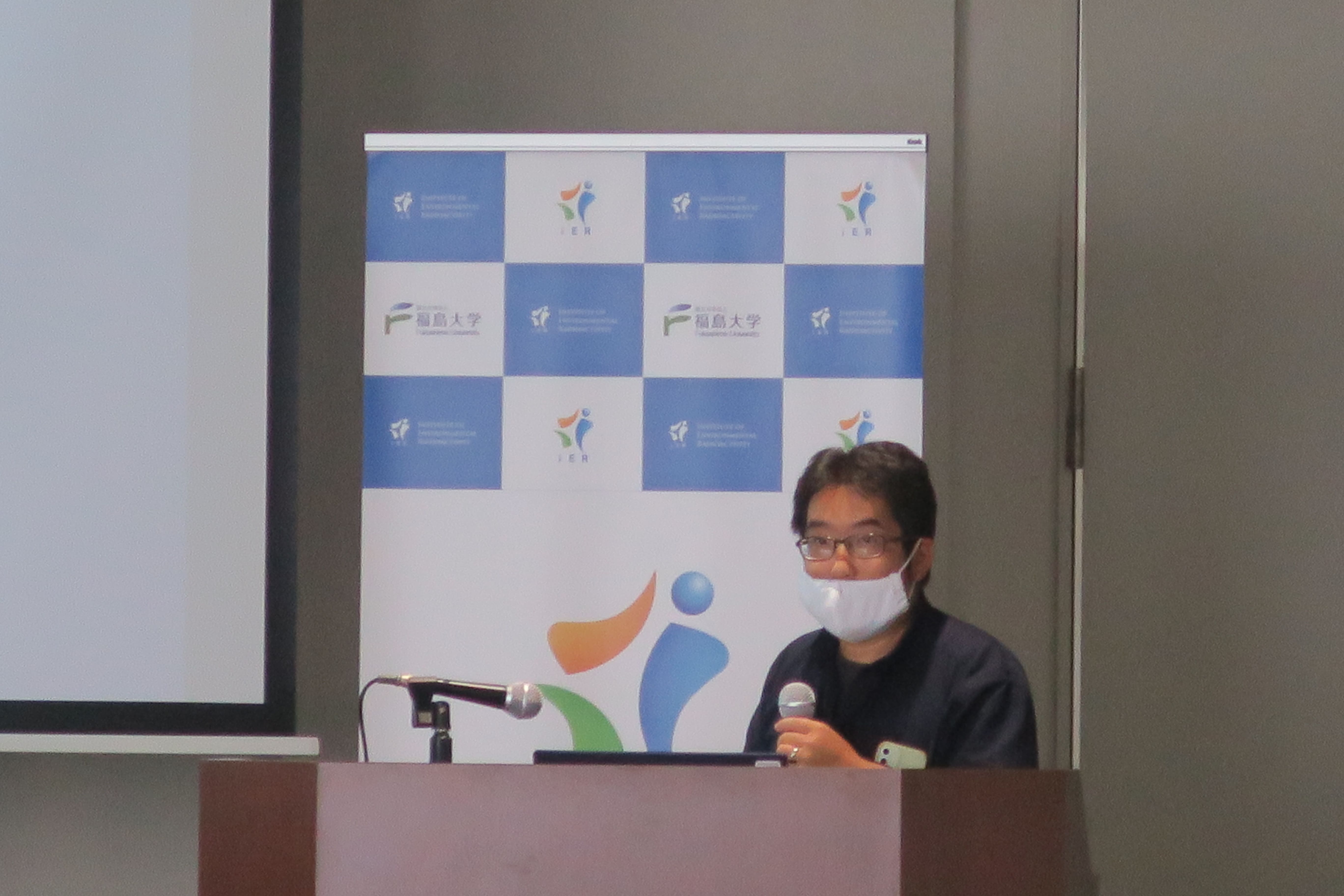 Questions and answers time
Questions and answers time
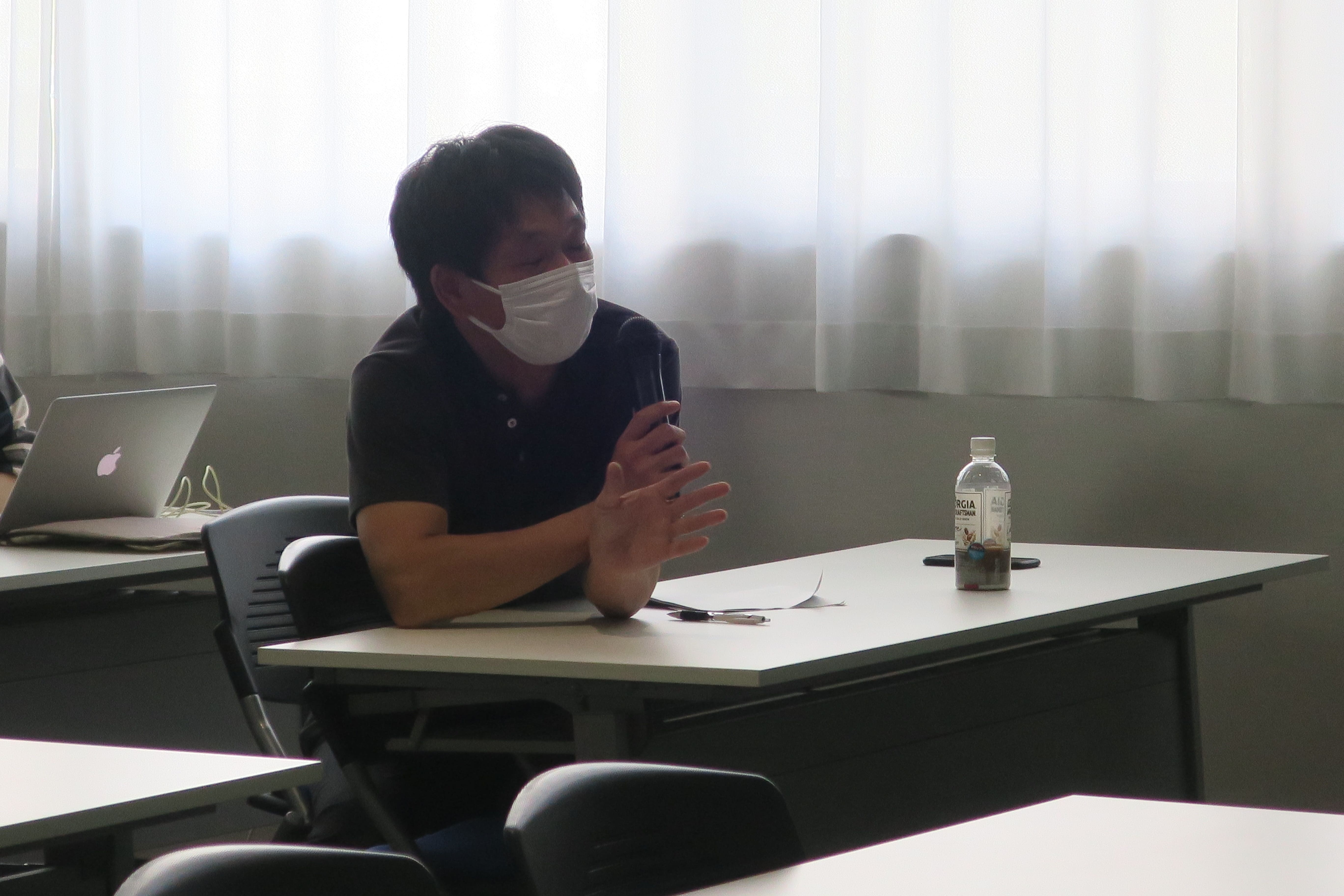
August 29, 2022 We held the 3rd IER Seminar in-person and online Zoom participants.
<Dr. CHABOCHE, Project Associate Professor TAKATA, Professor KANEKO>
| Date & Time: | Mon. August 29, 2022, 2:00 p.m. - 4:00 p.m. |
|
Speaker (In order of presentation): |
Dr. CHABOCHE Pierre-Alexis (JSPS Postdoctoral Fellowships for Research in Japan) Project Associate Professor, TAKATA Hyoe Professor of Faculty of Food and Agricultural Sciences, KANEKO Nobuhiro |
| Presentation Title: |
Refining fallout radionuclide baseline data to reconstruct soil redistribution rates in agricultural catchments of South America Quantifying the riverine sources of sediment and radiocesium in the Pacific Ocean (Fukushima Pref.) (CHABOCHE) Distinct distribution of radio-Cs in river-sea system (TAKATA) Mycoextraction of radio-cesium and rehabilitation of Satoyama (KANEKO) |
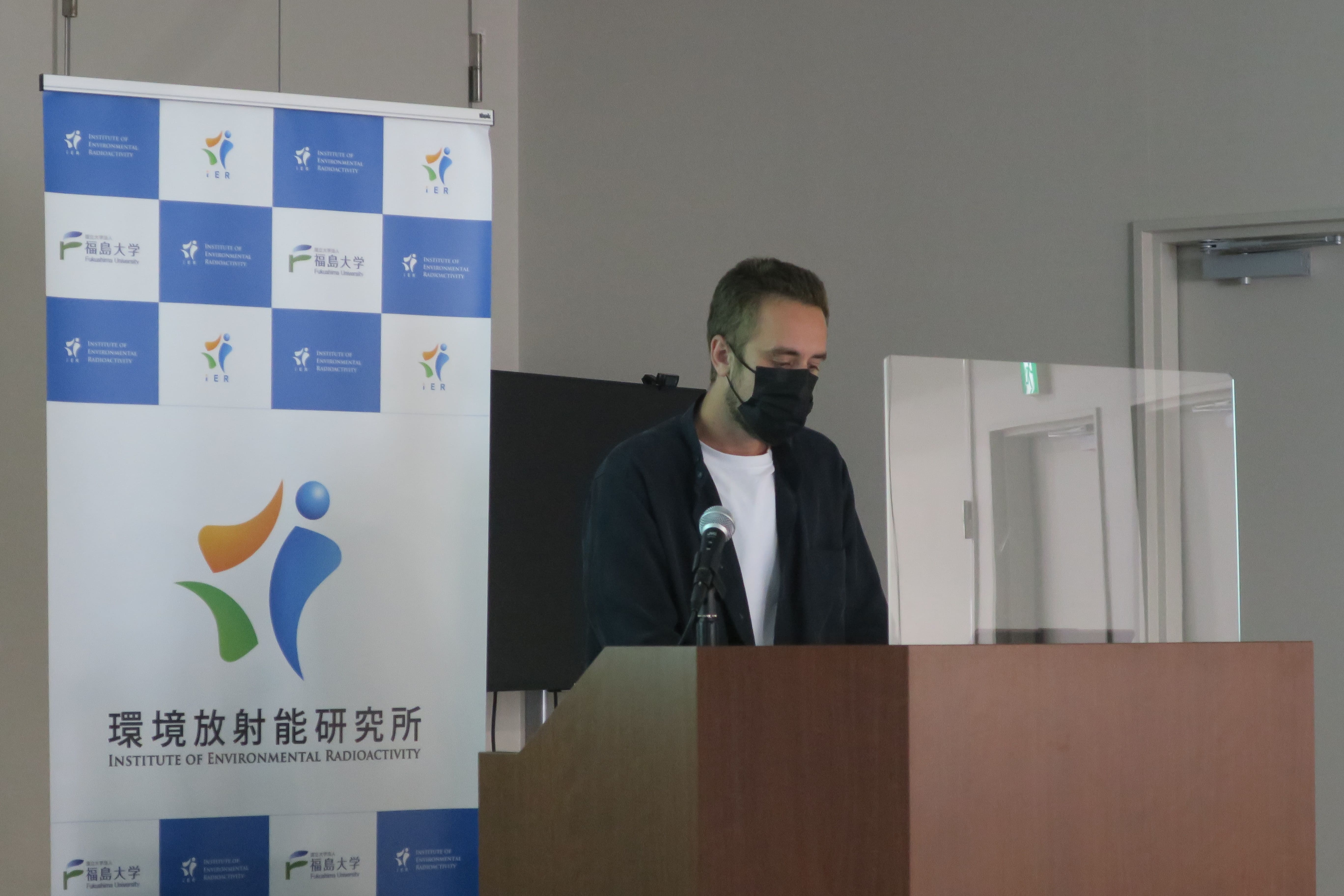 Dr. CHABOCHE, Visiting Scholar
Dr. CHABOCHE, Visiting Scholar
Institute of Environmental Radioactivity (IER) regularly holds the IER seminar in which the faculty members report on their research results, with the aim of facilitating their research activities and promoting communication.
The 3rd IER Seminar in this fiscal year was held on August 29, and presentations were given by Dr. CHABOCHE, a FU international visiting scholar from France (JSPS Postdoctoral Fellowships for Research in Japan), Dr. TAKATA (Project Associate Professor), and Dr. KANEKO (Professor of Faculty of Food and Agricultural Sciences). The seminar was attended by 29 researchers and graduate students, including online attendees.
Dr. Chaboche presented the research he conducted during his PhD in France on the use of artificial radionuclides (137Cs and plutonium isotopes) to reconstruct soil redistribution rates in intensive agricultural catchments of South America. He explained the methodology used to create the first map of bomb-derived 137Cs fallout in soils of continental South America, which can be used as a powerful reference dataset to anticipate the order of magnitude of 137Cs inventories in undisturbed soil profiles of the continent, and for numerous other applications in Earth Sciences. In addition, he presented the research he conducted on refining the chronology of radionuclide fallout in the continent by using plutonium isotopes (239Pu, 240Pu), a powerful marker to date environmental archives and conduct climatic and environmental reconstructions. Finally, he introduced the research he has been conducting at the IER since in arrival on Japan regarding the quantification of sources of river sediments and associated radiocaesium in the Pacific Ocean, along the coast of the Fukushima Prefecture.
Project Associate Professor TAKATA explained that the results of measuring rCs concentrations in water collected from Tomioka River and Tomioka Port showed that there was almost no difference between river water and seawater in the dissolved state, but in the suspended particles, seawater was about 1/3 of river water, indicating the sorption behavior change, and seawater was 1/4 of river water in Kd values, indicating some desorption behavior. As a result of the sequential extraction of rCs by fractions (ion-exchangeable, organically bounded, and refractory), the iron-exchangeable fraction had lower values than expected for river water so it is necessary to continue clarifying the relationship between adsorption behavior and river velocity, characteristics of suspended particles, and other factors.
Professor Kaneko specializes in soil ecology in the Faculty of Food and Agricultural Sciences. In the seminar, he presented an efficient decontamination method for forest soils. He explained that a litter-bag study (litter leaves are placed in mesh bags and placed on the forest floor, where they are decomposed by microorganisms) on radioactive contamination in the soil food web of a forest ecosystem showed that radiocesium was adsorbed on litter leaves more than expected, and that when wood chips made from forest trees are laid on the ground, fungi grow on the chips and transfer radiocesium from the soil to the chips.
After the presentation, various questions and opinions were exchanged among participants.
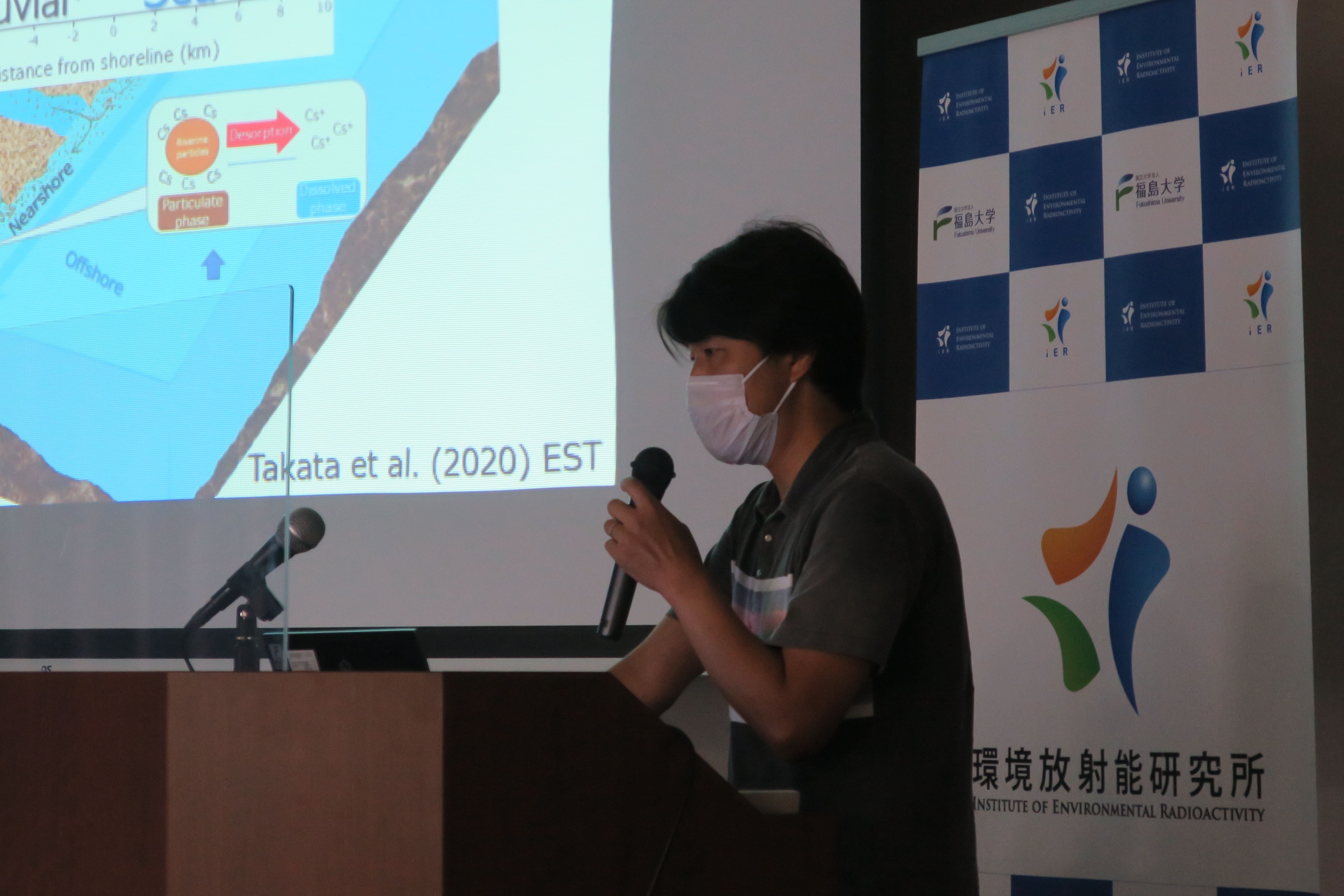 Dr. TAKATA, Project Associate Professor
Dr. TAKATA, Project Associate Professor
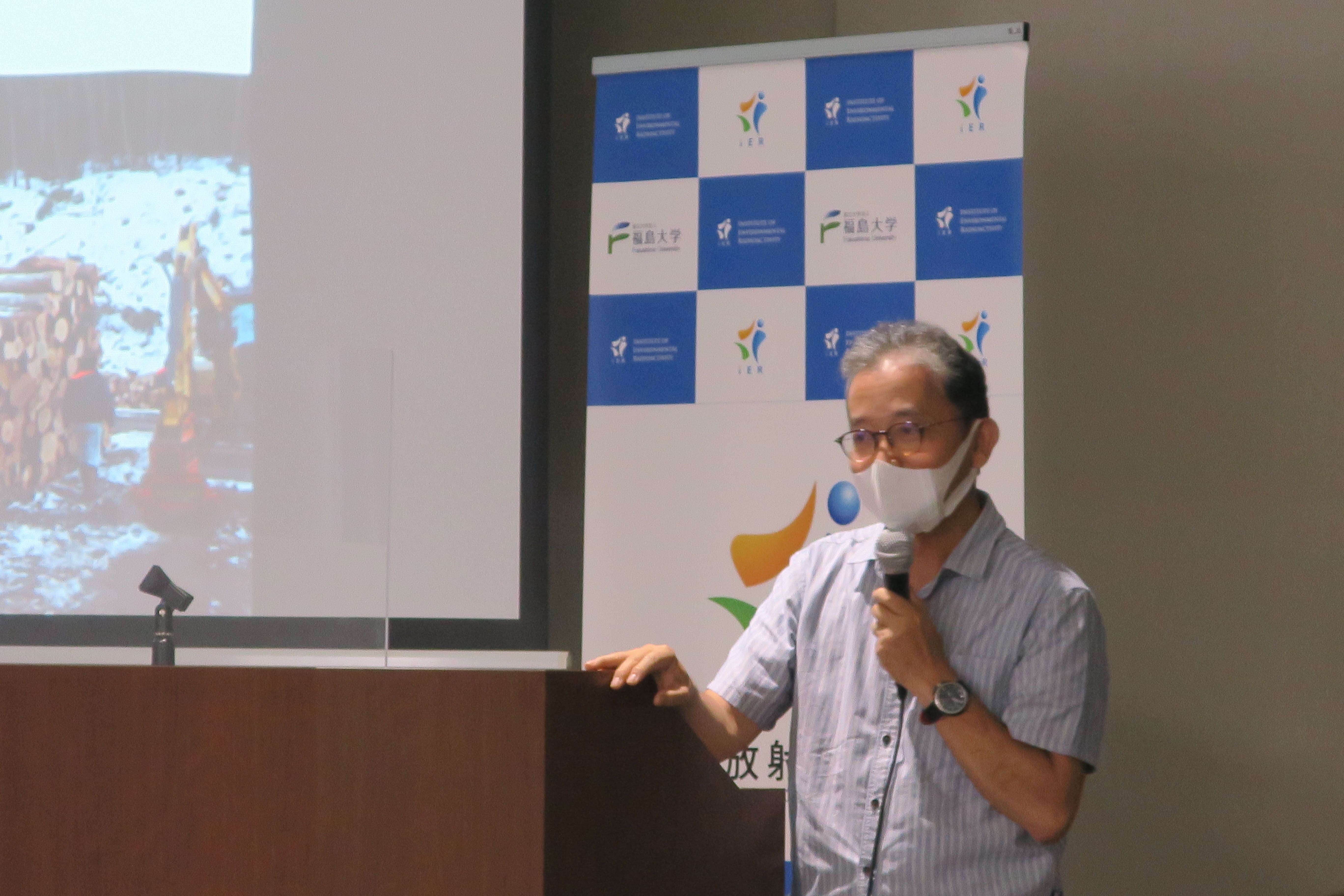 Dr. KANEKO, Professor of Faculty of Food and Agricultural Sciences
Dr. KANEKO, Professor of Faculty of Food and Agricultural Sciences
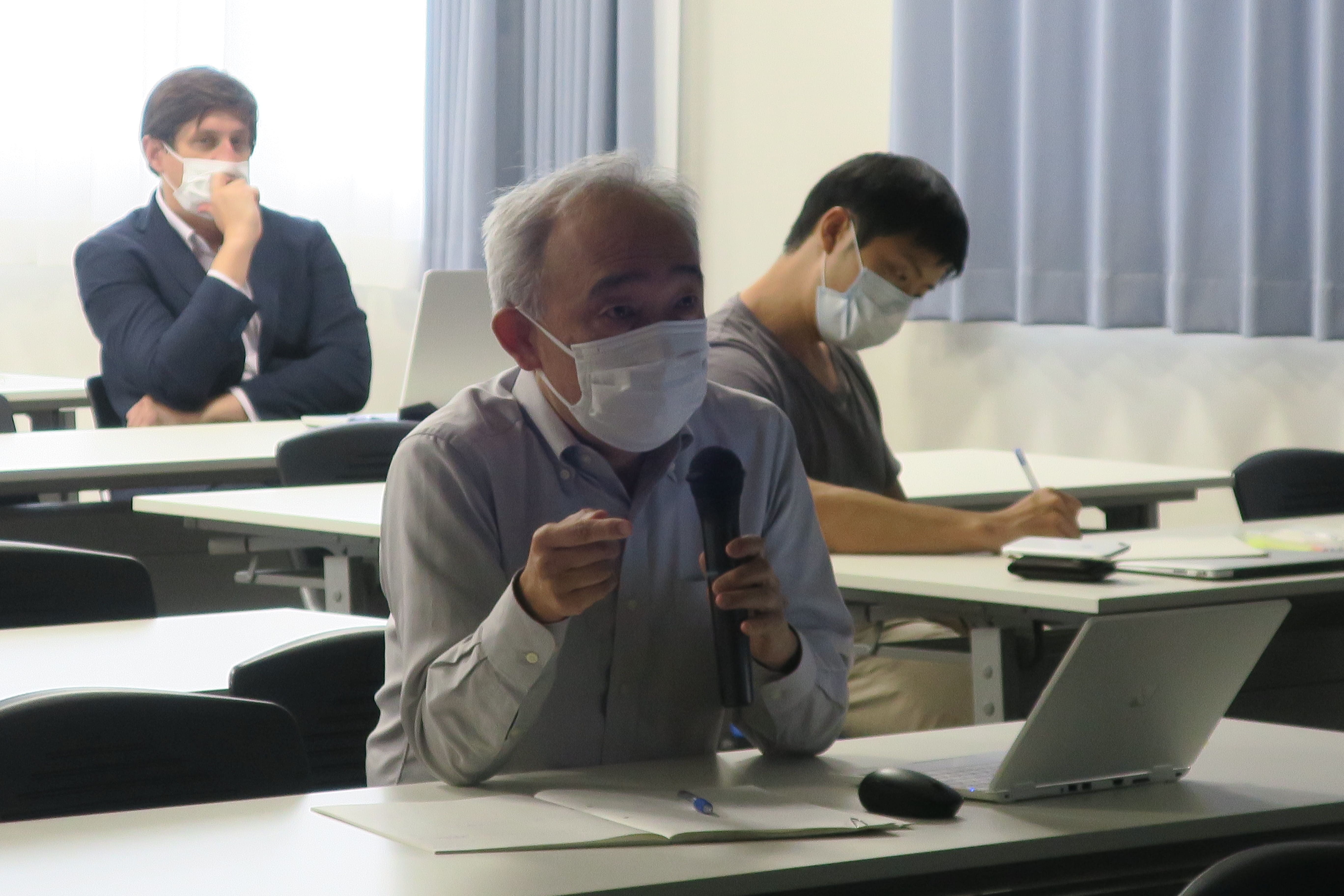 Questions and answers time
Questions and answers time
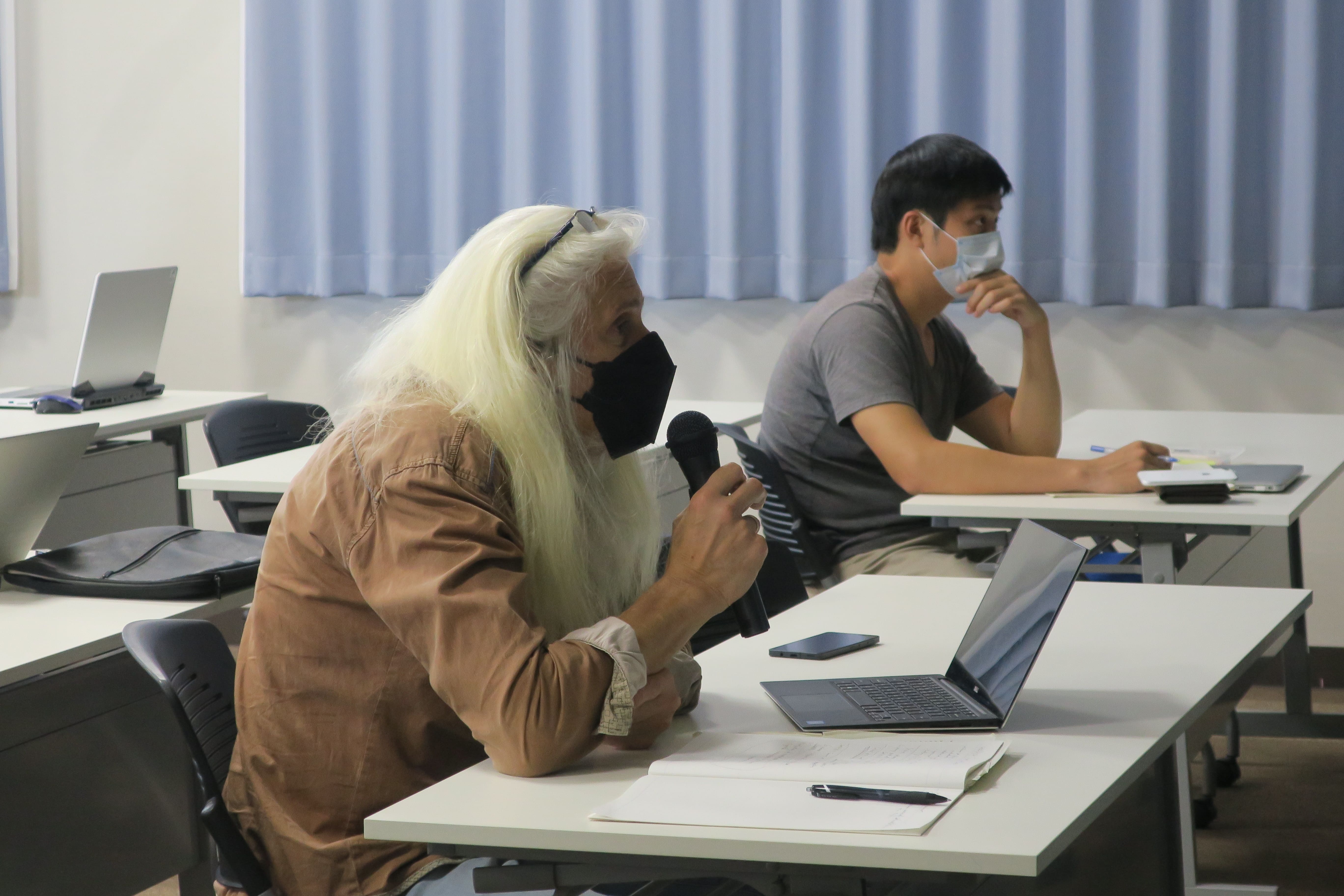
October 31, 2022 The 6th IER seminar was held.
〈Professor Tsukada, Associate Professors Hirao and Wakiyama〉
| Date & Time: | Mon. October 31, 2022, 2:00-3:30 PM |
|
Speaker (In order of presentation): |
HIRAO Shigekazu, Associate Professor TSUKADA Hirofumi, Professor WAKIYAMA Yoshifumi, Associate Professor |
| Presentation Title: |
Investigation of atmospheric HTO concentration in Okuma(Hirao) Activity concentrations of 129I and 137Cs in crops and internal radiation exposure from foods(Tsukada) Particulate 137Cs dynamics in the Niida river basin: impacts of decontamination(Wakiyama) |
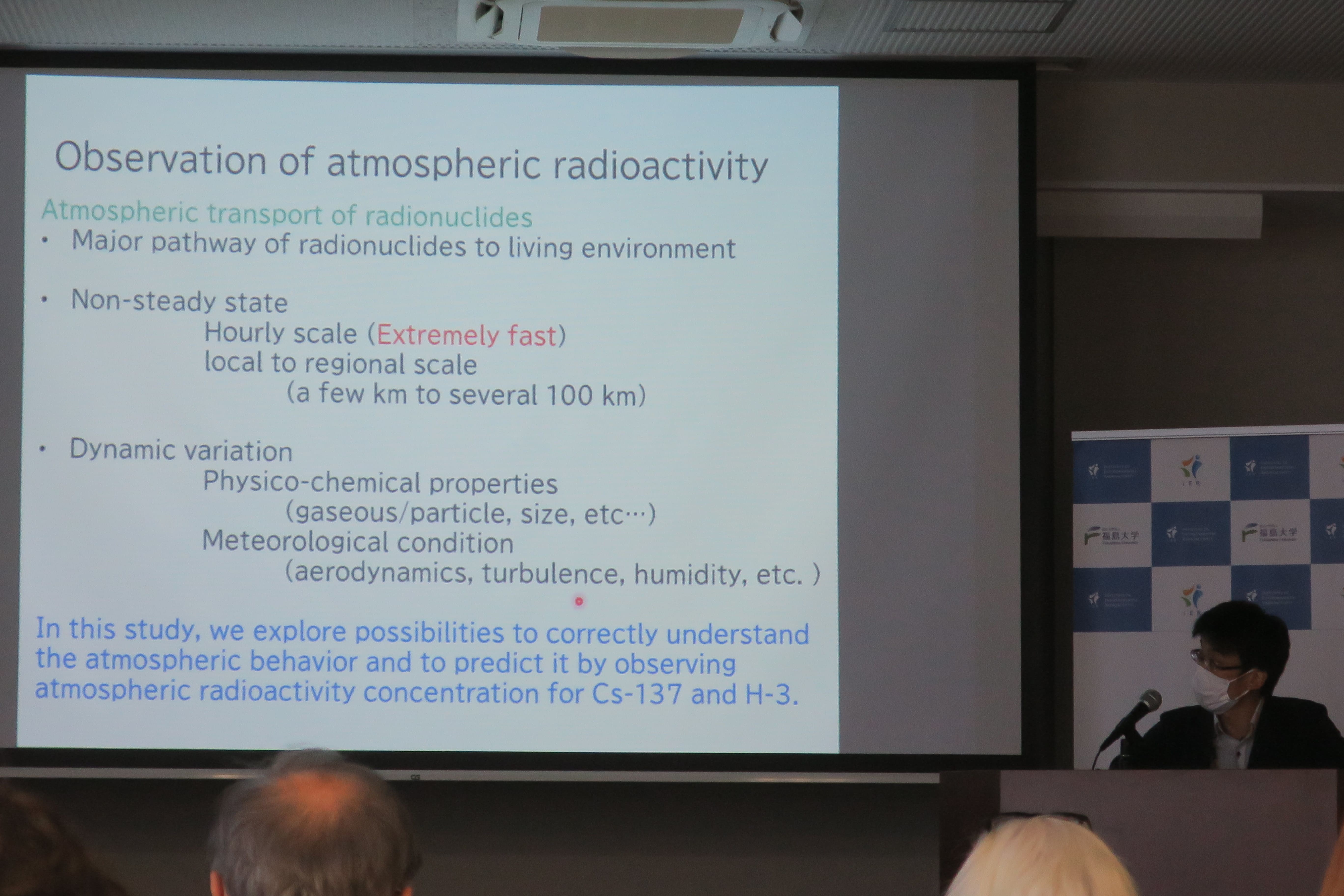 HIRAO Shigekazu, Associate Professor
HIRAO Shigekazu, Associate Professor
Institute of Environmental Radioactivity (IER) regularly holds the IER seminar in which the faculty members report on their research results, with the aim of facilitating their research activities and promoting communication.
In the 6th IER seminar of this fiscal year that held on October 31, 2022, three researchers gave presentations on their research activities and results. The seminar was attended by 23 researchers and students.
Prof. Hirao presented his research on atmospheric HTO concentration. In the presentation, he showed the variation of HTO concentration obtained from investigations conducted around the FDNPP, and explained the causes of these variations along with the variations in environmental factors such as wind direction and speed.
Prof. Tsukada presented about activity concentration of 129I and 137Cs in crops and internal radiation exposure from self-consumed crops and wild edible plants (wild vegetables, fruits, etc.) in the difficult-to-return zone. As for the first topic, he explained that although 129I derived from the nuclear accident was detected in Fukushima by investigations, the calculated internal exposure is extremely low. For the other topic, he showed that although 137Cs concentration exceeding the standard level was detected in some wild plants, the effects on internal exposure were small.
Prof. Wakiyama presented the results of his research on the Niida River, which flows through the northern part of Hamadori area, regarding the impact of nearby decontamination activities on the dynamics of 137Cs in the river. He also presented the analytical results of samples collected during high-flow events.
After the presentations, participants gave the presenters various questions and comments, and they had a fruitful discussion.
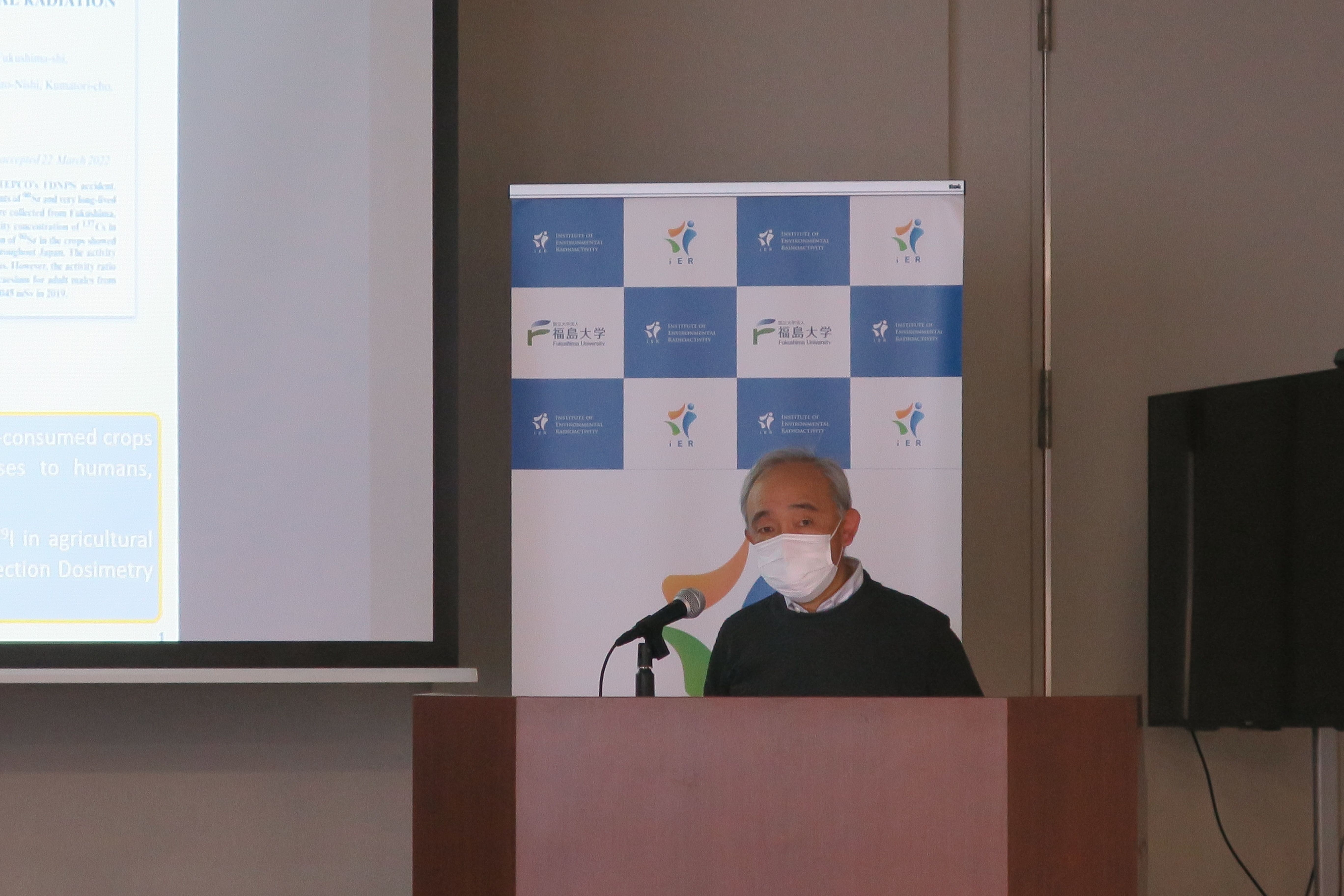 TSUKADA Hirofumi, Professor
TSUKADA Hirofumi, Professor
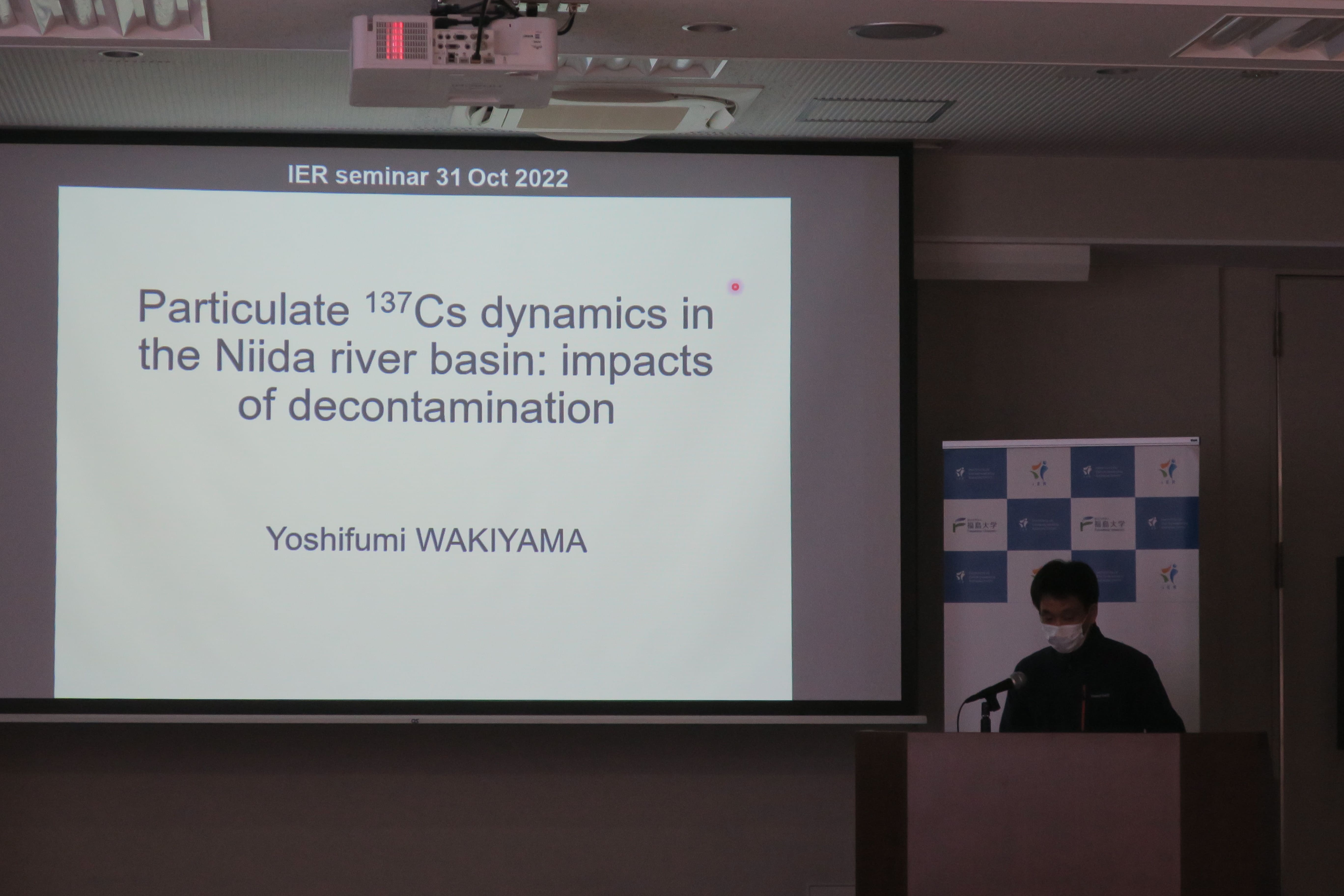 WAKIYAMA Yoshifumi, Associate Professor
WAKIYAMA Yoshifumi, Associate Professor
October 24, 2022 The 5th IER seminar was held.
〈Graduate students〉
| Date & Time: | Mon. October 24, 2022, 2:40-3:30 PM |
|
Speaker (In order of presentation): |
KAWAHARA Rika Sam KOH (Both are in the second year M.S. students, Major in Environmental Radioactivity) |
| Presentation title: |
・Radiation distribution images by using Compton camera at Hamadori, Fukushima Prefecture(Kawahara) ・Feasibility Study on the Application of Monte Carlo Simulations to Airborne Radiological Survey for the Estimation of Atmospheric Radon and its Progenies(Koh) |
Institute of Environmental Radioactivity (IER) regularly holds the IER seminar in which the faculty members report on their research results, with the aim of facilitating their research activities and promoting communication.
In the 5th IER seminar of this fiscal year that was held on October 24, 2022, two master’s students of the Major in Environmental Radioactivity made presentations on their research activities. They are going to have the final exam of master’s dissertation in the coming February and the seminar was a sort of interim presentation to report their progress for it.
Ms. Kawahara, who is working with Project Professor Torii on the visualization of radiation distribution using a Compton camera, presented the results of the measurement survey conducted in the difficult-to-return zone and the issues to be addressed.
Mr. Koh, who is working under the guidance of Associate Professor, Hirao, presented his basic research on estimating the concentration of atmospheric radon-222 and its progenies by using radiation data obtained by airborne monitoring surveys and optical transport calculations.
After their presentations, the faculty members asked questions and made comments, which seemed to be a good stimulus for the students to complete their master's thesis.
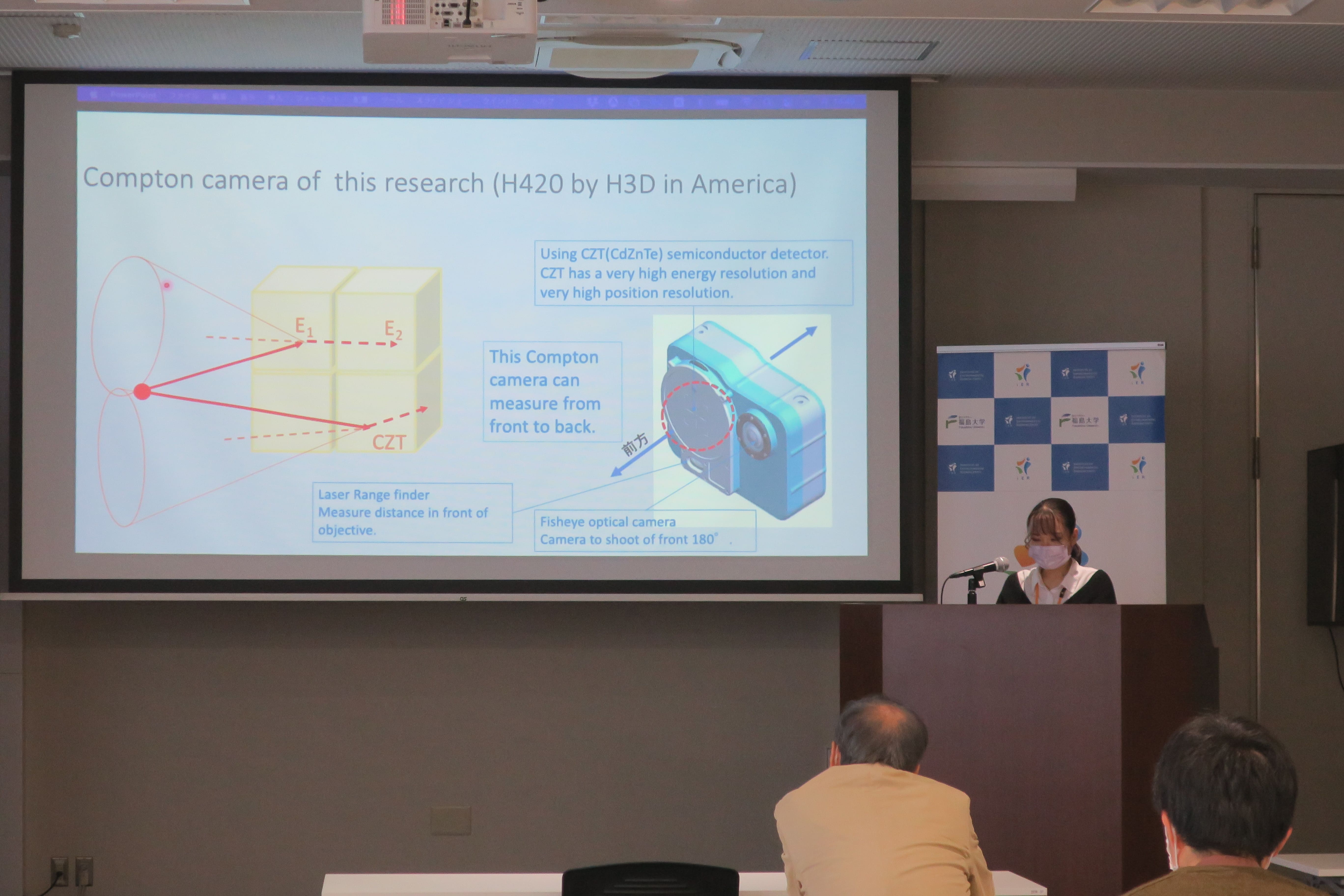 Ms. Kawahara and Mr. Koh
Ms. Kawahara and Mr. Koh presented their research activities.
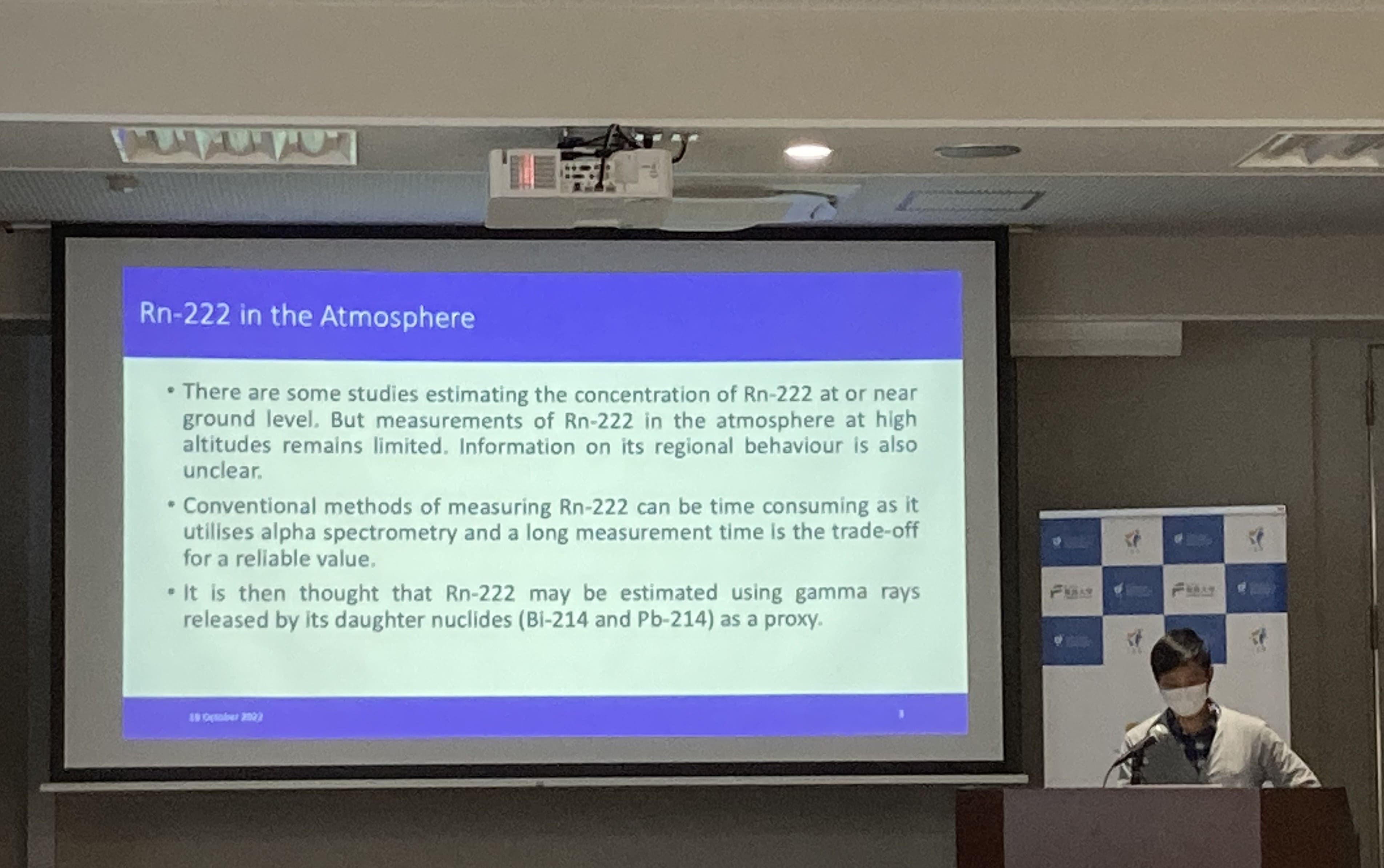
October 24, 2022 We held an IER Special Seminar.
<Prof. Johnson and Prof. Yoschenko>
| Date & Time: | Mon. October 24, 2022, 10:20 am ‒ 11:50 am JST |
| Venue: | In person (A602) and online (Zoom) |
| Guest Speaker: | Dr. Thomas Johnson, Professor of Colorado State University |
| Lecture Title: | Radioecology: History and Today |
In some of the classes of the Master’s Program of Major in Environmental Radioactivity, distinguished external researchers are invited as guest lecturers, and their classes are open to other faculty members on campus as “Special Seminars”.
On October 24, Professor Vasyl Yoschenko and Guest Speaker Professor Thomas Johnson gave a joint lecture on the subject “Environmental Radioactivity Science II”. The lecture covered the history and current state of radioecology. The IER Graduate School students and IER researchers attended the lecture. The lecture was also streamed online. In a complementary manner, the lecturers talked about the formation of radioecology, its goals and relationship to other sciences, as well as the challenges and prospects of radioecology for the future. Using illustrative examples, the basic units used in dose assessments were explained and the need to justify countermeasures based on a detailed risk analysis was shown. The audience actively participated in the Q&A session, which covered issues related to the planned discharge of tritium-containing ALPS treated water from the Fukushima Nuclear Power Plant into the ocean, the use of radionuclides as tracers, stakeholder involvement in radioecological projects, the connection of radioecology and health physics, and others.
October 17, 2022 We held an IER Special Seminar online.
<Dr. Steinhauser>
| Date & Time: | Mon. Oct 17, 2022, 16:00 ‒ 17:30 JST |
| Venue: | Online (Zoom) |
| Guest Lecturer: | Dr. Georg Steinhauser, Professor, TU Wien TRIGA Center Atominstitut, |
| Title: | Tracing anthropogenic radionuclides in the atmosphere |
In some of the classes of the Master’s Program of Major in Environmental Radioactivity, distinguished external researchers are invited as guest lecturers, and their classes are open to other faculty members on campus as “Special Seminars”.
On October 17, the online lecture on the subject “Class Subject: Environmental Radioactivity Science II” by Prof. Georg Steinhauser gathered more than 40 attendees including five IER graduate school master students, PhD students, IER members, and students and researchers from other departments at Fukushima University. In this lecture, Prof. Steinhauser talked about global monitoring of anthropogenic radionuclides in the atmosphere as a tool for tracing the nuclear incidents in various parts of the world (such as the Chernobyl accident, which was only disclosed by the Soviets after the discovery of atmospheric release detected in Sweden), and about advances in nuclear forensics based on the example of the investigation of an undeclared release of 106Ru into the atmosphere detected by the European monitoring stations network in 2017. Prof. Steinhauser explained how the concentration ratios of radioactive and stable ruthenium isotopes and their chemical species composition in the release made it possible to identify the plausible source of the release (estimated as Mayak, Russia) and understand the event scenario. During the Q and A session, lecture participants discussed the prospects for further development of a monitoring network to detect local and global nuclear events, the use of airborne surveys to trace atmospheric releases, accidents of satellite nuclear facilities in the atmosphere, the need to account for chemical forms of the airborne radionuclides, such as organic and inorganic iodine, and the need for open information and international cooperation in investigating radioactive releases.
October 5, 2022 Students from Fukushima High School visited IER
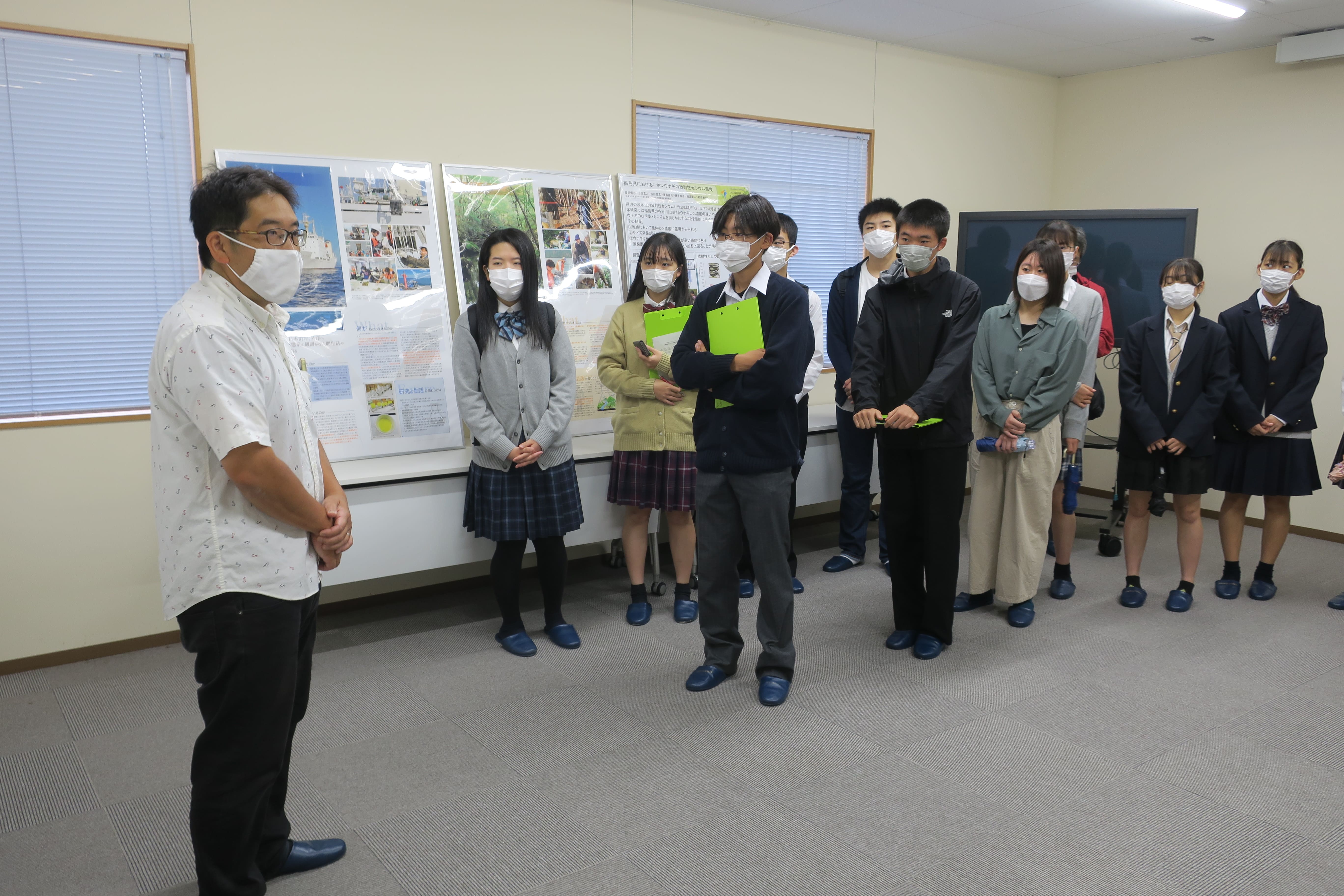 Associate Prof. Wada explained the overview and
Associate Prof. Wada explained the overview andresearch activities of IER
Forty first-year students from Fukushima High School visited IER and had a facility tour. Fukushima High School is designated as a “Super Science High School (SSH)” by the Ministry of Education, Culture, Sports, Science, and Technology of Japan, and their visit was part of the SSH program. Although the tour was only for a half an hour, Associate Professor Wada explained about the institute's research, sample processing, radiation measurement, etc.
We hope that their visit to IER will spark their interest in research related to radioactivity and lead them to graduate school and a career as a researcher.
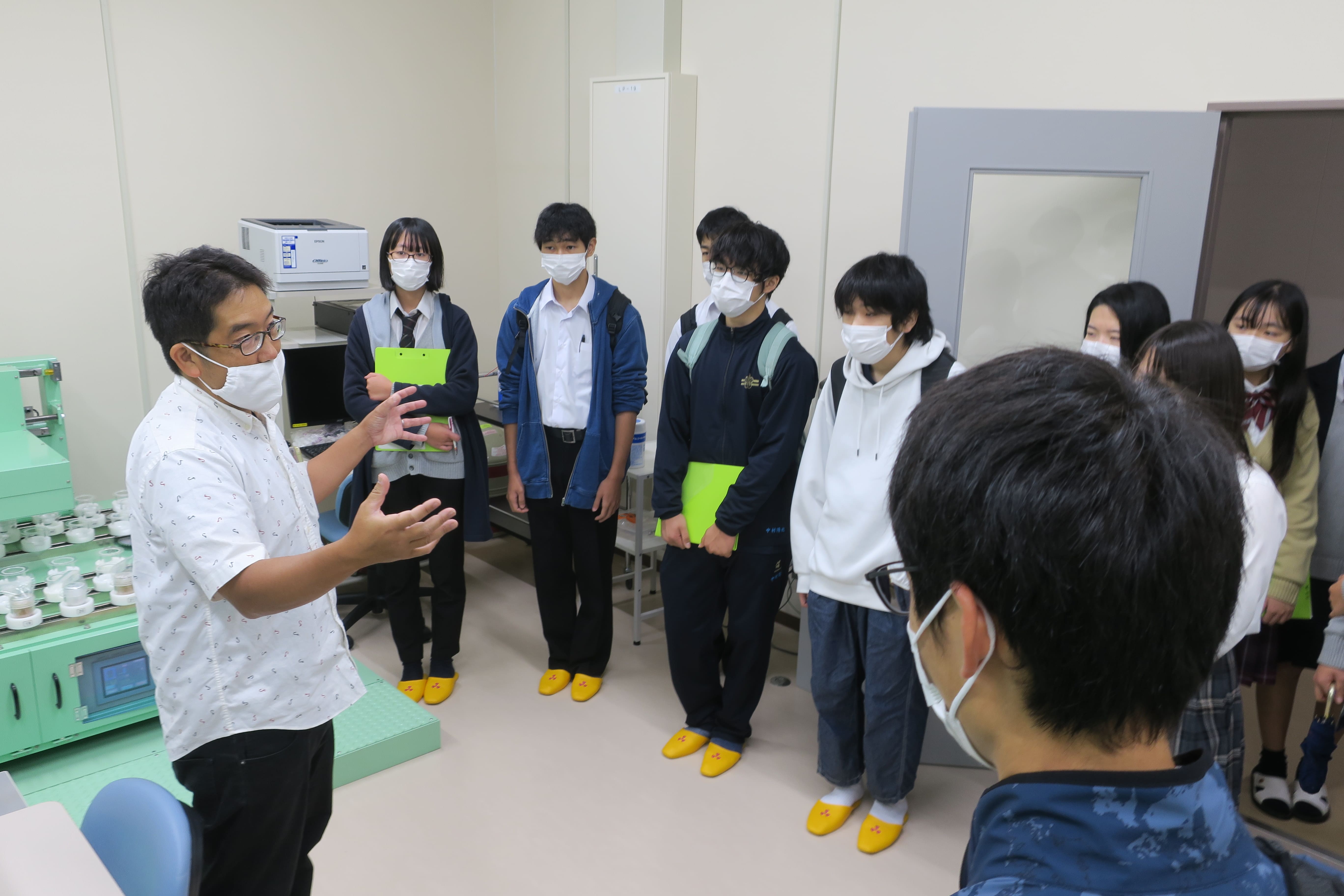 Students learned how radiation is measured by a germanium detector.
Students learned how radiation is measured by a germanium detector.
On November 2, 2022 Professor TSUKADA Hirofumi gave an invited lecture at the IAEA Technical Meeting.
| Date: | Wednesday, November 2 - Friday, November 4, 2022 |
| Venue: | Mol, Belgium, On-site and online |
| Conference name: | Technical Meeting on “The importance of communicating scientific facts: addressing radiation concerns in societies – the role of science technology and society. View from Belgium, Europe and Internationally” |
| Title: | Joint investigation of 137Cs activity concentration in self-consumed crops produced by returnees in Namie, Fukushima. |
Professor Hirofumi TSUKADA gave an invited lecture (online) at the IAEA Technical Meeting on Wednesday, November 2, 2022.
AgendaOctober 4, 2022 Professor Tsukada conducted a survey in Katsurao Village, Fukushima.
On Tuesday, October 4, 2022, Professor TSUKADA Hirofumi conducted a research in the paddy fields of Katsurao Village, where experimental cultivation is underway for the resumption of agricultural operations.
This survey was conducted as part of a joint project by Katsurao Village, the National Agriculture and Food Research Organization (NARO), and Fukushima University.
Professor Tsukada specializes in environmental radioecology, and his research includes elucidating the transfer of radionuclides from soil and irrigation water to crops. This time, rice and soil samples were collected at the time of rice harvest. With a soil core sampling device, six soil cores were collected to a depth of about 30 cm by turning a handle of the device.
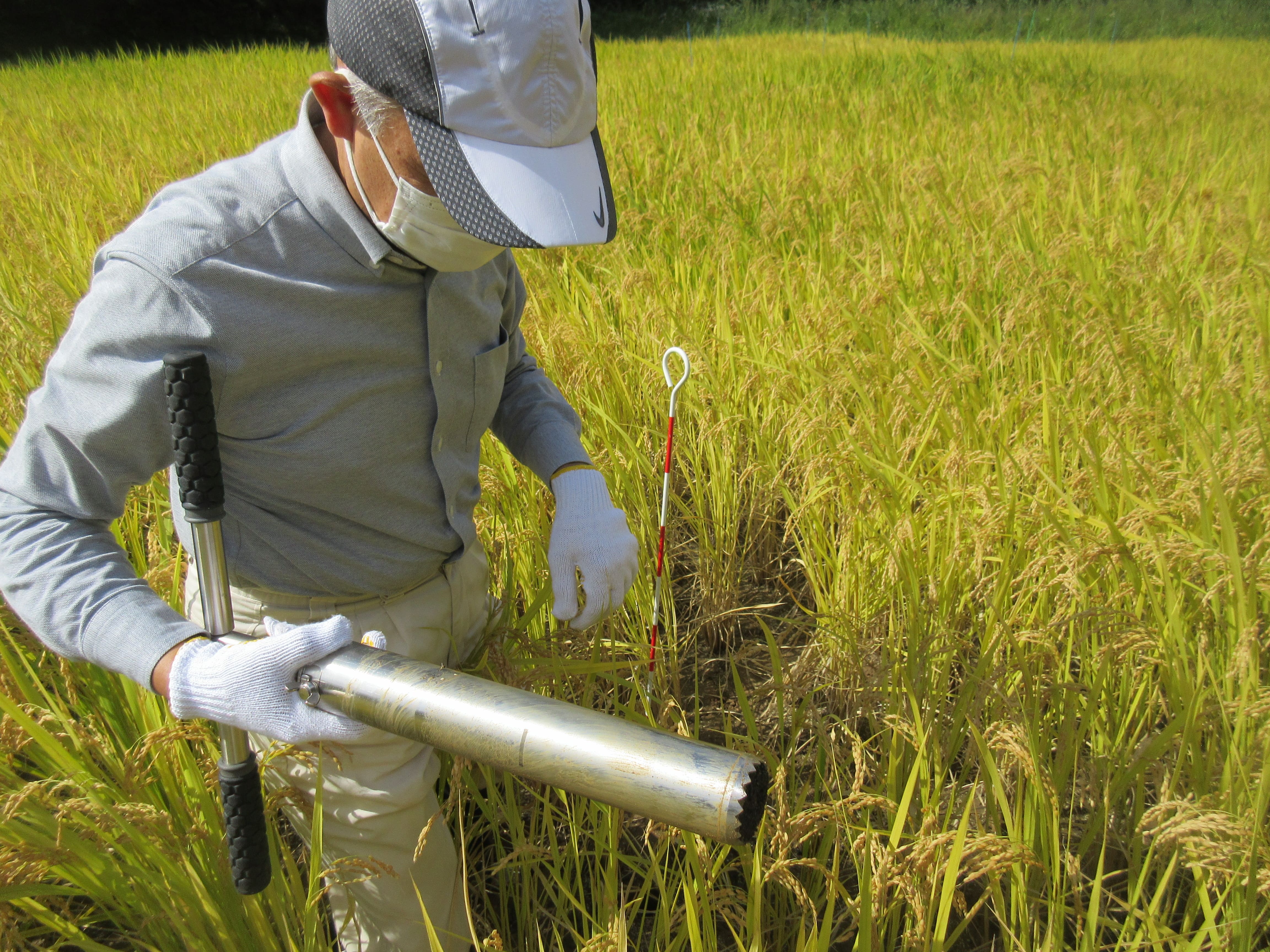 Prof. Tsukada using a soil sampler
Prof. Tsukada using a soil sampler
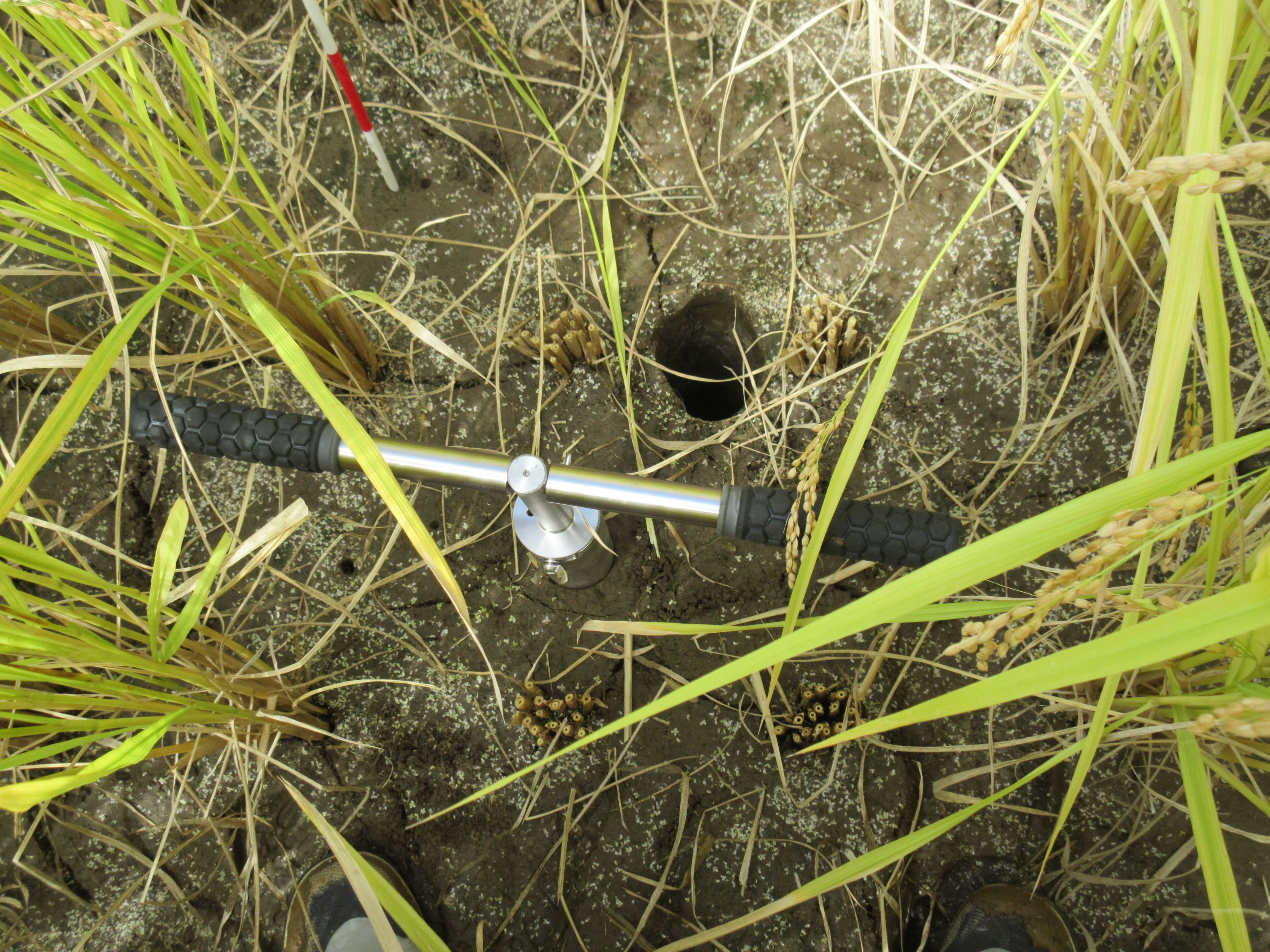 Turn this handle to dig the soil
Turn this handle to dig the soil
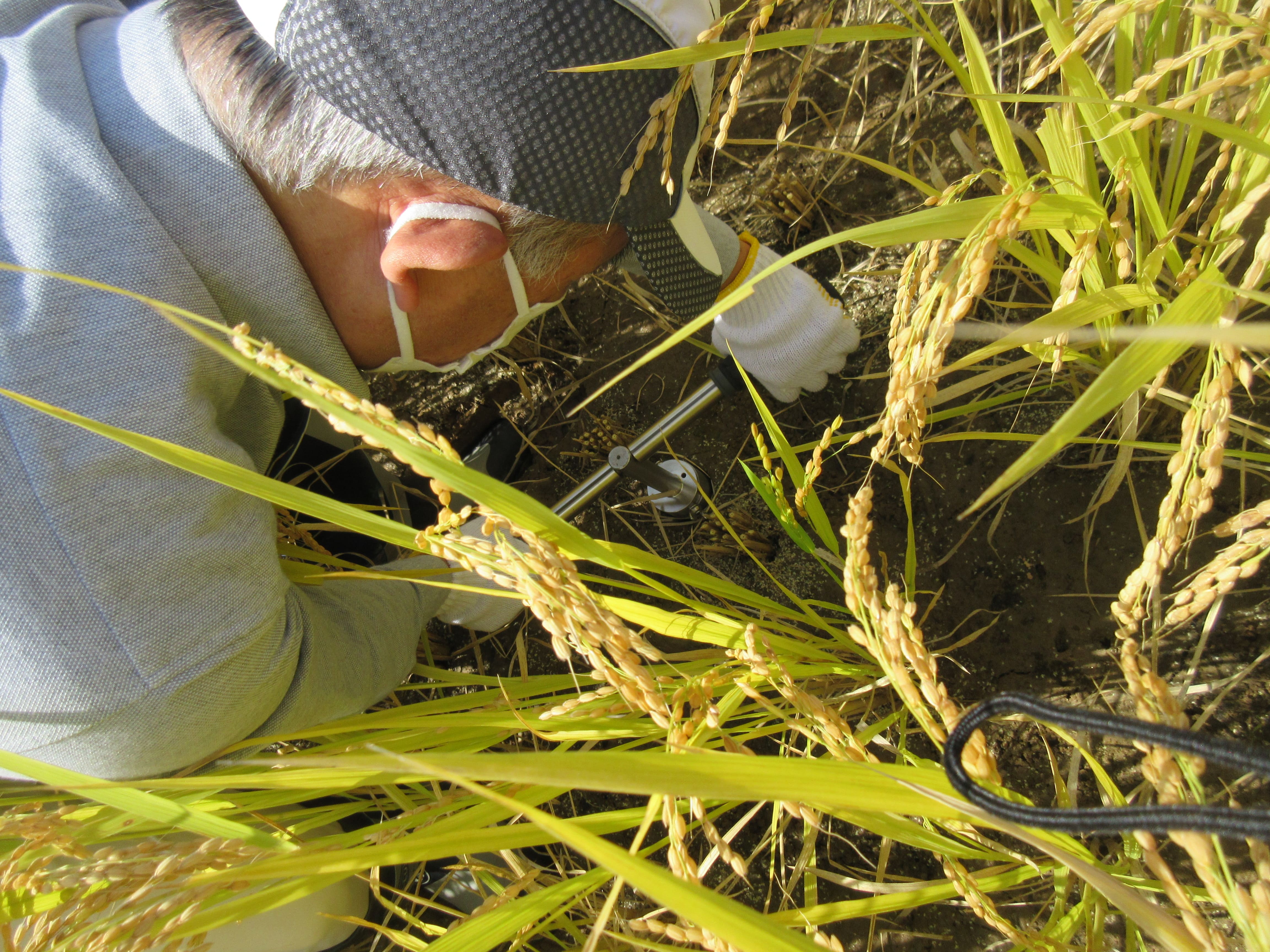 Digging with a soil sampler
Digging with a soil sampler
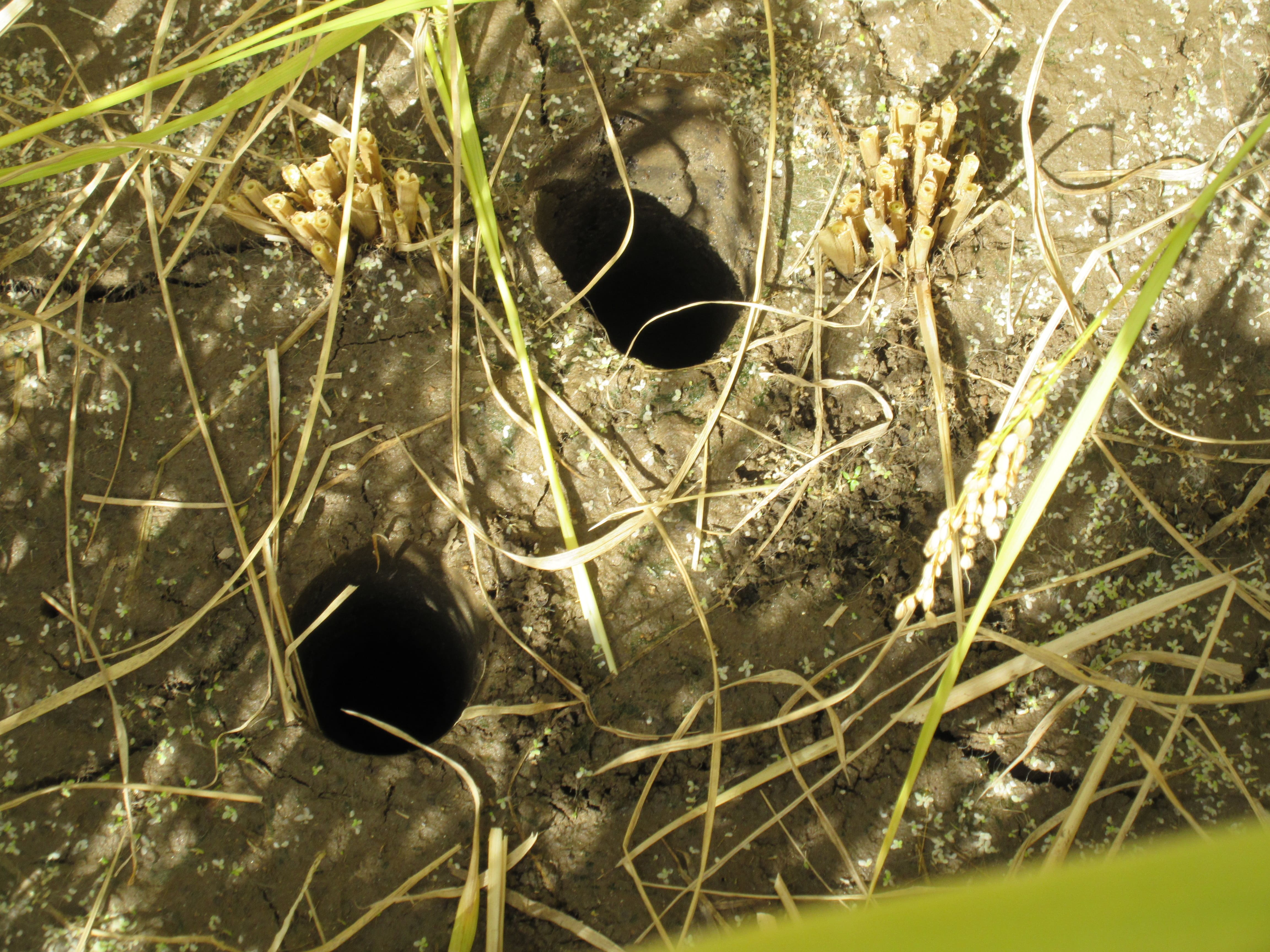 Soil collected with a soil sampler
Soil collected with a soil sampler
The collected soil will be brought back to the laboratory to identify the speciation of radioactive materials, measure the radioactivity, and determine the transfer of radioactive materials from the soil and irrigation water to the rice plants.
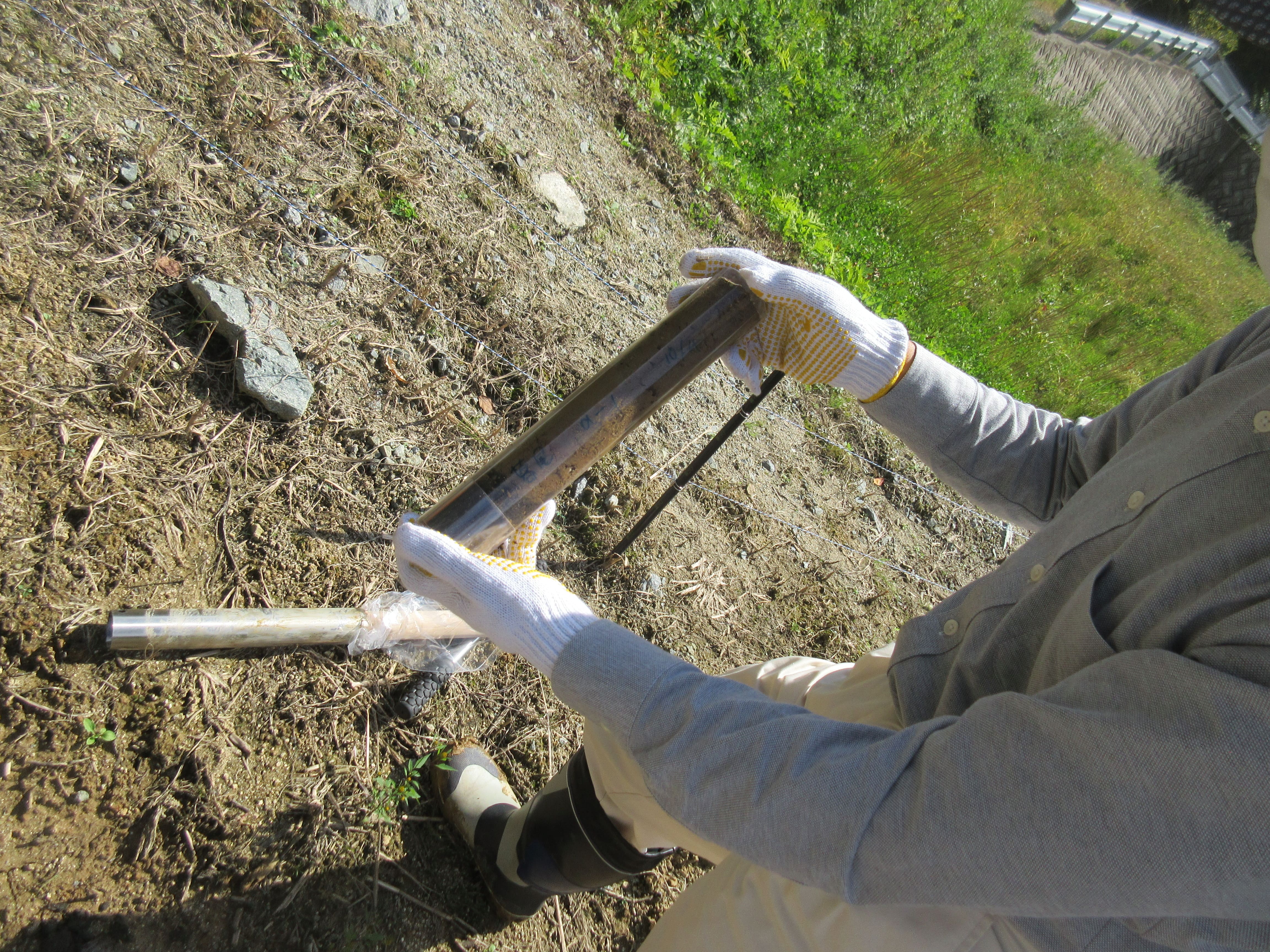 After digging the soil with a soil sampler
After digging the soil with a soil sampler
This survey has been conducted continuously and periodically twice a month since rice planting. Similar surveys have also been conducted in Okuma Town, which have continued for 5 to 6 years, changing locations.
In addition, the NARO conducts surveys research on soil fertilizer composition, rice yield, and eating quality in their respective fields of expertise.
We will continue to conduct this research so that farmers can resume agricultural operations with peace of mind and grow rice safely in the Specified Reconstruction and Revitalization Base.
The degree conferment ceremony took place on Friday 30 September 2022.
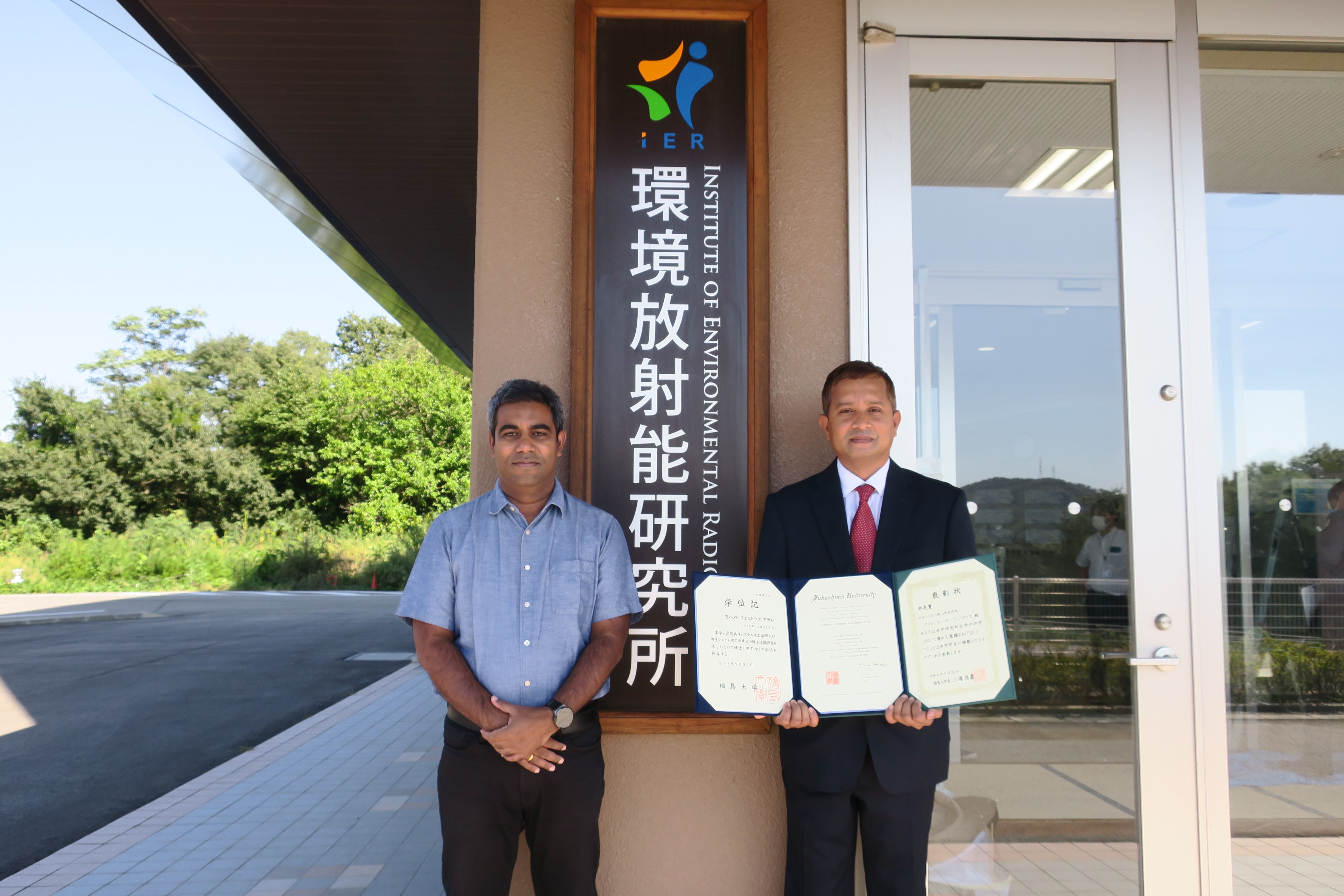 Associate Professor Rahman and Mr. Ferdous
Associate Professor Rahman and Mr. Ferdous with his graduation certificates
The degree conferment ceremony of Fukushima University was held and a student studying at the IER celebrated the day of completion of his doctoral program.
Mr. Md. Ferdous ALAM, an international student from Bangladesh, has studied selective separation of radionuclides from aqueous matrices using solid-phase extraction systems for 4 years under the supervision of Professor Nanba, Associate Prof. Ismail Md. Mofizur Rahman and Professor TAKAGAI Yoshitaka. He successfully completed his study and was awarded Ph.D.
He also received the President's Award for his diligent writing and submission of academic papers during his graduate studies.
Having graduation certificates in his hands, he looked very proud of him, and his bright smile was so impressive. Congratulations!!
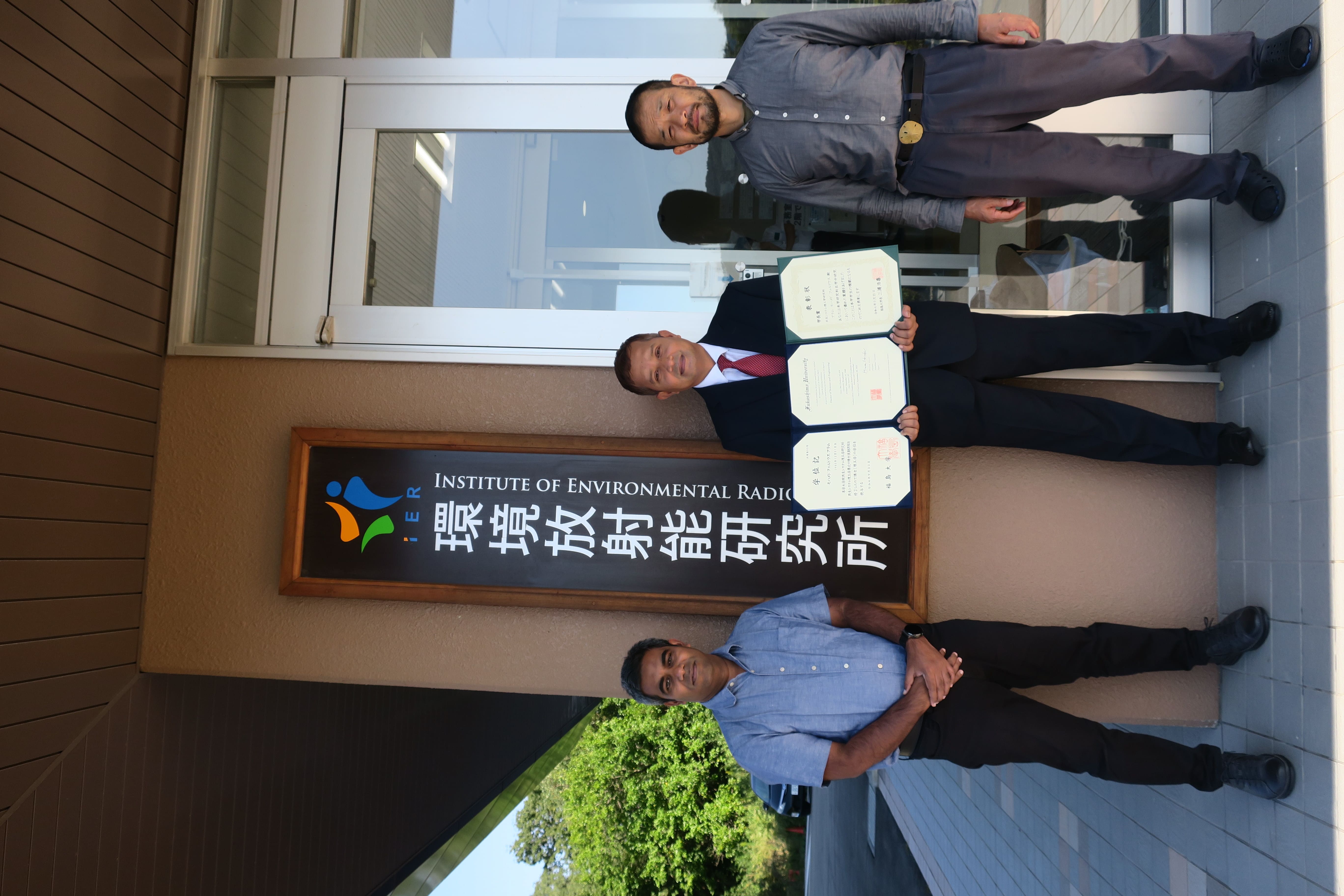 With Director Nanba
With Director Nanba
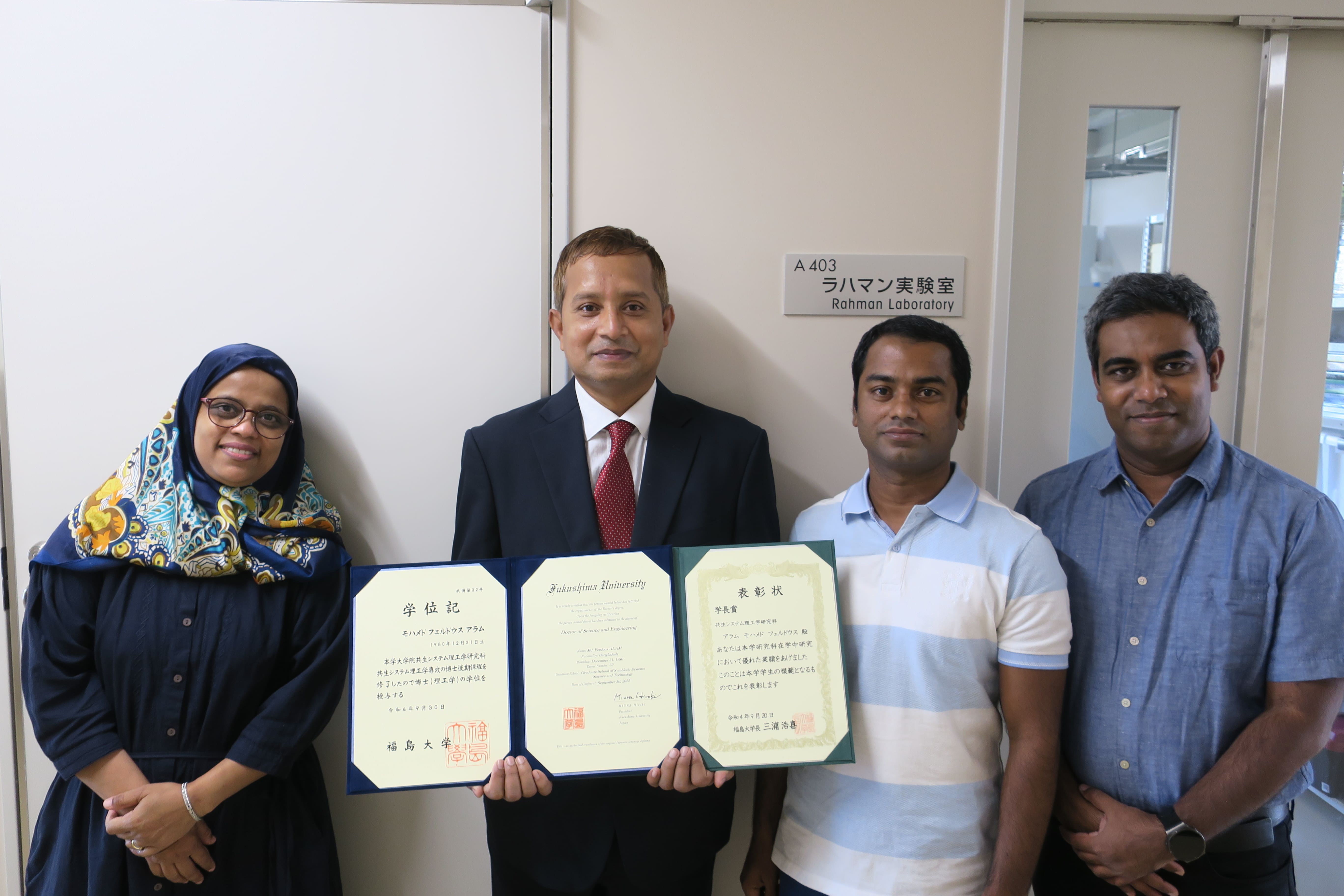 With members of the Rahman Lab on the 4th floor of the IER.
With members of the Rahman Lab on the 4th floor of the IER.
On August 19, 2022 Ceremony was held for the handover of equipment to Ukraine.
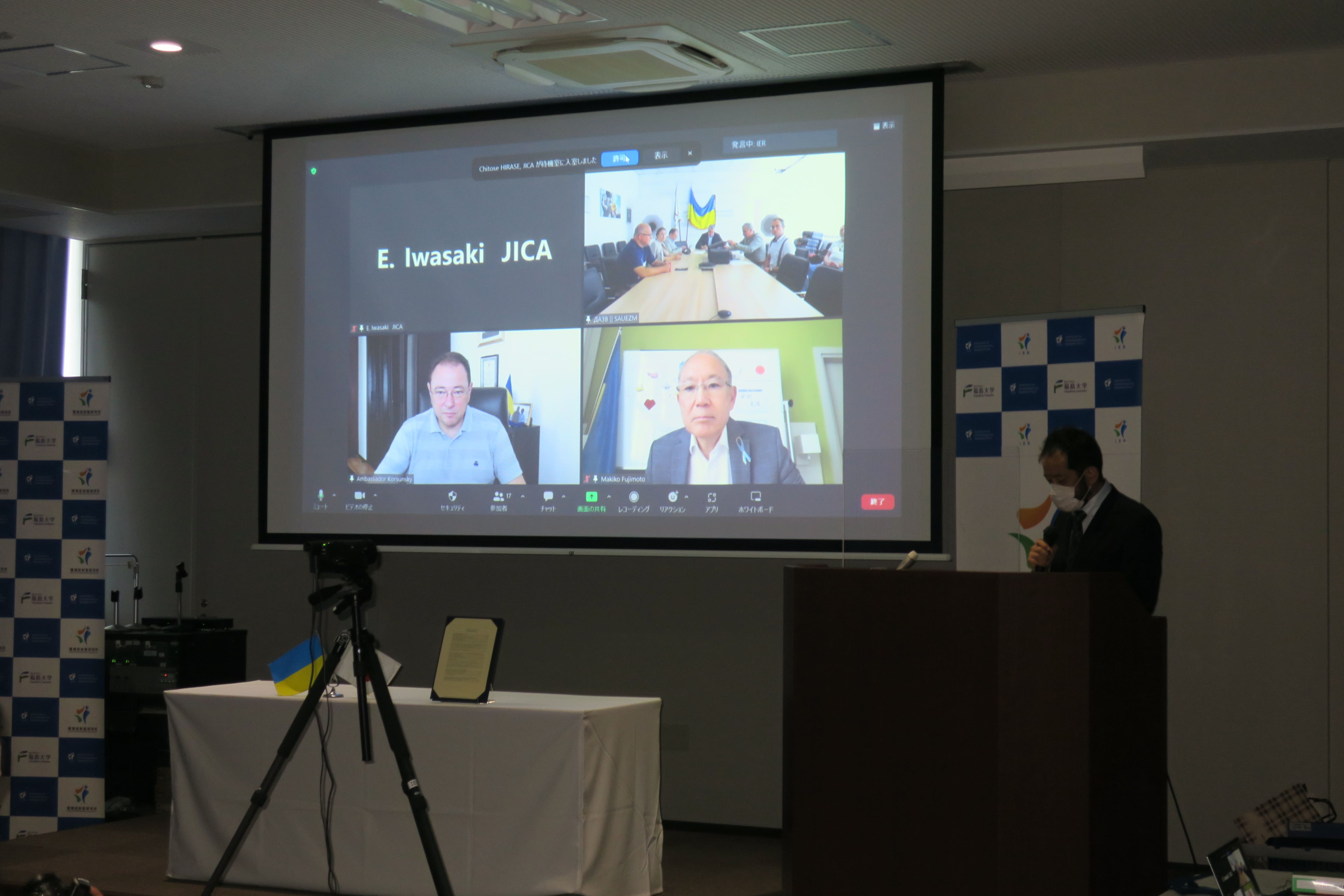 The handover ceremony was held online.
The handover ceremony was held online.Top right: SAUEZM and Ecocentre staff,
bottom left: Ambassador Korsunsky,
bottom right: Ambassador Matsuda on the screen
The SATREPS Chornobyl project provide equipment to joint research institutes in Ukraine, which was damaged by the Russian invasion of Ukraine.
On August 19, a handover ceremony was held online between Ukraine and Japan on the occasion of the delivery of dosimeters to the State Specialized Enterprise “Ecocentre”, a research institute based in Chornobyl
In addition to the IER and Ecocentre, the handover ceremony was attended by the Ukrainian representative of the project, the State Agency of Ukraine on Exclusion Zone Management (SAUEZM), and JICA, an implementing agency of the SATREPS program. We were also honored to have the participation of H.E. Dr. Sergiy KORSUNSKY, Ambassador Extraordinary and Plenipotentiary of Ukraine to Japan, and H.E. Mr. MATSUDA, Ambassador Extraordinary and Plenipotentiary of Ukraine to Japan.
In his remarks, Ambassador Korsunsky expressed his gratitude for the support from Japan as the Zaporizha nuclear power plant is currently under threat of Russian military attack. Ambassador Matsuda expressed the growing importance of this project as the invasion threatens the safety of nuclear facilities in Ukraine. He also expressed the Japanese government’s intention to continue its support to Ukraine in the future.
After Prof. Nanba presented the list of equipment to be delivered, SAUEZM and Ecocentre explained the situation of damage in the Chornobyl exclusion zone after the Russian invasion and expressed their gratitude for the support from Japan and their strong determination not to give in to the Russian invasion.
The IER feels a strong connection with Ukraine because of the shared experience of nuclear accident in Chornobyl and Fukushima. Therefore, although the SATREPS Chornobyl project is scheduled to end at the end of March, 2023, the IER hopes to continue supporting Ukraine in the future.
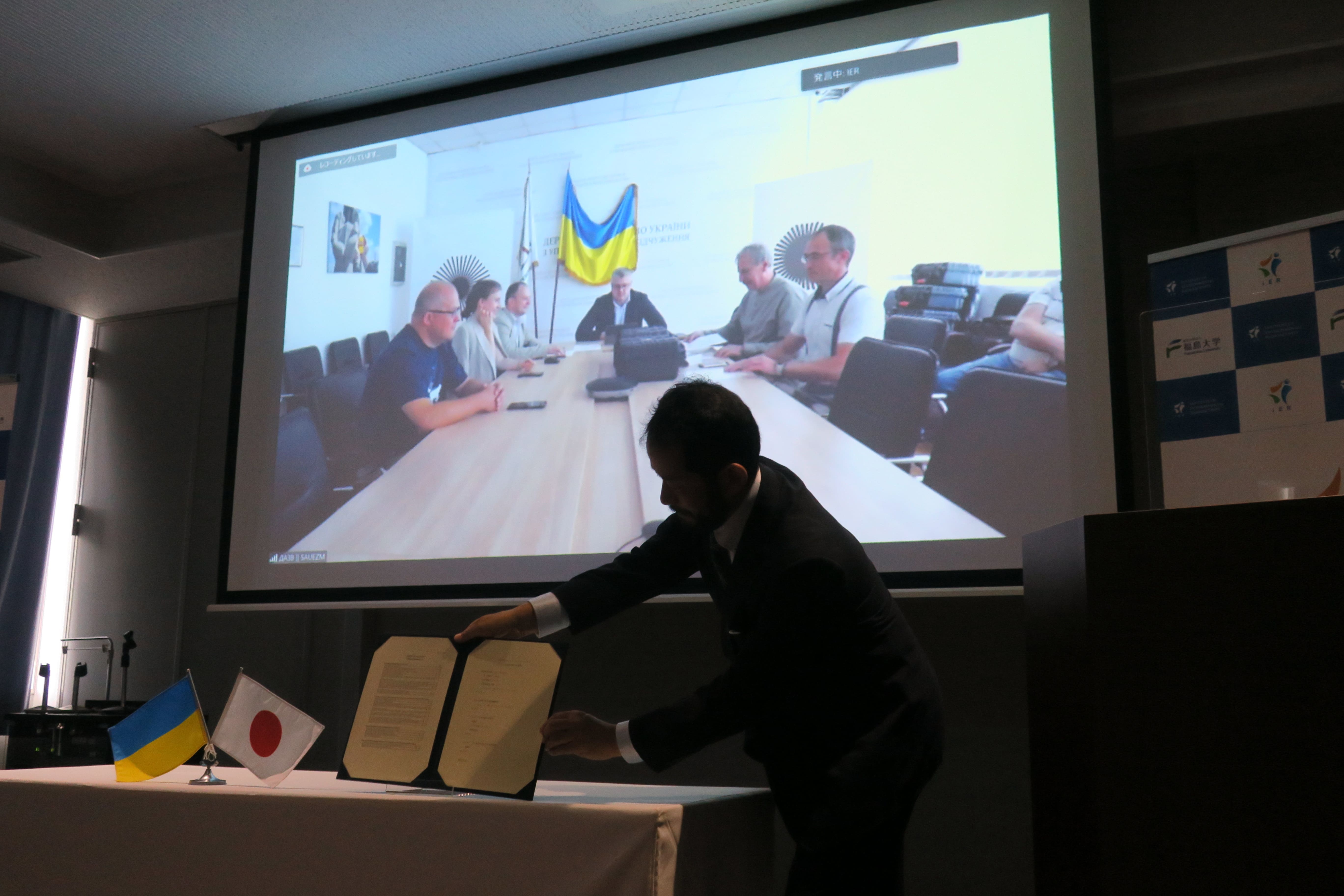 The list of equipment to be delivered
The list of equipment to be deliveredwas presented by Prof. Nanba
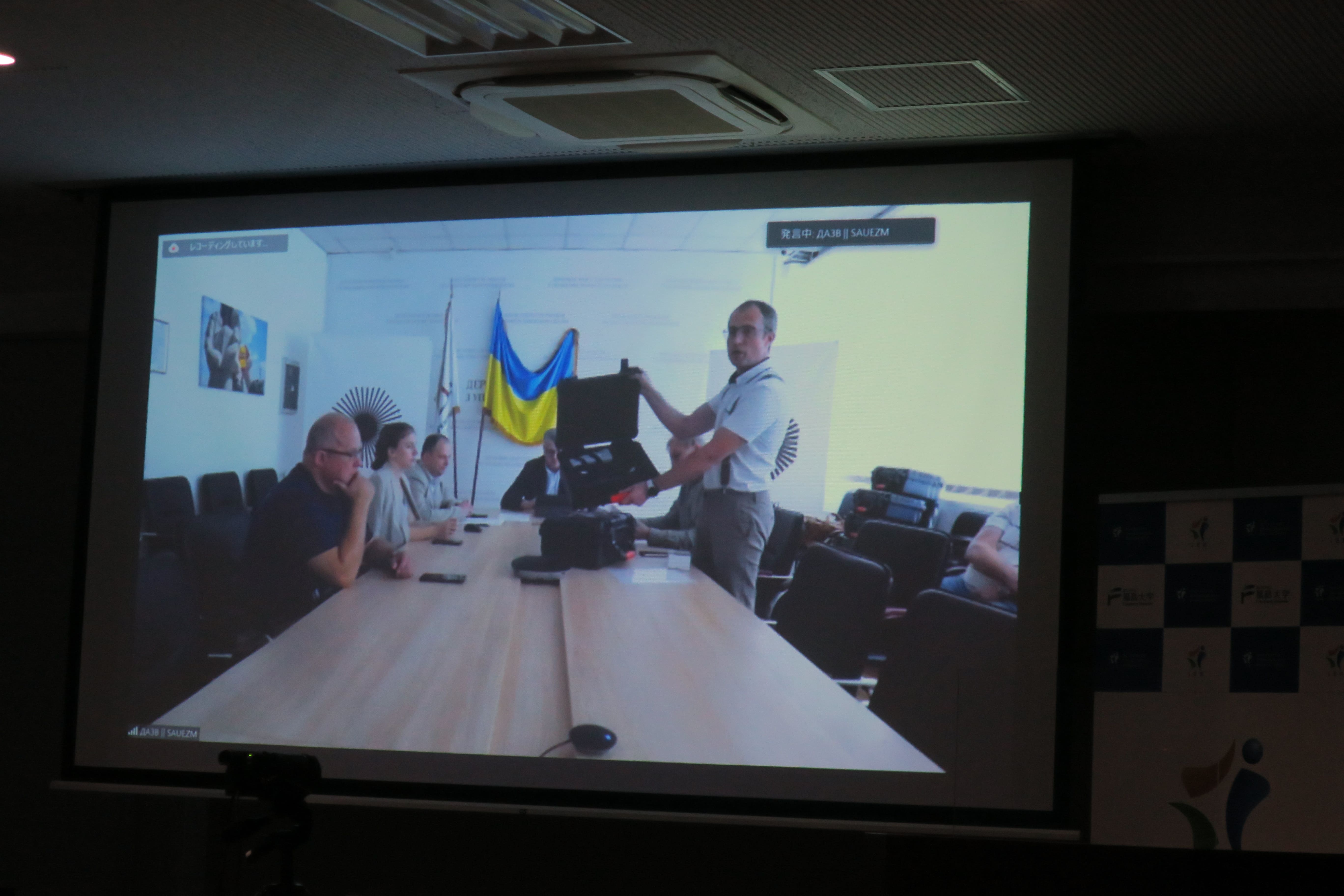 Introducing a dosimeter delivered to Ecocentre
Introducing a dosimeter delivered to Ecocentre
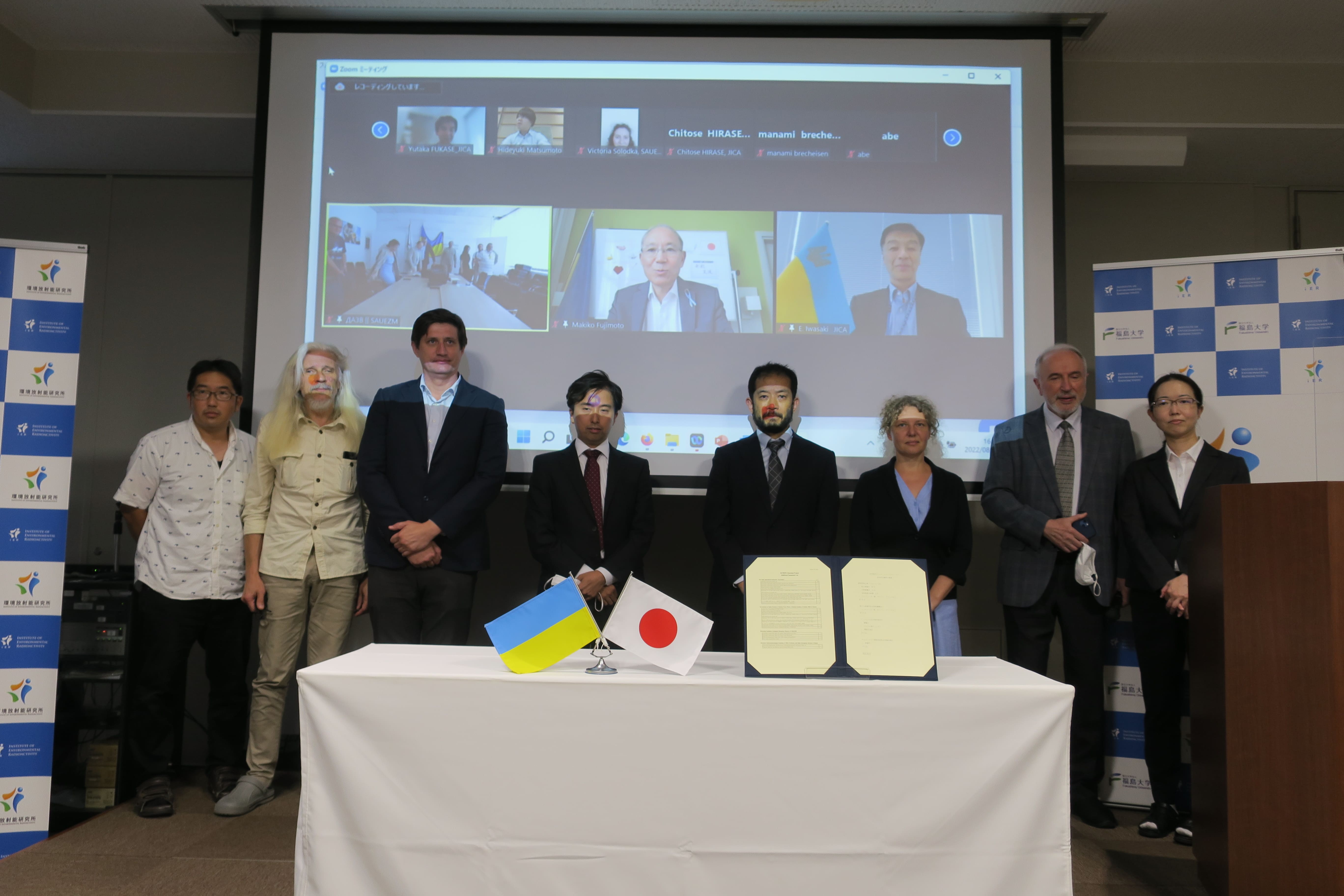 Commemorative photo with participants to the ceremony
Commemorative photo with participants to the ceremony
Training of Ukrainian Researcher
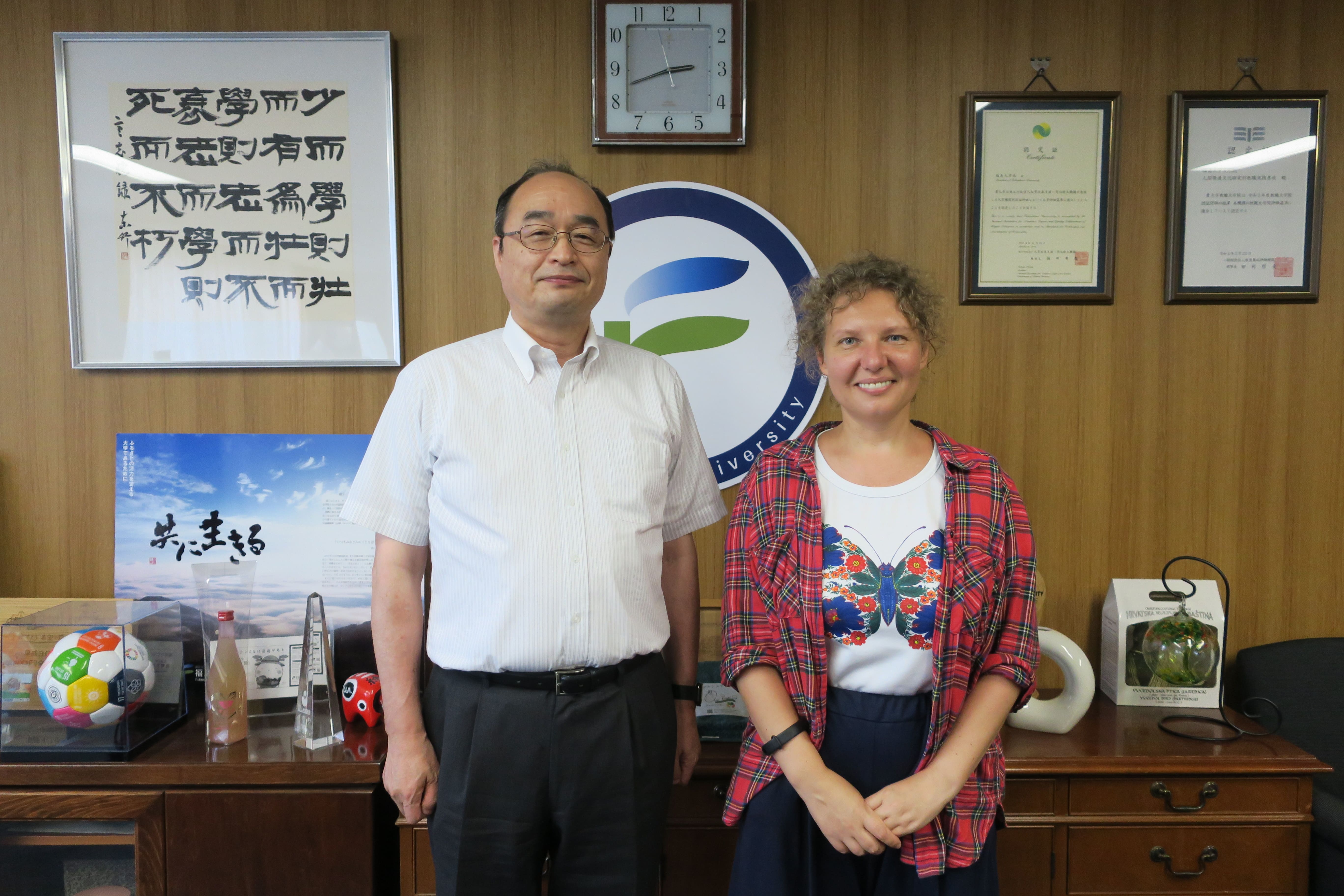 Dr. Burdo paid a courtesy visit to Professor Miura,
Dr. Burdo paid a courtesy visit to Professor Miura,the president of Fukushima University
IER is currently hosting a Ukrainian co-researcher, Dr. Olena BURDO, as a trainee for about four months. This training is conducted within the framework of the SATREPS Chornobyl project, in which the IER Director, Professor Nanba Kenji is the Principal Investigator and many IER researchers are participating.
At a press conference held on August 19, Professor Nanba and the host researcher, Project Senior Assistant Professor Ishiniwa, explained the purpose of the training program. Then, Dr. Burdo herself gave a brief story of her visit to Japan from the start of the Russia’s invasion of Ukraine to her arrival in Japan.
Dr. Burdo belongs to the Institute for Nuclear Research of the National Academy of Sciences of Ukraine and specializes in radiation biology. During her training, which will last until early December, she will learn the latest techniques for assessing radiation doses to humans and wild animals.
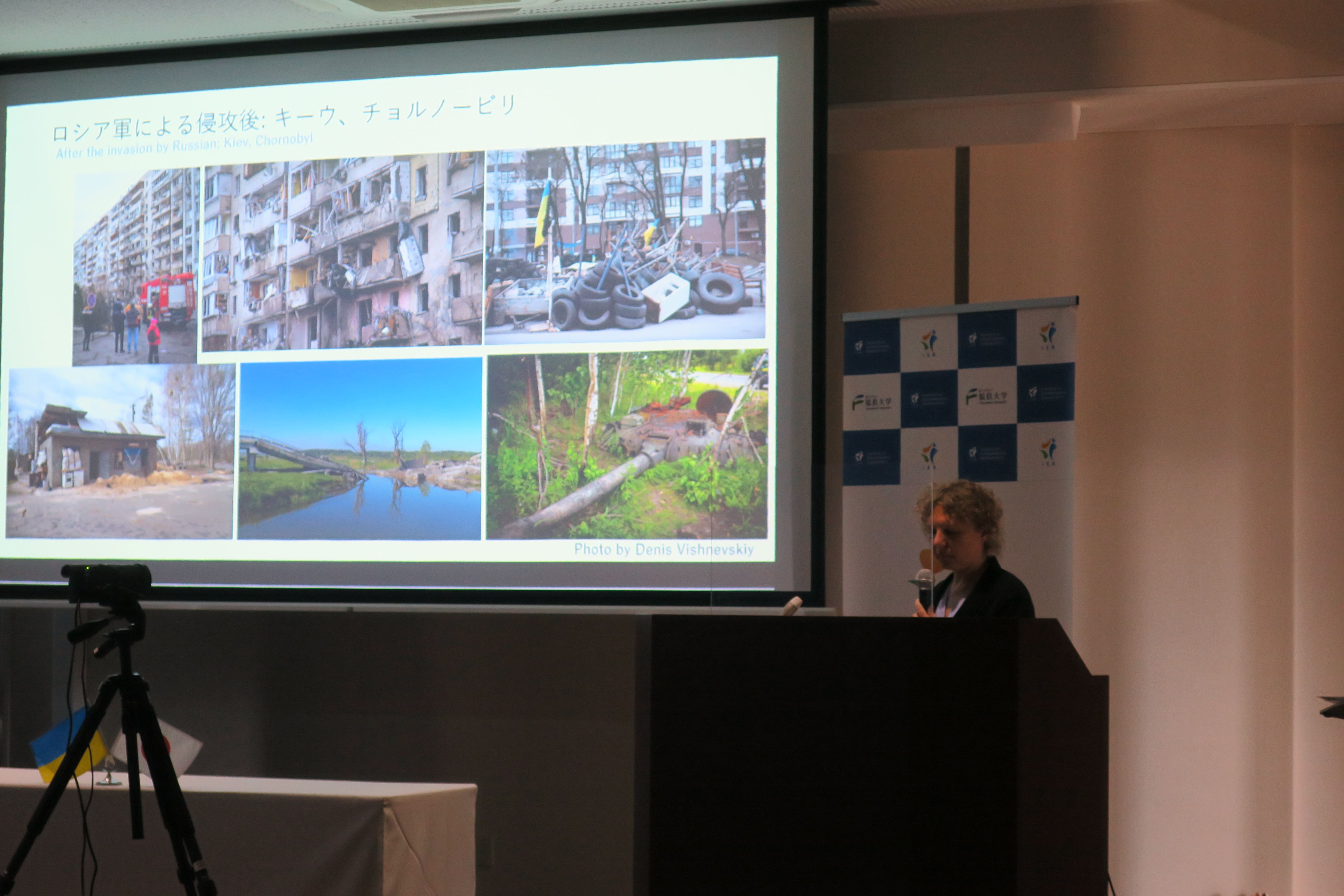 Dr. Burdo presenting on Kyiv
Dr. Burdo presenting on Kyivafter Russian invasion
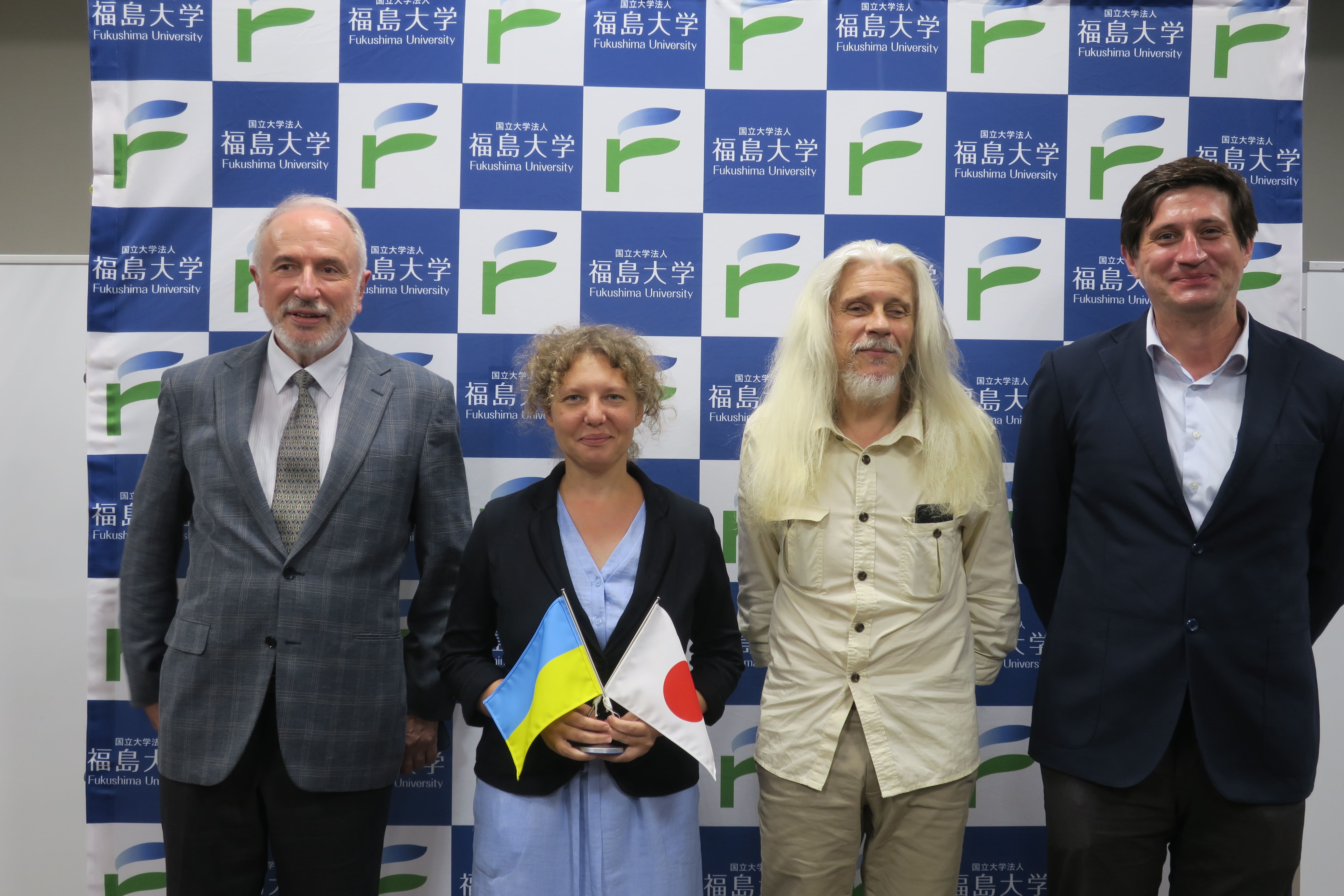 Dr. Burdo with the IER’s Ukrainian faculty members
Dr. Burdo with the IER’s Ukrainian faculty members
August 8, 2022 Students conducted a fishing survey
On August 8, 2022, four first-year master's course graduate students conducted a fishing survey. This was part of the "Practicum in environmental radioactivity science," a compulsory class in the Environmental Radioactivity Course. This fishing survey is conducted based on a special permission (Special No. 4-14) from Fukushima Prefecture.
Before leaving for the survey site, Associate Professor Wada explained the outline of the survey. With keeping in mind the characteristics of the survey site and the trend of radiocesium concentrations of fish inhabiting the site after the nuclear power plant accident, we were finally ready to go.
The survey was conducted under the flaming sun. The students handled the rods with uncustomary skill, but with the advice of Associate Professor Wada, they were able to catch one fish one by one for a sample.
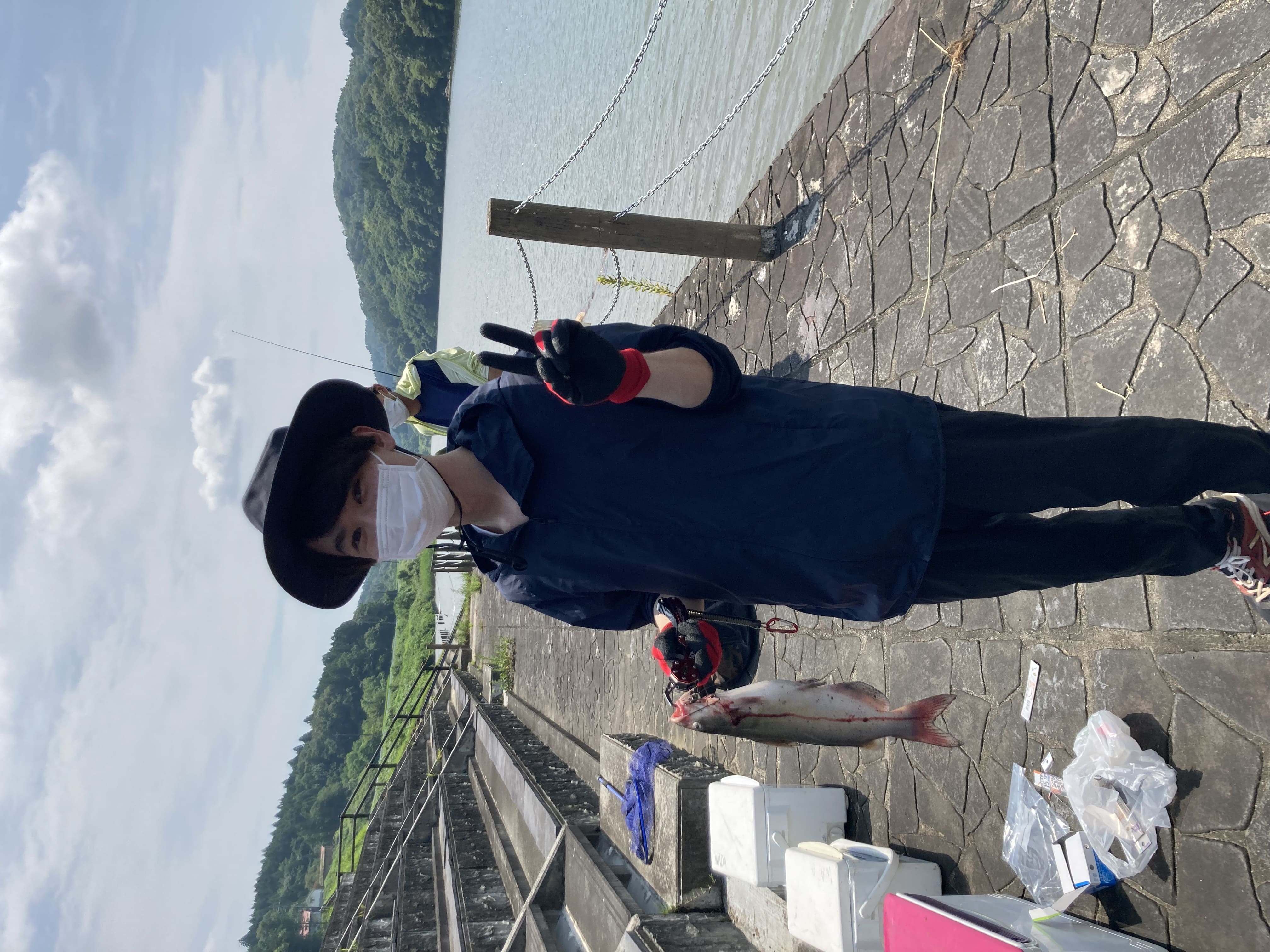
Incidentally, there has recently been a problem in this study area, where the non-native channel catfish (American catfish) has proliferated in large numbers and has negatively impacted on native fish (link to the article). Many of the fish caught during this survey were channel catfish.
At the same time, water samples were also taken to measure the concentration of radiocesium in water at the survey site.
After a lunch break, students learned about sample processing.
After Associate Professor Wada demonstrated how to cut a fish into three pieces skillfully, it was the graduate students’ turn to do the same. All the students managed to cut the fish into three pieces, with being careful to handle the sharp spines and knives.
The fish was minced in the manner of making “Namero (similar to tartare)” and packed in a container called U8 and ready to be measured with a Ge detector.
The day's program ended when the samples were finally set in a Ge detector and the measurement was started.
Each graduate students has different research topics , but in this practicum class, they learned a series of steps from capturing fish samples to measuring them.
Another attraction of the major in Environmental Radioactivity is its close proximity to research sites and the opportunity to learn research methods from the faculty members in an at-home atmosphere.
June 29, 2022 We held an IER Special Seminar online.<Dr. Johnson>
| Date & Time: | Wed. June 29, 2022, 10:20 am ‒ 11:50 am JST |
| Venue: | Online (Zoom) |
| Guest Lecturer: | Dr. Thomas Johnson, Professor of Colorado State University |
| Lecture Title: | External dose calculations |
In some of the classes of the Master’s Program of Major in Environmental Radioactivity, distinguished external researchers are invited as guest lecturers, and their classes are open to other faculty members on campus as “Special Seminars”.
On June 29, the online lecture on the subject “Radioecology” by Prof. Thomas Johnson was attended by five IER graduate school students and eight IER members.
In this lecture, Prof. Johnson presented the basic approaches used for calculations of the doses from external gamma- and beta- radiation and discussed the models for the low dose health impacts assessments.
The lecture greatly benefited from the example calculations of the specific gamma-ray constants for 134Cs and 137Cs and doses from the point, linear and planar sources of gamma-radiation, as well as it provided useful links to the online nuclear databases of the JAEA and Brookhaven National Laboratory as well as dose calculation tools such as VARSKIN.
In the Q&A session, the lecture participants discussed the accuracy of calculation of the specific gamma-ray constants and shielding effect on the air dose rates and compared the magnitudes and sources of the ambient dose rates in Japan and in Colorado.
June 28, 2022 We held an IER Special Seminar online.<Dr. WATANABE>
| Date & Time: | Tue. June 28, 2022, 10:20 am ‒ 11:50 pm JST |
| Venue: | Online (Zoom) |
| Guest Lecturer: | Dr. Yoshito Watanabe, National Institute of Radiological Sciences, National Institutes for Quantum and Radiological Science and technology (QST NIRS) |
| Lecture Title: | Effects of Fukushima accident on plants and animals |
On June 28, the lecture on the subject “Effects of Radiation Exposure” by Dr. Yoshito Watanabe was attended by five IER graduate school students, and several IER members. In the introduction, Dr. Watanabe presented the basic concepts of the system of radiation protection of the Environment, such as RAPs (Reference Animals and Plants) and DCRL (Derived Consideration Reference Levels), and explained about their practical application in ERICA Tool*. Dr. Watanabe then assessed the risk of radiation by comparing the estimated dose rates with DCRL to RAPs in terrestrial and marine ecosystems in Okuma during different periods after the Fukushima accidents. The topics widely ranged from a comprehensive review of publications revealing radiation effects on wild animals and plants observed after the Fukushima accident, the effects of the Chornobyl nuclear accident on wildlife, problems in interpreting differences in radiation effects in the field and laboratory, progress in research on morphogenesis in Japanese fir, and to the new dosimetric model of fir tree developed by Dr. Watanabe. The participants discussed the temporal patterns in formation of the morphological abnormalities in fir trees and principal difference between the new dosimetric model and the dosimetric approach used in ERICA Tool*.
*ERICA Tool: A computer software developed in the EU research project ERICA (2004-2007) that calculates dose rates and makes risk assessments by entering radioactivity concentrations.
Click here to read the June 21 seminar article.June 27, 2022 We held the 1st IER Seminar in-person and online Zoom participants.
<Project Lecture IGARASHI and Project Associate Professor GUSYEV>
| Date & Time: | Mon. June 27, 2022, 2:00 p.m. - 4:00 p.m. |
| Speraker: |
Project Lecturer, Yasunori IGARASHI Project Associate Professor, Maksym GUSYEV (Presentation order) |
| Title: |
Progress in FY2021 and plans for FY2022 (Igarashi) Overview of research plans in Environmental Isotopes Modeling (Gusyev) |
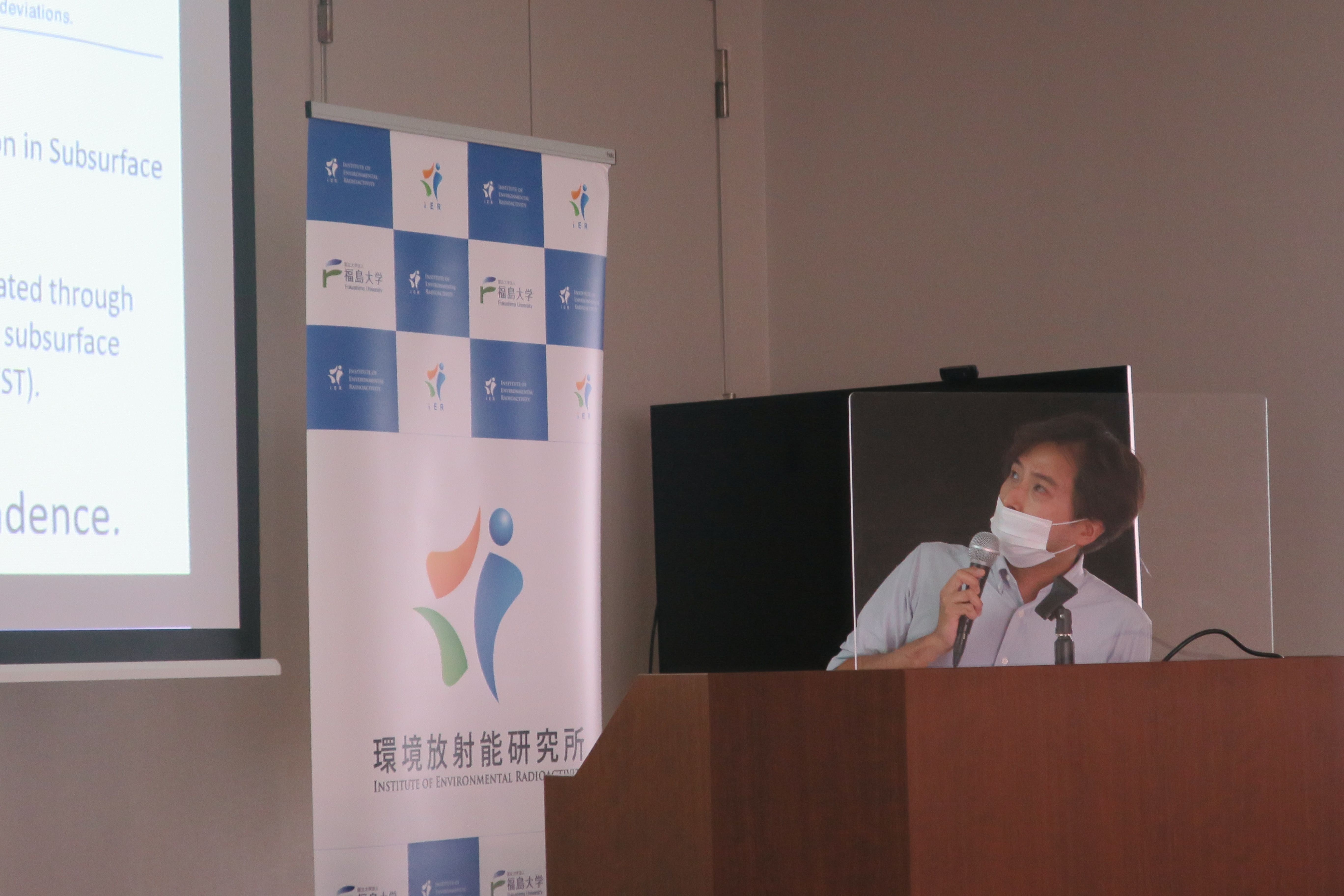 Project Lecturer IGARASHI
Project Lecturer IGARASHI
Institute of Environmental Radioactivity (IER) regularly holds the IER seminar in which the faculty members report on their research results, with the aim of facilitating their research activities and promoting communication.
The first IER Seminar in this fiscal year was held on June 27 with two presentations by Project Senior Assistant Professor, Yasunori IGARASHI, and Project Associate Professor, Maksym GUSYEV. The seminar was attended by 31 researchers and graduate students, including online attendees.
Project Senior Assistant Professor IGARASHI talked about his research conducted in 2021, including his research progress on the long-term investigation of dissolved and particulate 137Cs activity concentrations in river water of the middle part of the Abukuma River, as well as future research prospects and the SATREPS-Chornobyl project plans.
Project Associate Professor GUSYEV, who joined IER on 1st April 2022, gave the first presentation at the IER seminar on his research interests including river basins, groundwater flow, radionuclide transport, and environmental tracers. He also talked about preliminary findings of the SATREPS-Chornobyl project and his other research activities up to date and shared an overview of his research plan in Environmental Isotopes Modeling.
After the presentation, various questions and opinions were exchanged among participants.
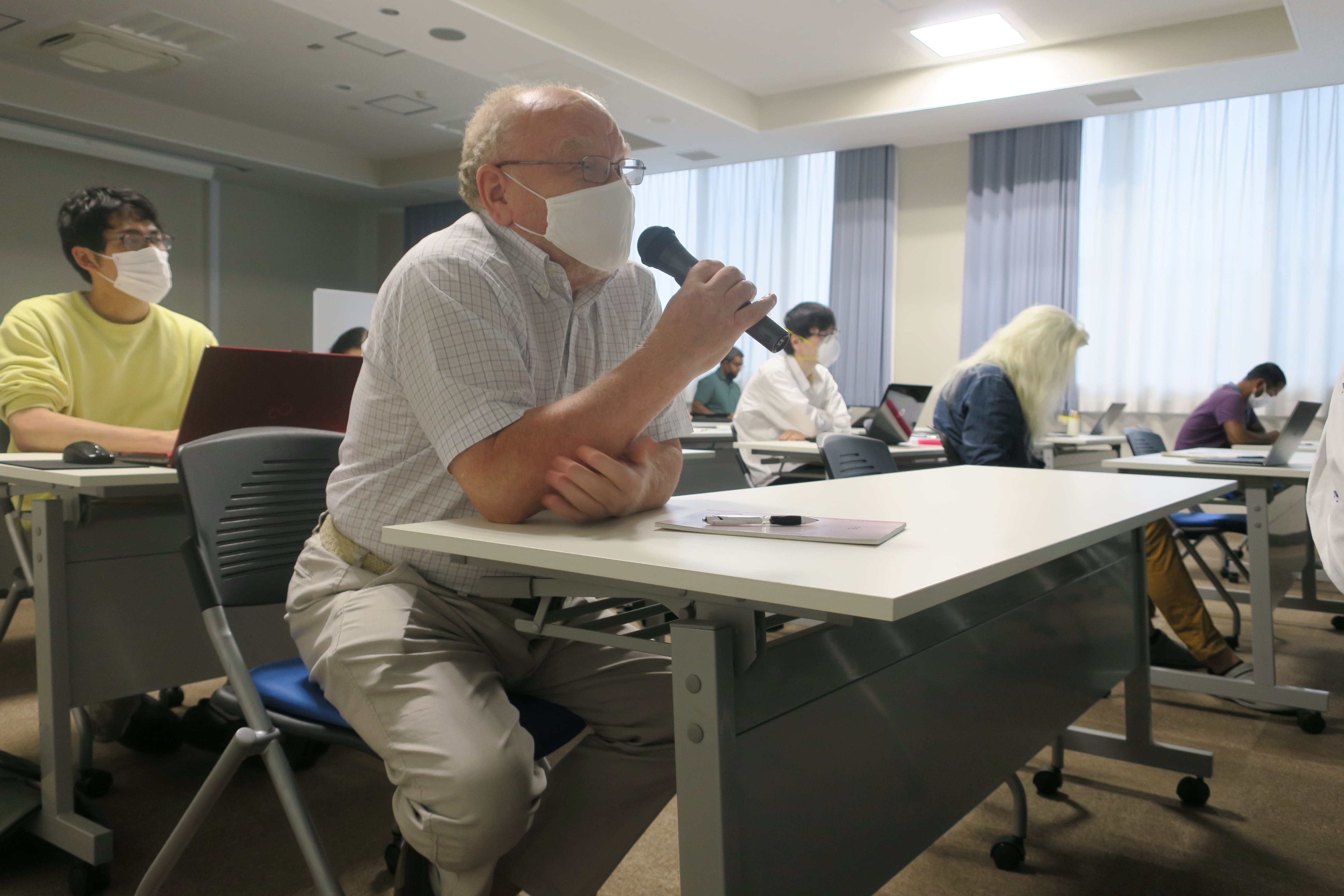 Questions and answers time
Questions and answers time
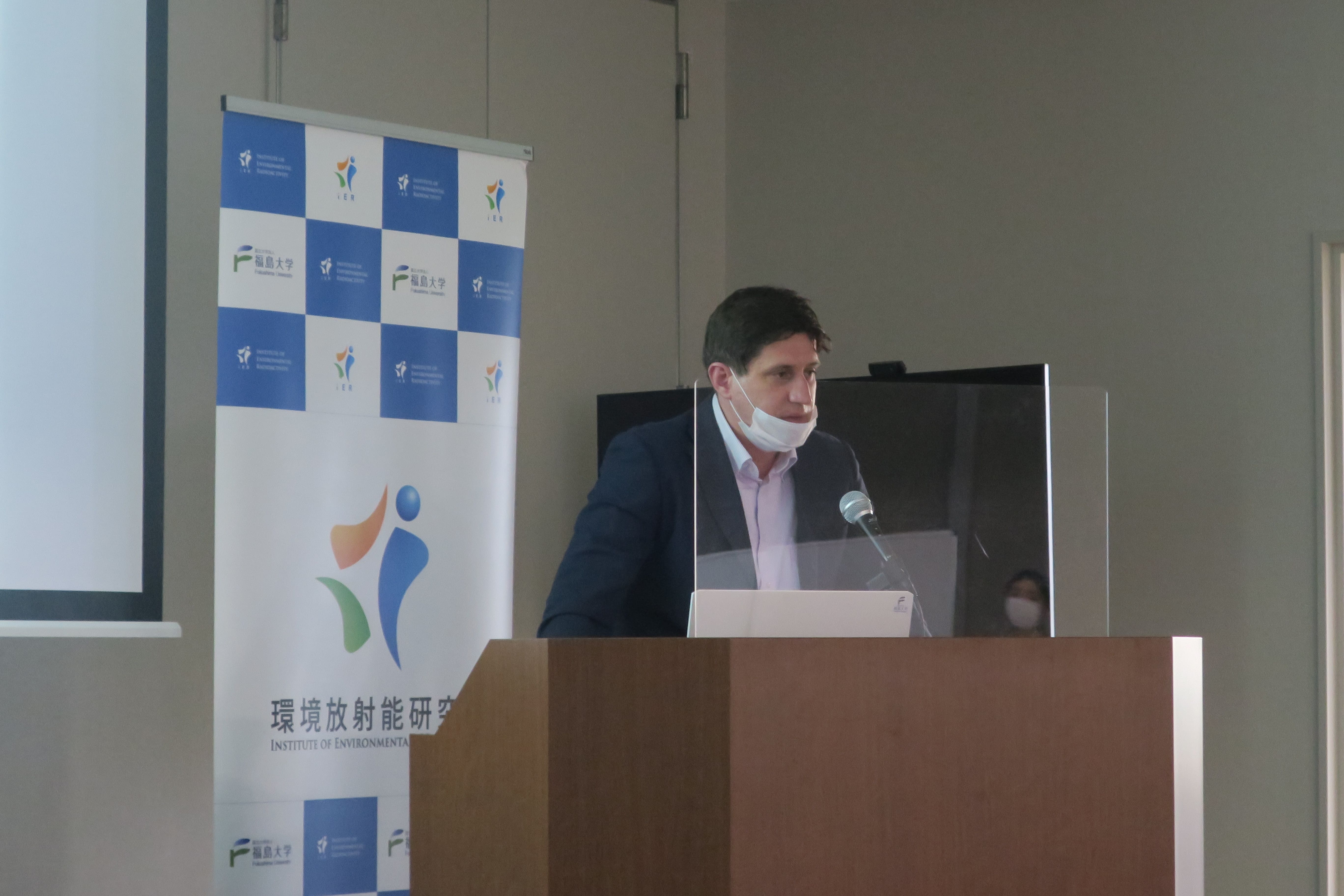 Project Associate Professor GUSYEV
Project Associate Professor GUSYEV
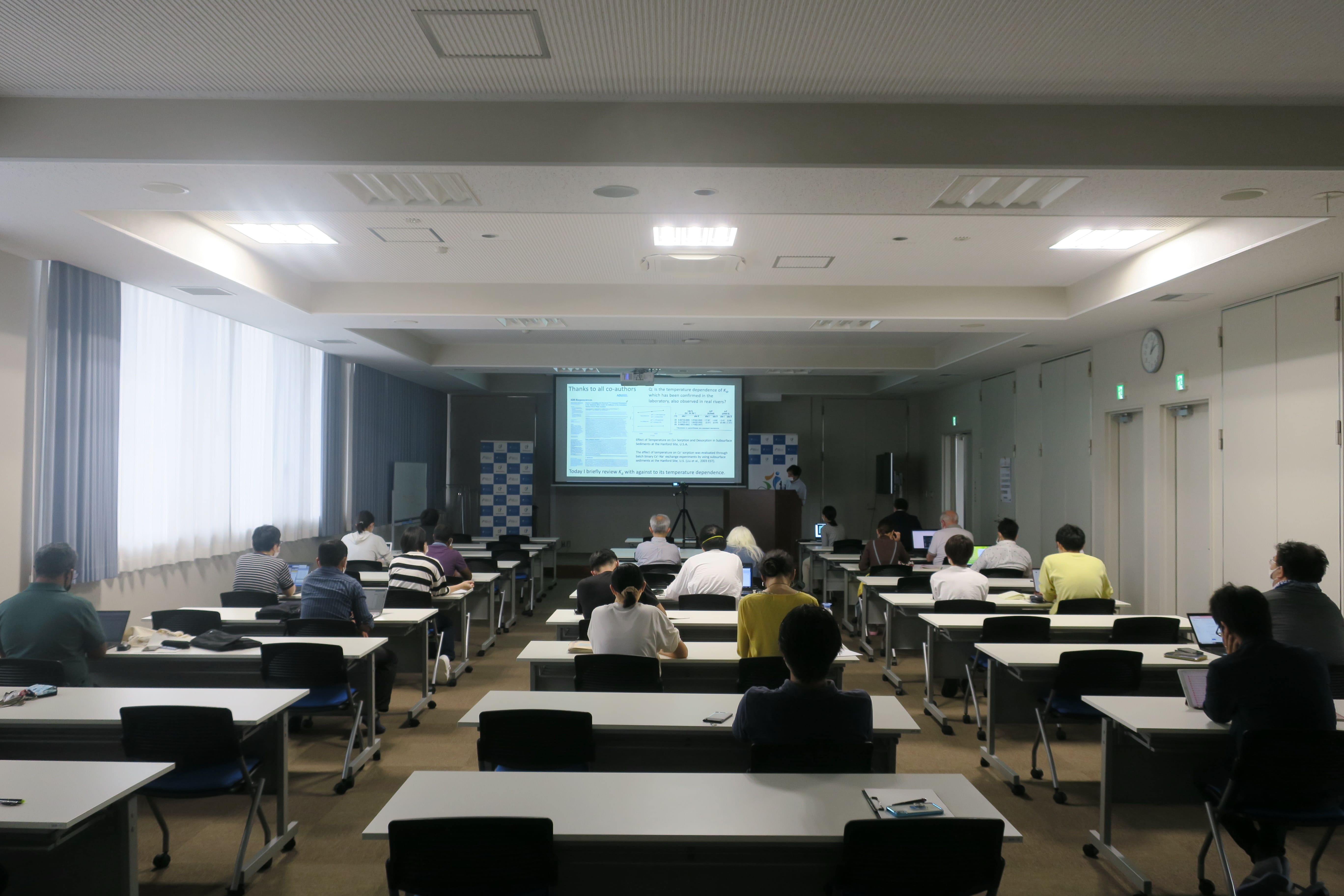 Overall view at the time of presentation
Overall view at the time of presentation
June 21, 2022 We held an IER Special Seminar online.<Dr.WATANABE>
| Date & Time: | Tue. June 21, 2021, 10:20 am ‒ 11:50 pm JST |
| Venue: | Online (Zoom) |
| Guest Lecturer: | Dr. Yoshito Watanabe, National Institute of Radiological Sciences, National Institutes for Quantum and Radiological Science and technology (QST NIRS) |
| Lecture Title: | Biological effects of radiation in Fukushima |
In some of the classes of the Master’s Program of Major in Environmental Radioactivity, distinguished external researchers are invited as guest lecturers, and their classes are open to other faculty members on campus as “Special Seminars”.
On June 21, the lecture on the subject “Effects of Radiation Exposure” by Dr. Yoshito Watanabe was attended by five IER graduate school students, and four IER members. Dr. Watanabe explained the basic mechanisms of radiation effects, external and internal exposures formed by radiation of different types (a-, b-, g-), deterministic and stochastic effects in humans, and the dependence of the species radiosensitivity on the interphase chromosome volume based on the results of the long-term g-field experiments. Further, Dr. Watanabe gave examples of radiation damages observed in plant and animal species in Chornobyl and Fukushima (Scots pine, Japanese red pine, Japanese fir, medaka fish, mice, etc.) and analyzed the dose dependencies of their chromosome aberration frequencies. In the Q&A sections, the details of the observations of radiation effects in mice in the Fukushima evacuation zones were discussed.
Click here to read the June 28 seminar article.「Charity Photo Exhibition Thinking of Ukraine」was held.
| Date: | Friday, April 15,2022- Monday, April 18,2022 |
| Venue: | HIROYA Garary in Shimizu, Fukushima City |
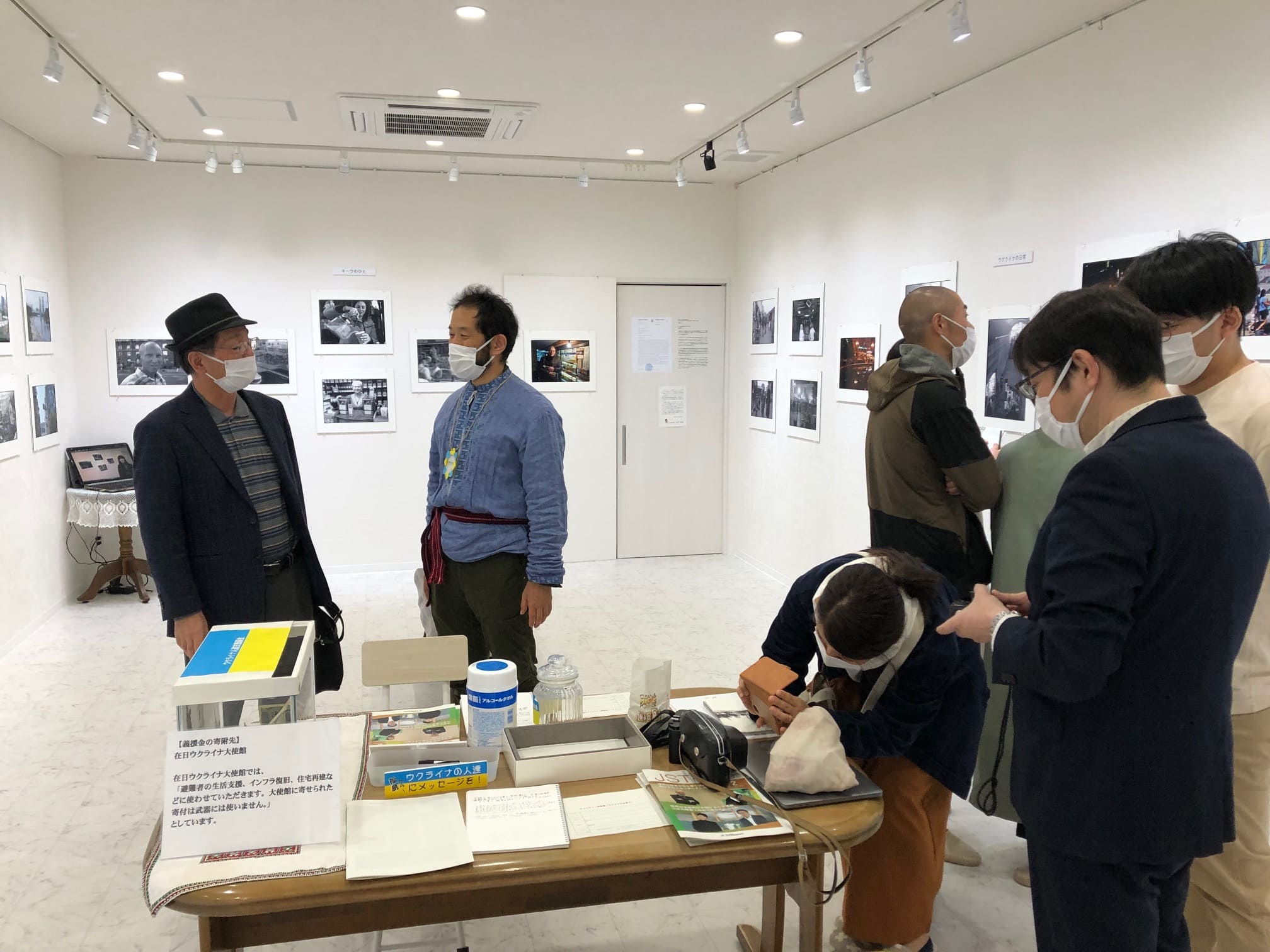 Charity Photo Exhibition at HIROYA Gallery
Charity Photo Exhibition at HIROYA Gallery
“Charity Photo Exhibition Thinking of Ukraine”
The Charity Photo Exhibition was held at HIROYA Gallery in Shimizu, Fukushima City from April 15 to 18.
During the four days of the exhibition, 295 people visited the exhibition and donated 502,945 yen. We would like to appreciate them for their warm support. The donations we received were donated to the Embassy of Ukraine in Japan to be used for supporting the daily lives of Ukrainian evacuees and for recovery and reconstruction of Ukraine during and after the war. His Excellency Dr. Sergiy Korsunsky, Ambassador Extraordinary and Plenipotentiary of Ukraine to Japan, wrote us a letter for our Charity Photo Exhibition. (The letter is shown below.)
All visitors looked at the photos of beautiful streets of Kyiv, kind and friendly Ukrainian people, and scenes of daily life in Ukraine, as well as the research activities conducted by SATREPS Chornobyl project. We believe that the visitors were able to feel the severity of the current war from the perspective of Ukrainian people.
Media coverage before and during the event led to a large number of visitors. Above all, it seemed that all visitors came with a desire to support Ukraine. Through the visitors, we were able to confirm that various places in Fukushima Prefecture are currently preparing to accept evacuees from Ukraine.
In addition, we received several offers to hold this photo exhibition in other locations: at Fukushima City communication space “Fukufuru” sponsored by Fukushima city from April 22(Fri) to May 8 (Sun), at the Koriyama City Hall from May 23 (Mon.) to May 30 (Mon.) and from June 10 (Fri.) to June 30 (Thu.). On campus, a photo exhibition is being held at the Fukushima University Library from May 23 (Mon.). We hope that these activities will lead to further continuation and expansion of support for Ukraine.
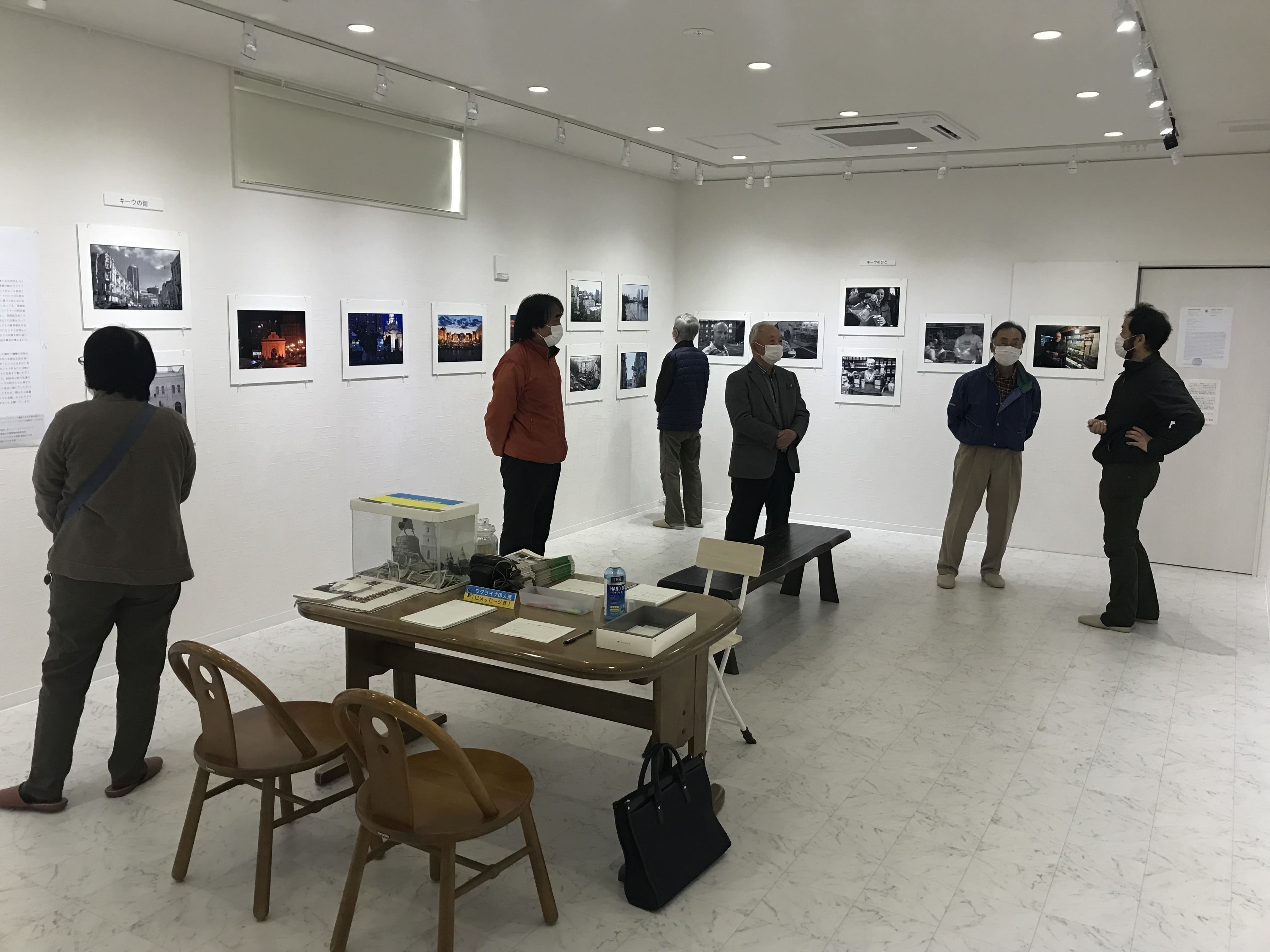 Charity Photo Exhibition at HIROYA Gallery
Charity Photo Exhibition at HIROYA Gallery
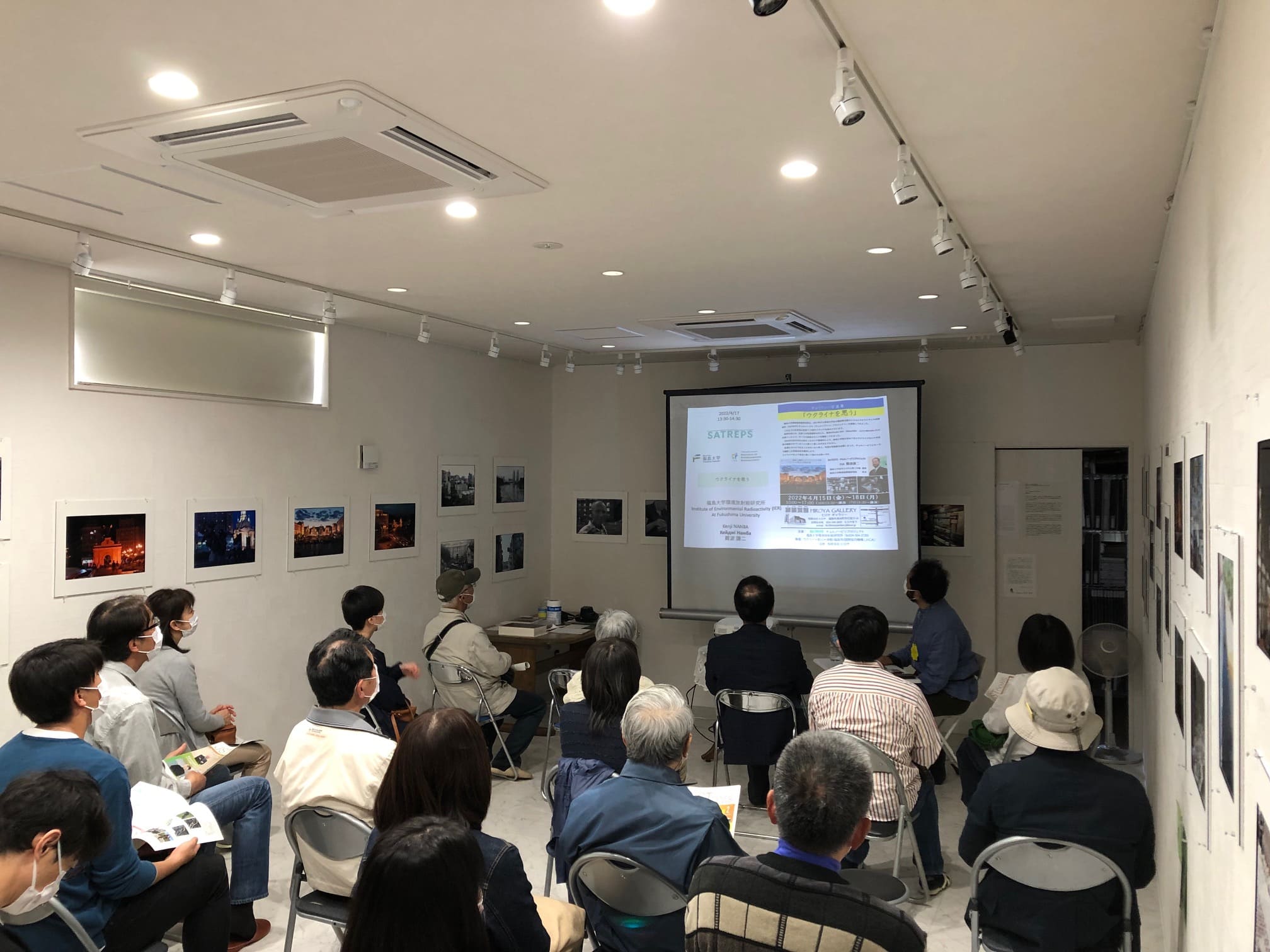 Lecture by Director Nanba
Lecture by Director Nanba
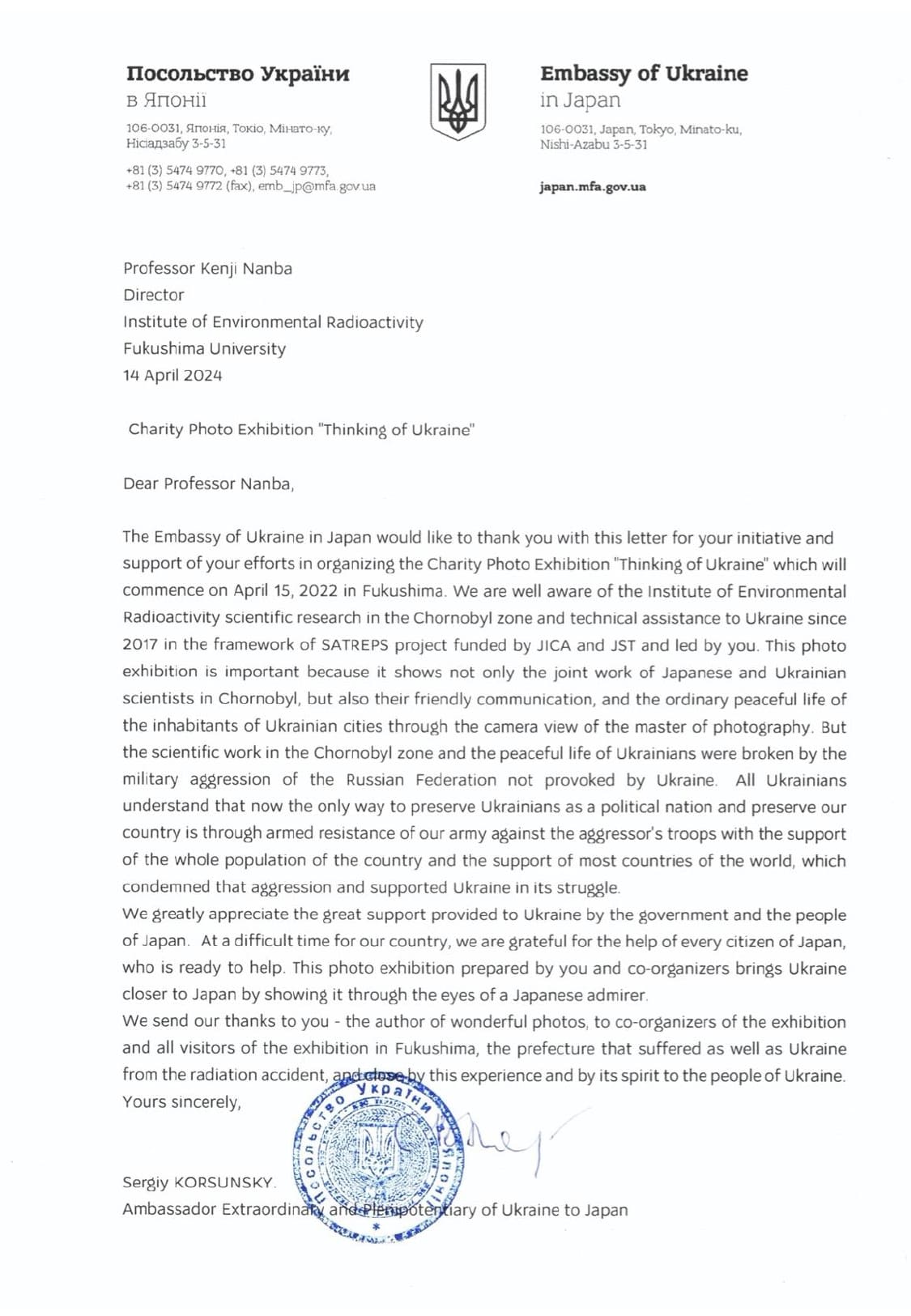 Letter from Ambassador KORSUNSKY
Letter from Ambassador KORSUNSKYto Director Nanba
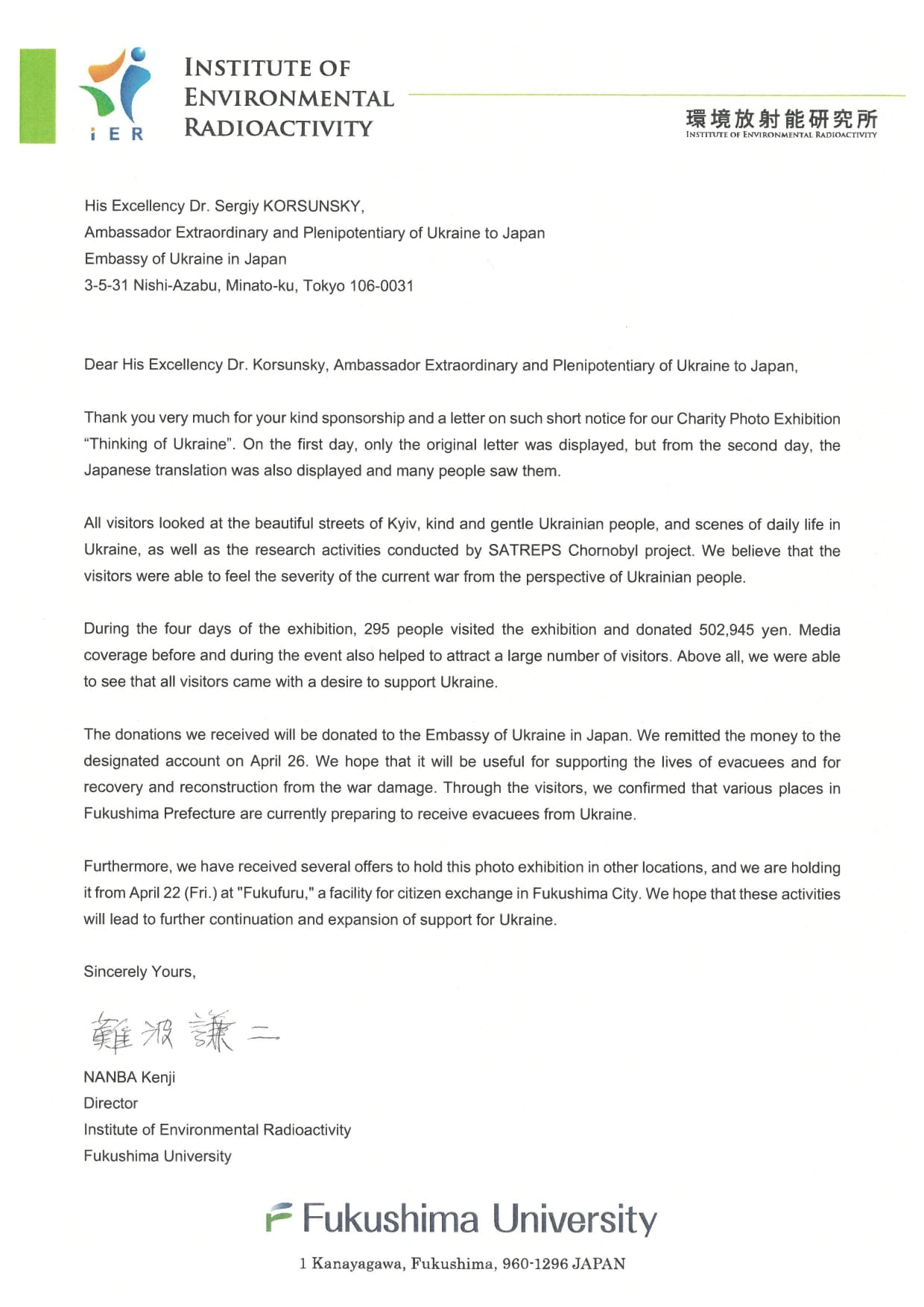 Letter of thanks from Director Nanba
Letter of thanks from Director Nanbato Ambassador KORSUNSKY
.png)
.png)
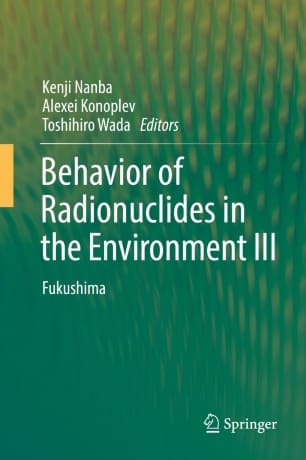
1024_1.png)
